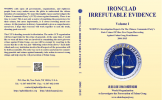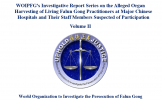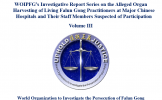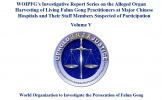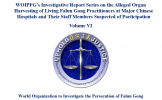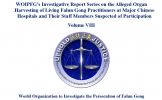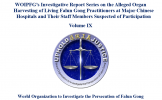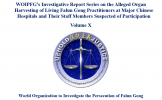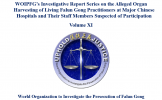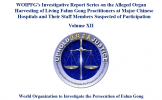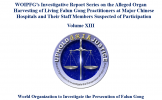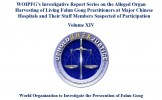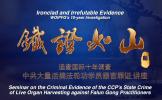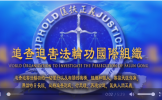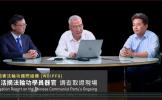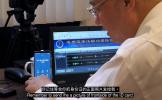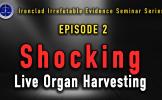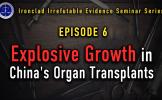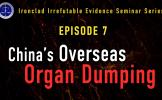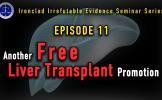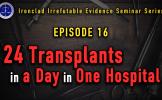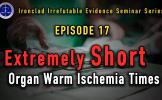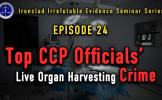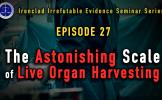Ironclad and Irrefutable Evidence
Irrefutable Evidence-DVD from WOIPFG on Vimeo.
Chinese version download:
Download Video: MP4 file (3.7GB) MOV file (11GB)
Download DVD Front cover: PNP file
Download DVD Box Cover: PNP file
Download Chinese PowerPoint:PowerPoint document
English version download:
Download Video: MP4 file (3.7GB) MOV file (11GB)
Download DVD Front cover: PNP file
Download DVD Box Cover: PNP file
Download PowerPoint: PowerPoint document
Table of Contents
Chapter 1: The Explosive Growth of China’s Organ Transplantation Industry Since 1999
I. The number of hospitalsthat perform liver transplantshas increased 20-fold
II. Annual national liver transplant surgery figures show anincrease of 180 to 436 times
Chapter 2: Existence of a Massive Living Organ Donor Pool
Evidence II: The percentage of emergency transplant operations is as high as 26.6%
Evidence III: Multiple back-up organs available for one transplant recipient
Evidence V: Organ harvesting suspected, warm ischemia time is either zero or exceedingly short
Evidence VI: Proof of murdering through live organ harvesting revealed in a medical paper
I. Working overtime for intensive organ transplants
Chapter 4: Since 2006, organ transplants have climbed steadily in China
I. The number of beds increases, the turnover rates are high, and the number of transplantsare huge
Chapter 5: The Estimated Scale of Transplantation in China
I. Estimation of transplant numbers from hospital data
II. Media reports validate the massive scale of transplants performed
V. The testimony of Yang Guang
VII. Examination of China’s transplant volumes
Chapter 6: The Claim that Organs are from Death Row Prisoners is a Lie
I. The number of death row prisoners far less than the organ transplant volumes
III. Only a small number of death row prisoners qualify to become organ donors due to health factors
Chapter 7:The Claim that All Organs Were from Donation in 2015 is a Lie
I. The organ donation system in China is actually in a paralyzed state, and has failed to function
III. Huang Jiefu claimed that the number of organ transplants in 2015 hit a new record
V. Crimes of harvesting organs from living Falun Gong practitioners continue
VI. The Current Situation of mainland Chinesedoctors’ savage live organ harvesting
Chapter 9: Live Organ Harvesting is A State Crime Ordered by Jiang Zemin and Carried Out by the CCP
I. Four types of evidence showing Jiang Zemin Personally Issued the Order
II. Strong incentives promoting the development of new transplant technologies
Chapter 10: Other Means through which Falun Gong Practitioners Have Been Subjected to Genocide
I. Wang Lijun and his human subject tests
II. The secret behind the world’slargest exporter of plastinatedhuman body specimens
Chapter 1: The Explosive Growth of China’s Organ Transplantation Industry Since 1999
Southern Weekend, a state-run newspaper in China, published an article in March 2010, titled “The Maze of Organ Donation: Visible Organs, Invisible Donors.” The article stated, “The year 2000 marked a watershed in China’s organ transplant industry… The number of liver transplants in the whole country in 2000 was 10 times that of 1999, and by 2005, the number tripled from that in 2000[1].” If the article’s data sources are accurate, the number of liver transplant operations had increased 30-fold in 6 years!
I. The number of hospitalsthat perform liver transplantshas increased 20-fold
As of April, 2006, the number of hospitals capable of performing liver transplant surgeries in China had increased sharply to 500, compared with just 19 prior to 1999.This was an increase of 20-fold from 1999 to 2006.

Figure 1.1 the number of hospitals in China capable of performing liver transplants
II.Annual national liver transplant surgery figures show anincrease of 180 to 436 times
In the more than two decades leading up to 1999, only 135 liver transplant cases were performed in mainland China, averaging 5 to 6 cases per year. During the 8-year period from 1991 to 1998, Chinese hospitals performed a total of 78 liver transplant surgeries, averaging 9.7 cases per year. By contrast, during the 8 years from 1999 to 2006, an astronomical 14,085 liver transplant surgeries were carried out in mainland China, with an average of 1,760 cases per year. This was a 180-fold increase in liver transplant surgeries.[2]
Here is an almost inconceivable fact:After the CCP’s crime of organ harvesting from living Falun Gong practitioners was exposed in 2006,at a time when the CCP was under close scrutiny from the international community, mainland China still conductedat least 4,231 liver transplantoperationsbetween June 24, 2006 and June 24, 2007.[3] This was 436 times the average number of liver transplant surgeries from the period 1991-1998.

Figure 1.2 Annual liver transplant surgeries in China 1977-2005
III.Examples of Hospitals with Explosive Growths in Organ Transplants
1. Tianjin First Central Hospital’s organ transplant increase of over 300 times
In May 1994, the hospital performed its first liver transplant operation. From 1994 to 1999, during 5 years, this hospital performed only 8 liver transplants.[4]However, in 2004, it performed 507liver transplants.[5] In 2005, there were 647 cases of liver transplants performed, as well as 436 cases of renal transplants.[6]Comparing the numbers of transplants before and after 1999, there was an increase of more than 300 times.
2. The First Affiliated Hospital of Zhejiang University School of Medicine’s organ transplant increase ofover 70 times
This hospital completed two cases of orthotropic liver transplantation in a 4-year span, from 1993 to 1997. During more than two years, from January 2000 to September 2, 2002, it performed 103 cases of orthotropic liver transplantation. [7] If we compare the organ transplant numbers conducted over the same length of time in both time periods, we saw an increase of over 70 times.
Please note that these are the figures made public by the CCP. The actual numbers would be more astonishing. For example, according to WOIPFG’s investigation, the number of ward beds for organ transplant patientsin Tianjin First Central Hospital was increased to500 in September 2006. Over 5,000 cases of organ transplants have been taking place every year,and nearly 8,000 cases would be performed on a yearly basis during the peak period. The hospital’s liver and kidney transplant number increased to be 3,000 times of the average annual number of organ transplants prior to 1999.
Formore details, please read WOIPFG’s investigative report:http://www.upholdjustice.org/node/338
Chapter 2: Existence of a Massive Living Organ Donor Pool
Normally, Transplant Recipients Wait 2-3 Years for Organs to Become Available
Tissue type matching for transplant operations of a major organ has a very low success ratio under normal conditions. Data from the International Society of Nephrology indicate that the chance of finding a matching donor, who is not a family member of the patient, sis 6.5 percent. This means that the probability of finding a matching donor is 1 out of 15.
A report on the official Xinhua Net dated March 24, 2012,said that the former U.S. Vice President Dick Cheneyreceived a heart transplantafter being on a waiting list for nearly two years.
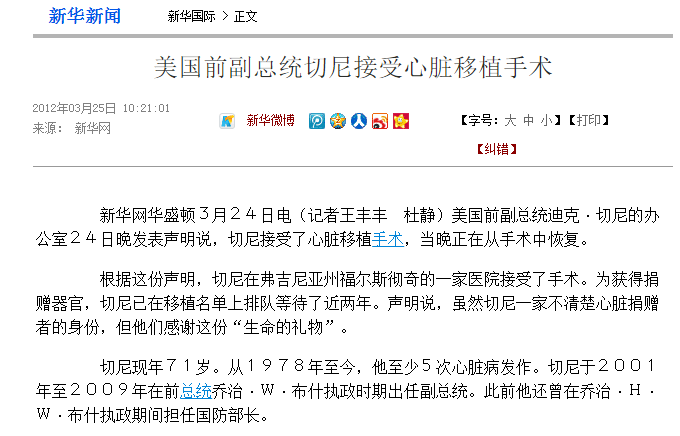
Figure 2.1 News article about former U.S. Vice President Dick Cheney receivinga heart transplant
The US has an extensive organ donation network with more than 120 million people registered as voluntary organ donors. Even so, the average wait time for a liver transplantation is three to seven years, according data cited byan article in the New York-based Metro newspaper, on March 29, 2006.
According to areport by theUnited States Department of Health and Human Services in 2007, the average waiting time for a liver and kidney in the United States is two and three years respectively. [9]
Evidence I: Reverse matching in China, organs are waiting for patients,the average waiting time is 1-2 weeks
A strange phenomenon appeared after 1999 in China’s organ transplant industry,the waiting time for transplant organs became extremely short and the country had an oversupply of organs.
There appeared to be so many donors that China alone couldn't use them all. Hospitals in China started marketing and promoting organ transplants to patients all over the world. Tens of thousands of foreign“transplant tourists” have traveled to China for transplant operations, because the average waiting time for an organ can be 2-4 weeks, and sometimes even as short as 1-2 weeks. The phenomenon of available organs waiting for transplant patients to show up, and the world’s only cases of reverse organ matching has emerged.
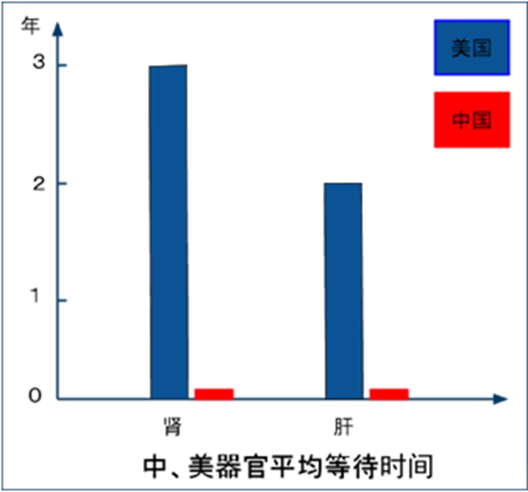
Figure 2.2 The average waiting time for transplant organs in China (red) and in the U.S. (blue)
1. The average wait time in China is 1-2 weeks
1) Shanghai Changzheng Hospital Transplant Center clearly states on its liver transplant application form that the average waiting time for a liver transplant is one week.
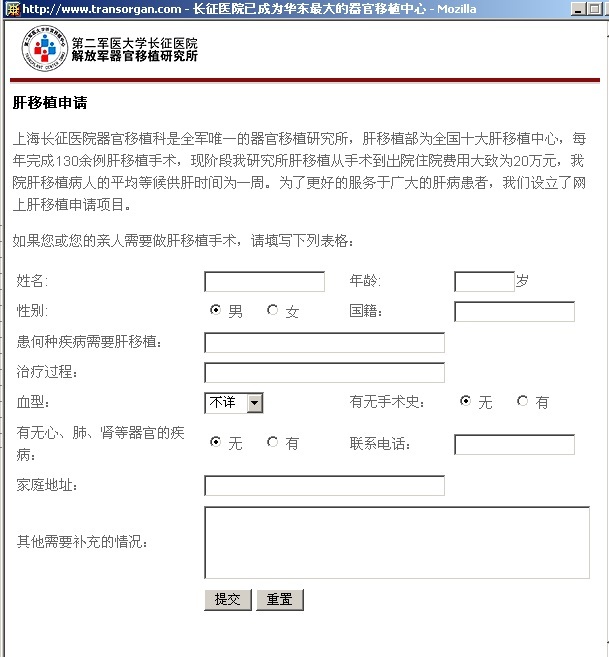
Figure 2.3 Online liver transplantapplication form of the Organ Transplant Center at Shanghai Changzhen Hospital
2) Oriental Transplant Center of Tianjin First Central Hospital–the average organ wait time was two weeks
The official website for the Oriental Transplant Center of Tianjin First Central Hospital stated that the center completed 647 liver transplant surgeries in 2005, and the average wait time was two weeks. The web page has since been removed, but WOIPFG investigators recovered a cached copy.[10]
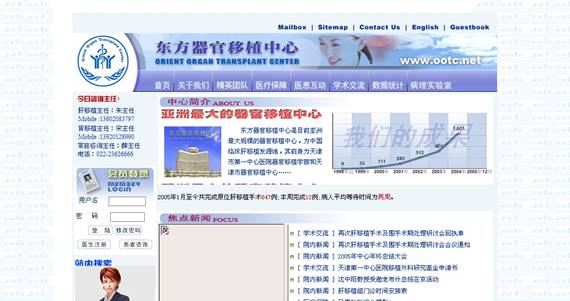
Figure 2.4 The Oriental Transplant Center claimed that the average waiting time was two weeks in 2005
3) If any problem arises at the last minute with the organ donor, hospitals in China are able to source a replacement organ easily and the surgery can be performed within one week
The International Transplantation (China) Online Support Center of The Chinese Medical University in Shenyang offers a special service: If any problem with the provided donor organ is discovered at the last minute, the center would find another matching donor and perform another surgery within one week.
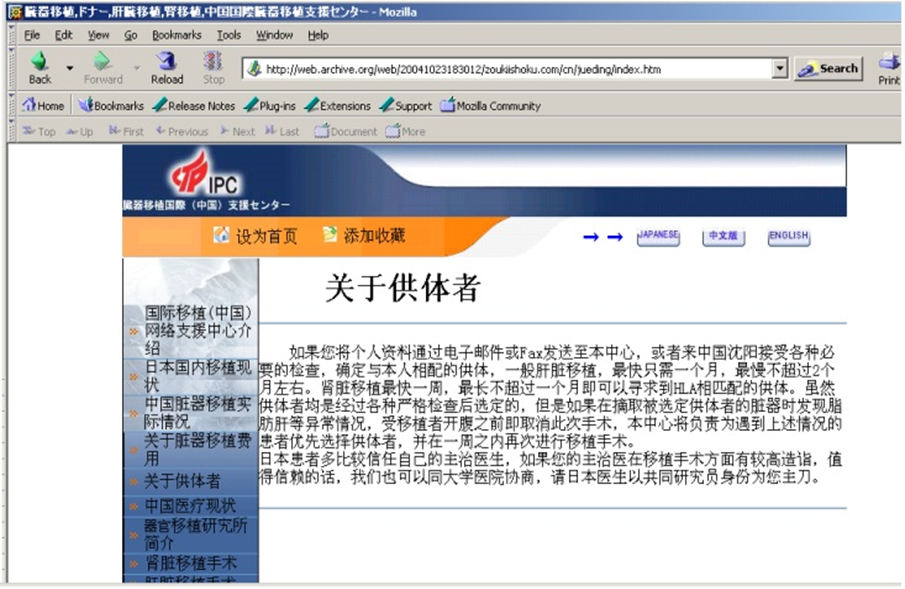
Figure 2.5 International Transplantation (China) Online Support Center
2. Audio recordings of phone investigation
1) “We have plenty of donors, so we can still select the ones that are young and good”
On June 26, 2015, (8613623711903), Dr. Chen Yongfeng from the Organ Transplant Department at Zhengzhou People’s Hospital told a WOIPFG investigator that they have plenty of donors, “We can select a good and relatively young liver. We have plenty of donors, so we can still select the ones that are young and good. It is hard to say if that will be the case down the road.”(Recording Download:MP3,Transcription:Appendix 1)
Appendix 1: http://www.upholdjustice.org/node/330#_Toc1)
2) The waiting time for a donor at that hospital is from 2 to 3 days to about 10 days.
On June 25, 2015, (8637163933151), a doctor-on -duty at the Department of Hepatobiliary Surgery of Zhengzhou People’s Hospital told an investigator, “The shortest wait time for a donor is approximately 2-3 days, in general. The longest would be over 10 days. The cost is about 500,000 yuan (approx. USD 78,000). We have a lot of donors.” When being askedwhy their wait time was soshort and aboutthe source of their donors, the doctor replied, “For this matter, um, I cannot provide any answers. I can’t. Don’t ask. Don’t ask these questions. The organs are directly sent to our operating rooms every day, one or two operations every day, guaranteed.” (Recording Download:MP3,Transcription:Appendix 2)
Evidence II: The percentage of emergency transplant operations is as high as 26.6%
An emergency liver transplant is anurgent liver transplant operation performed on patients with acute, serious liver problems and less than 72 hours to live. Due to the difficulty of urgent tissue typing and the extended waiting time for a donor, emergency liver transplant operations are rarely performed outside of China. In China, however, emergency liver transplantshave become a common operation since 1999. Here are some examples:
1. The percentageof emergency liver transplants is as high as 26.6% of all liver transplants
According todata from The 2006 Annual Report on China Liver Transplant Registration[11], 8,486 cases of liver transplantswere performed in 29 transplant centersfrom April 6, 2005, through December 31, 2006. Of these, 4,331 cases had specified whether or not the case was an emergency transplant, indicating a total of 1,150 emergency liver transplants performed, equivalent to 26.6% of those cases!
2. One hospital performed120 emergency liver transplants within three years
Changzheng Hospital, an affiliated hospital of the Second Military Medical University, performed 120 emergency liver transplant operations during the three years from 2003 to 2006. The shortest wait time for receiving a transplant after the patient was admitted was four hours.[12]
3. Twokidney transplantsperformed on the same patient within 48 hours
Getting a new kidney is as easy as buying a pig’s kidney in mainland China, according to a Huaxia Times article published on May 17, 2006
According to the Huaxia article, Han Xiuwu, the chief physician at Beijing Haidian Hospital’s organ transplant center,completed two kidney transplant operations on the same patient within 48 hoursin December 2004. The first operationfailed due to hyper-acute rejection,so Han conducted the second kidney transplant the following day. [13]
According to the report, this case was widely discussed by people, “In other countries, patients usually have to waita few years for a precious kidney. But Haidian Hospital could obtain kidneys as easy as if they were pigs’kidneys. The first donor kidney was acquired within nine days. As for the second kidney, they could just go and get it. Isn’t it strange?”
4.“Some patients would come at night, and we could do the operation over the same night. It's pretty common here.”
On March 19, 2015 (8637166862192), Dr. Li Gongquan, a liver transplant physician at the First Hospital Affiliated with Zhengzhou University, told a WOIPFG investigator over the phone: “[We could do it] within one week, if you like, we’ll go ahead and do the type matching,” and, “Some patients would come at night, and we could do the operation over the same night. It’s pretty common here.” (Recording Download: MP3, Transcription: Appendix [14])
Evidence III: Multiple back-up organs available for one transplant recipient
1. One kidney transplant patient was matched against eightdonor kidneys
According to a People’s Daily Online article, Tan Jianming, director of the Shanghai Organ Transplant Medical Center,performed more than 4,200 kidney transplants by June 2014. [15]
In 2003, Tan performed a kidney transplant at the Shanghai First People’s Hospital. Prior to the transplant operation, over the course of more than two months, the physician had performedtissue-matching tests for the patient with eight back-up kidneys. The first seven tests failed due to the patient’s antibody rejection. The eighth kidney was matched successfully and the operation was performed.
2. A more startling example is that HUANG Jiefu used three living persons as the backup donor livers for his performing liver transplantation surgery
According to articles from official state-run media www.xinhuanet.com reprinting from www.xjbs.com.cn , www.sina.com reprinting from Urumpi Evening News, Today’s Nurse periodical, and Phoenix Weekly, on 28 September 2005 the then-Vice Minister of Health HUANG Jiefu accompanied Luo Gan, the then-Secretary of the CCP’s Central Politics and Law Committee, to attend the 50th anniversary celebration of the establishment of Xinjiang Uyghur Autonomous Region, in meantime he demonstrated an autologous liver transplantation surgery at the First Affiliated Hospital of Xinjiang Medical University. Huang used three backup donor livers for his surgery and it is analyzed that the three donor livers are suspected of three living persons,
Phoenix Weekly reported that " HUANG Jiefu found after opening the abdominal cavity of the 46-year-old patient named YAO Shufa with liver cancer (the Issue 4 of Today's Nurse reported that the patient named YAO Dongqiang[i]) that the liver's condition was suitable for autologous liver transplantation which he dreamed for, so he cut off the patient's liver and removed the cancer tissue, then transplanted the liver back to the patient."
HUANG Jiefu asked other surgeons to close the incision and he immediately contacted the First Affiliated Hospital of Sun Yat-Sen Medical University in Guangzhou and the Southwest Hospital of the Third Military Medical University in Chongqing to ask them to provide a backup donor liver respectively in case of the failure of the surgery. "At 6:30 pm of September 29 one matching backup donor liver was brought there by Chongqing part! Another one was urgently brought to Xinjiang by three medical staff of the First Affiliated Hospital of Sun Yat-Sen Medical University with necessary medical equipments!" [ii] The article www.xinhuanet.com reprinting from www.xjbs.com.cn reported: "three medical staff of the First Affiliated Hospital of Sun Yat-Sen Medical University urgently brought necessary medical equipments and one liver to Xinjiang! " In meantime Xinjiang part urgently found a matching donor liver too. [iii]
Huang’s surgery lasted from 7:00pm of September 29 to 10:00am on September 30. After 24 hours of observation, Huang announced that the surgery was successful. The back-up livers were no longer needed[iv]. By then, 39 hours had passed.
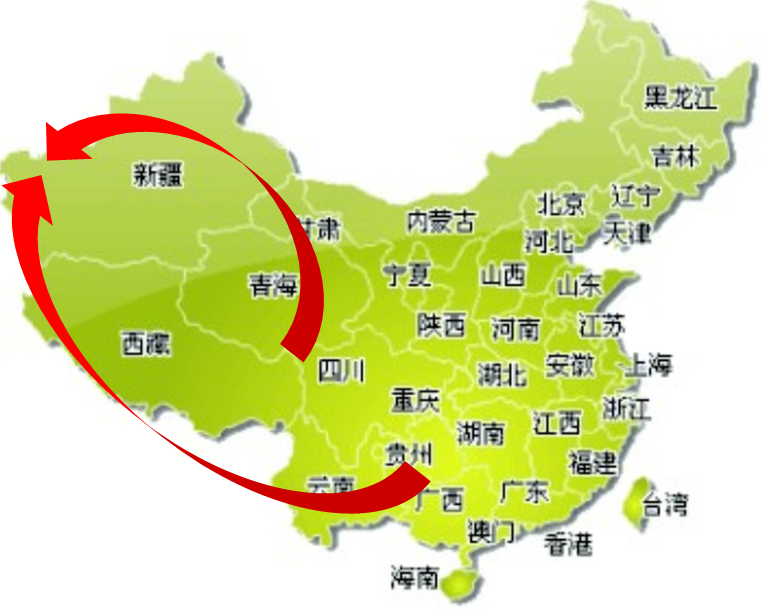
Figure 2.6 The Horrific Inside Story of Human Organ Market in China, Phoenix Weekly, November 2013
3. Analysis and Arguments
According to Technology Management Specification of Liver Transplantation released by China’s Ministry of Health in 2006, the cold ischemia time of donor liver cannot exceed 15 hours.
1)The two backup donor livers from Chongqing and Guangzhou could only be two living persons because of the time limit for cold ischemia. It would take over 60 hours from the moment that the donor livers from Chongqing and Guangzhou were shipped out to the time of the confirmation of the success of the autologous liver transplantation, and the extracted livers could have already been useless.
2) The backup liver found in Xinjiang was also a living person. Due to the limit of cold ischemia time and emergency surgery requirements, it must be a standby living person whose organ can be extracted at any time when the surgery needs.
3) A bank of living donors who are specially detained exists outside of China’s justice system. In other words, there are a group of people who exist outside of justice system and can be slaughtered at any time to obtain their organs for organ transplantations.
The execution of a death row prisoner must strictly comply with the law. The time and location of the execution must be in accordance with written documents issued by the Supreme Court; at the time of the execution, officials from the court and the procuratorate must be on site to perform a positive identification of the prisoner; the positive identification procedure is repeated after the execution is carried out. However, regarding Huang’s operation, medical staff from Chongqing and Guangzhou could bring the living persons to the destination by air, which proves that the two liver donors are specially detained and exist outside of justice system.
4) The organ banks of living persons are suspected of existing nationwide and the number of detained persons is huge. HUANG’s organ deployment from different provinces and cities indicates that the organ banks of living persons very widely spread all over the country. From the probability of organ matching and the speed of successfully finding backup donor liver from two cities, the number of living organ donors especially detained is huge, which has been proved by the account of their operation inadvertently revealed by CCP's official medias.
Evidence IV: Many hospitals conduct multiple transplant operations at the same time. In one hospital, 24liver and kidney transplantswere conducted in one day
Our investigation suggests that many hospitals can conduct several, oras many as several dozen, kidney and liver transplant operations on the same day, or even at the same time. And this phenomenon of “more than 10 transplant operations on a single day”has been a long-term routine at many hospitals, where the surgeons are too busy to even have a day off. Under normal circumstances, it would be impossible to simultaneously find so many donors with aclose tissue match. But since 1999, this has been a common phenomenon in China.
1. Xinqiao Hospital of Third Military Medical University once performed 24 kidney transplant operations in one day[18].
2. Tianjin First Central Hospital once performed 24 liver and kidney transplant operations in one day[19].
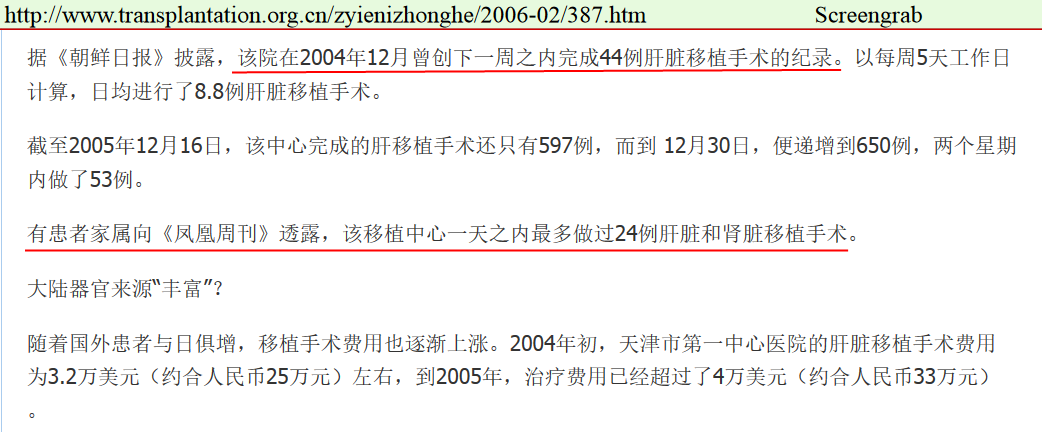
Figure 2.7 Snapshot of China Organ Transplantation Webpage
3. The First Affiliated Hospital of Sun Yat-Sen University performed 19 kidney transplant operations in one day[20]
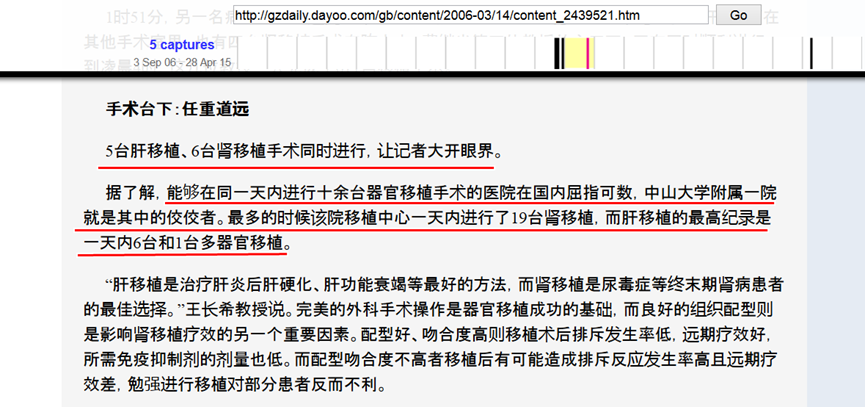
Figure 2.8 Snapshot of Guangzou Daily Webpage
4. Xiangya Hospital performed 17 transplant operations in one day
According to Xiangya Hospital’s website,on May 26, 2005, the hospital performed one liver, six kidney and eight corneal transplants.[21]On Sept. 3, 2005, the hospital conducted seven heart-liver-kidney transplant surgeries.[22]On Apr. 28, 2006, the organ transplant center finished 17 transplant operations in one day: two liver transplants, seven kidney transplants and eight corneal transplants.[23]
5.General Hospital of Jinan Military Region once performed 16 kidney transplant operations in 24 hours[24]

Figure 2.9 Snapshot of Dazhong Webpage
The following is an even more startling case:
6. Fuzhou General Hospital of Nanjing Military Region found five matching livers at the same time and same place, and subsequently completed five liver extraction and transplant operations.[25] Of the five operations, one was an emergency operation.
On March 10, 2014, China Organ Transplantation website published an article originally reported bySoutheast Expresstitled “Completed 5 liver transplant operations within 17 hours”. The article said thatFuzhou General Hospitalconducted five liver transplants from 12pm on February 18, 2014, to 4am on February 19, 2014. Two of the patients that received the organ transplants had chronic severe liver failure, one had acute liver failure with hepatitis B, one had giant hepatic cancer, and one had severe liver failure withmultiple biliary tract surgeries.[26]
According to the article, the five patients had been admitted to the hospital and were waiting for livers, and “five matching livers had already been found but could only be extracted five minutes after the donors’ heart stopped beating.” Apparently,the “donors” were still alive with functional livers while the livers were being matched to the recipients. Therefore,after the five patients had been admitted to the hospital, they were not waiting for suitable organ matching, but instead for the death of the organ “donors”.
Under normal conditions, the probability of anorganfrom a non-relative of a transplant recipient matching is 6.5 percent, and the average waiting time in U.S. fororgan transplant operationsistwo years for a liver, and three years for a kidney.One medical professional in the United States oncesaidthat under normal circumstances, “getting a healthy organ is as hard as picking a star in the sky.”
It was implausible that the five "organ donors" were found in the same place and at the same time, and on the same day they all went into "cardiac arrest," and that their organswere extractedat the same time and sent to the same hospital, Fuzhou General Hospital. The hospital then spent "17 hours completing the five liver transplant operations." What's more, one of the patientsreceived an emergency transplant, where the matching organ had been found given extremely short notice.
In order for this scenario to be possible, China must have a massive pool of healthy captives that are imprisoned collectively. These captives must have already undergone all the matching tests required for organ transplant operations. This would explain why hospitals are able to get matching organs within such extremely short time frames: captives with matching organs are being slaughtered.
Please note: these five transplant operations happened on Feb. 18, 2014, more than eight years after the horrible truth of organ harvesting from living Falun Gong practitioners by the CCP wasfirst exposed ininternational media in 2006. For a long time, the CCP has deliberately misled the international community into believing that organ transplant numbers dropped after 2006. But the CCP continues to harvest organs from Falun Gong practitioners on a massive scale. In 2014, through online articles alone, we found 42 hospitals that had been conducting multiple transplant operations simultaneously.
(Refer to Table 2.1 List of online articles revealing that 42 hospitals engage in multiple transplant operations on a large scale)
(http://www.upholdjustice.org/node/360)
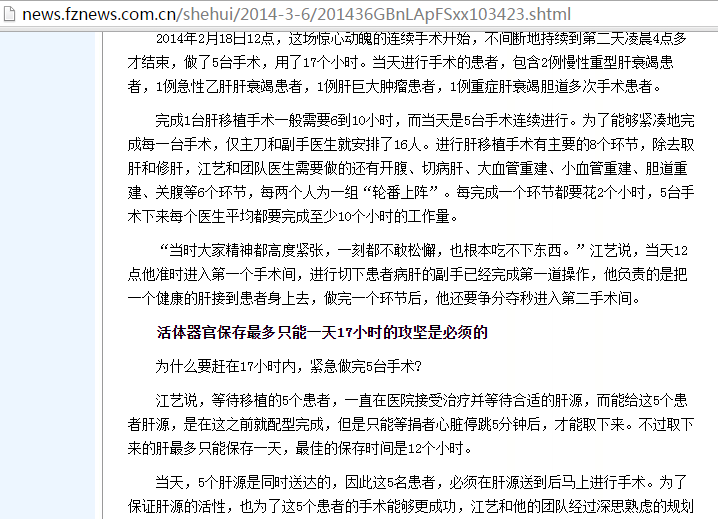
Figure 2.10 On March 10, 2014, China Organ Transplantation website reprinted an article by Southeast Express Newspaper
Evidence V: Organ harvesting suspected, warm ischemia time is either zero or exceedingly short
Our investigation showed that many organ transplant operations performed in China had either no or exceedingly short warm ischemia times, indicating that the donors for these operations werestill alive when their organs were extracted.
1. What is warm ischemia time?
Warm ischemia time is the period of time from the moment the donor stops supplying blood to the organ to the start of cold perfusion.[27]
2. What's cold ischemia time?
Cold ischemia time (CIT) is the period between the chilling of an organ after its blood supply has beencut off and the timeits blood supply is restored during transplantation.[28] The time limit for cold ischemia time for akidney must not exceed 24 hours; [29] liver mustnot exceed15 hours; and a heart must not exceed6 hours.[30]
3.What is cardiac death?
Cardiac death generallymeans the heart stops beating, and breathing and circulation stop as well.
4. What is brain death?
Brain death means a full irreversible loss of brain function including the brainstem. Clinical determination of brain death must include three indispensable indicators: deep coma, brain stem reflexes and no spontaneous breathing.
5. All organ extractions from brain dead donors in mainland China are illegal
To this day, China does not have a uniform set of national criteria issued by the administration on what constitutes brain death. Likewise, there is no legislation on brain death. Therefore, as of the writing of this article (Jan. 7, 2016), according to China’s laws, any action oforgan extraction from a brain-dead cadaveris illegal.
6. In summary, the warm ischemia time being either zero or exceedingly short indicates organ harvesting from living candidates:
1) In cases where death is caused by an accident, warm ischemia time–from the moment the donor stops supplying blood to the organ to the start of cold perfusion–is often longer; zero ischemia time is impossible.
2) When using organs from executed prisoners, strictly speaking, warm ischemia time should not be zero either. Because execution should follow the judicial process where organ extraction should only occur after the medical examiner has inspected the body and pronounces the prisoner dead. Therefore, the warm ischemia time should not be zero either.
3) In cases of brain dead donors, organs can be obtained with zero or exceedingly short warm ischemia time. However, China has no brain death legislation, lacks a set of criteria that define brain death, and does not have an organ donation system in place. So basically there are no "brain dead donors."
7. “Kidney transplant from living donors” in China is “completely different” from the cadaveric kidney transplants conducted in Japan
The following is the online response from China International Organ Transplantation Support Center of China Medical University:
“The kidney transplant procedure from living donors conducted in China is completely different from the cadaveric kidney transplant operation you’ve heard of in Japan’s hospitals or dialysis centers.”[31]
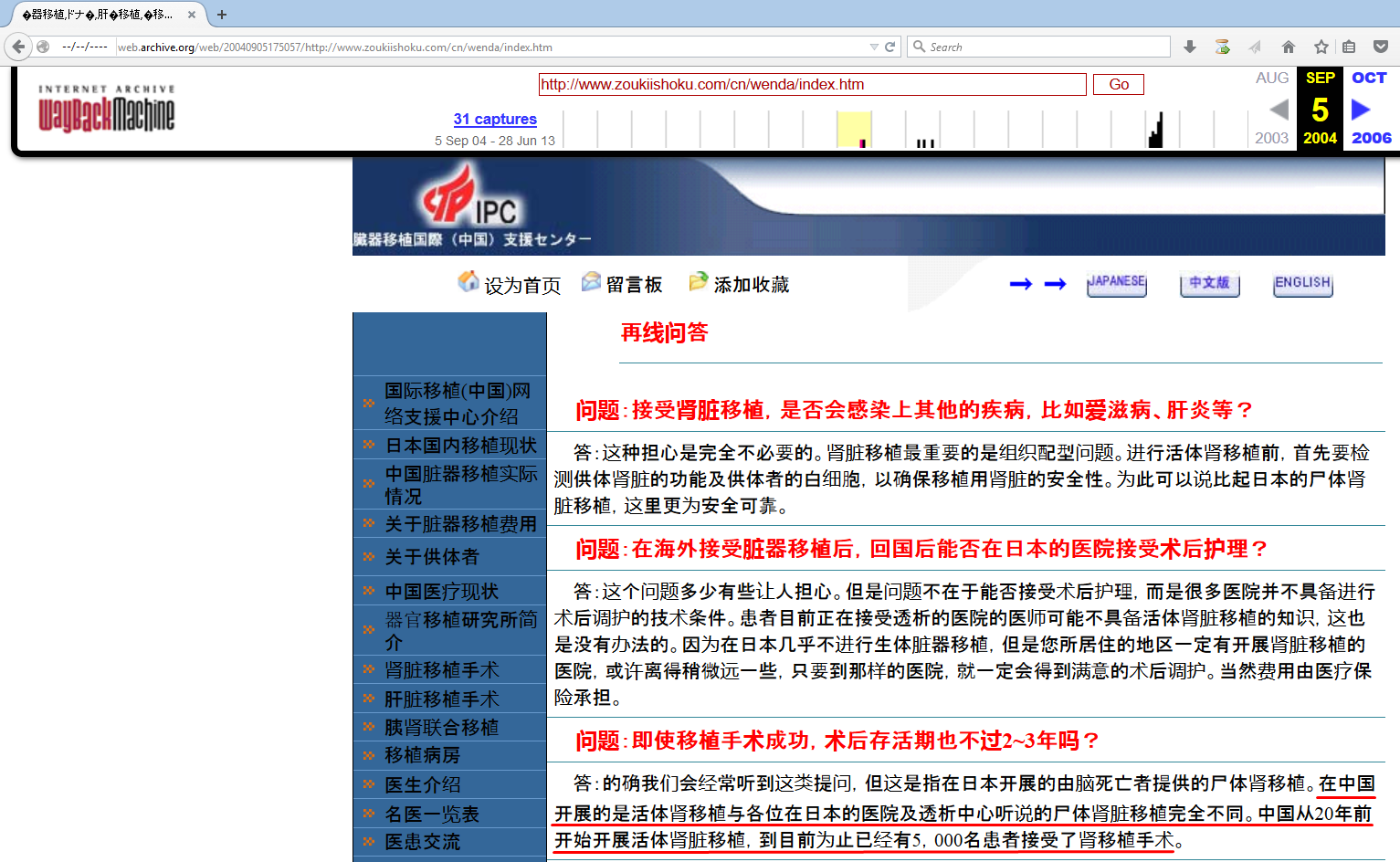
Figure 2.11 Support Center of China International Transplantation Webpage cache
8. Examples of research papersby physicians in mainland China where zero or exceedingly short warm ischemia timesare recorded:
1) At Nanjing Drum Tower Hospital, 314 liver transplants implemented, with their warm ischemia times being 0-2minutes[32]
2) At the PLA Second Artillery Force General Hospital, from 2004 to 2007, 103 donor livers from “healthy young people’s cadavers” had warm ischemia times of 0 to 5 minutes.[33]
3) At the Second Military Medical University-affiliated Changzheng Hospital in Shanghai, from 2001 to 2004, 240 donor livers had warm ischemia times of 0 to 8 minutes.[34]
At the Affiliated Hospital of Nanjing Medical University, from 2005 to 2007, 112 donor livers’ warm ischemia times were between 0 and 10 minutes, with an average of 3.96 minutes.[35]
Table2.2 33Selected Cases of Extremely Short Warm Ischemia Time
|
Hospital Name |
Time of Transplants |
Warm ischemia Time of Removed Organs |
|
1. The Affiliated Union Hospital of Fujian Medical University |
August 1995 - October 2007 |
111 cases ofheart evisceration where all donors were brain dead, aged at 25±7; no history of cardiovascular disease,warm ischemia time were 0-15minutes[36] |
|
2. Nanjing Drum Tower Hospital |
January 1996 - March 2008 |
314 liver transplants implemented, warm ischemia timeswere 0-2minutes[37] |
|
3. No.1 Affiliated Hospital of Guangxi Medical University |
June 26, 1996 - June 2004 |
20 cases of rapid removal of multiple organs was recorded where the warm ischemia times were0-5minutes[38] |
|
4. The PLA’s No. 309 Hospital |
2003-2009
|
162 liver transplants were recorded withwarm ischemia times of 0-5minutes, with an average 2 of minutes[39] |
|
5. Foshan City No.1 People’s Hospital |
March 2003 -December 2006 |
28 cases of liver extraction from donors who had no liver diseases, warm ischemia time 0-6minutes[40] |
|
6.Guangzhou General Military Hospital |
July 2006 - May 2011 |
20 cases of organ extraction where thewarm ischemia time was 0minutes[41] |
|
7. Shanghai Ruijin Hospital |
June 2002 – September 2004 |
100 cases of liver extraction from donors; cardiac arrest time 0-7minutes; no liver diseases, no malignant tumors, no obvious fatty degeneration,tested negative for hepatitis B[42] |
|
8. Wuxi City No.2 People’s Hospital |
December 25, 2000; January 30, 2002; March 13, 2002; September 28, 2002; March 24, 2003 |
Five liver transplants where“donors were brain dead men who had been healthy and in their prime and their livers were of good quality,” “warm ischemia times for the five transplants were basically 0minutes”[43] |
|
9.No.1 Affiliated Hospital of Wenzhou Medical Institute |
February 2003-April 2004 |
Performed threeorthotopic heart transplants, donors were all male, ages 18, 31, and 45, andwarm ischemia times were 0in all three cases[44] |
|
10. The Affiliated Hospital of Nanjing Medical University |
March 2005 - November 2007
|
Among 125 liver transplants, 112 were from “deceased donors.” However, the warm ischemia times for livers from these “deceased donors” was 0-10 minutes, with an average of 3.96 minutes.[45] |
|
11. No.2 Affiliated Hospital of Medical School of Zhejiang University |
August 31, 1999 - February 9, 2001 |
Conducted 10 liver transplants, all 10 donorswere brain dead; fastremoval of multiple organs was implemented;the warm ischemia time was 0-5 minutes, averaging 3.06 minutes.[46] |
|
12. The Affiliated Hospital of Jiangsu Nantong Medical Institute |
November 2000 - May 2003 |
4orthotopic heart transplants, “donors were brain-dead, 3 male, 1 female, heart function normal before death. All 4donorshad their chest incised immediately after brain death.” Warm ischemia time was 0-2minutes, with an average time of1minute[47] |
|
13.Nanjing Drum Tower Hospital, Jiangsu Province |
June 2004-June 2005 |
Obtained 42 donor livers, with warm ischemia times of 0-5minutes, “brain dead, ages 19 to 38, no infectious diseases, no kidney or liver diseases”[48] |
|
14.No.2 Artillery General Hospital |
July 2004 - 2007 |
103 liver transplants, “all donors were healthy young people, 1 braindead and 102 deceased.”However, in all 103 cases, thewarm ischemia time is 0-5 minutes[49] |
|
15. Shanghai Changzheng Hospital |
October 2001 – September 2004 |
240 liver transplants implemented,warm ischemia time0-8minutes[50] |
|
16. Dongguan People’s Hospital, Guangdong Province
|
April 2003 and December 2003 |
4orthotopic heart transplants, warm ischemia time 0-3.5minutes[51] |
|
17. The Affiliated Union Hospital of Fujian Medical University |
August 1995 – March 2009 |
96 orthotopic heart transplants, donors were braindead, male, ages 20 to 45, warm ischemia time 0-15minutes, cold ischemia time 50-235 minutes[52] |
|
18. South Hospital Affiliated to South Medical University |
April 5, 2000 |
Oneorthotopic heart transplant, “donor brain dead, male, donor and recipient of the same blood type, lymphocytotoxic crossmatch PRA < 1%, HLA half match, warm ischemia time 0minute, cold ischemia time 90min”[53] |
|
19. The 117thHospital of the PLA |
April 1989 – October 2002 |
294 cases of fast removal of both kidneys implemented, where warm ischemia time was 30 seconds to 10minutes[54] |
|
20.The Affiliated Children’s Hospital of Beijing Military General Hospital
|
September 2006 – August 2007 |
Seven heart extraction for transplants, where donors were “brain dead” males, warm ischemia time 1-10minutes[55]
|
|
21.Zhongshan Hospital Affiliated to Fudan University |
January 2004 to August 2006 |
117 cases of fast joint extraction of liver and kidney immediately following cardiac arrest; 109 male, 8 female; ages 18 to 47, with average age 28.6, warm ischemia time 1-5min[56] |
|
22. South Hospital, South Medical University
|
August 2004-December 2007 |
126 cases of fast joint extraction of liver and kidney,warm ischemia time 1-8.5minutes, average 4minutes[57] |
|
23. No.1 Affiliated Hospital of China Medical University |
September 1999-September 2004 |
19 cases of joint pancreas-kidney extraction; donors all male, average age 30, all had serious open headinjury,warm ischemia time 2.0±0.5 minutes[58]
|
|
24. Shanghai No.1 People’s Hospital |
January 2001-September 2003 |
138 cases of joint liver-kidney extraction; cooperated with partner hospital to simultaneously extractfive hearts and three lungs, warm ischemia time 2-5minutes[59] |
|
25.81 Military Hospital |
April 2003-Februry 2008 |
68 cases of liver extraction, warm ischemia time 2-5minutes[60] |
|
26. Beijing Military General Hospital |
April 2005-July 2007 |
30 cases of orthotopic liver extraction, warm ischemia time 2-7minutes, average 4.6minutes[61] |
|
27. The 401Hospital of the PLA |
September 2003-May 2004 |
34 cases of liver extraction, warm ischemia time 2-9minutes, average 5.1minutes[62] |
|
28.The Affiliated Hospital of Binzhou Medical Institute |
October 22, 2004 |
1 case of single lung extraction; donor male, no history of heart or lung disease; no history of cigarette smoking, warm ischemia time 2minutes[63]
|
|
29.Shandong Province Hospital |
January 2005-December 2008 |
120 liver transplants implemented, 6 of the 120 were joint liver-kidney transplants; donors age19-40, average 28; no history of alcohol drinking, no malignant tumor, no infection, no diabetes; liver and kidney had normal function; tested negative for hepatitis B and HIV; warm ischemia time 2.5-4minutes[64] |
|
30. Affiliated No.1 Hospital of National Sun Yat-sen University |
January 2006-January 2007 |
Two cases of heart and lung extraction for transplant; donors male, ages 28 and 32, brain dead, no heart disease or infectious disease, warm ischemia time 2.5minutes and 3minutes[65] |
|
31. Anyang City Chinese Medicine Hospital |
January 2000-December 2004 |
36 cases of kidney extraction, warm ischemia time 2-13minutes[66] |
|
32.Jiujiang City No.1 People’s Hospital |
October 26, 2001 |
One liver transplant completed, donor had been dead 2minutes before the liver extraction[67] |
|
33. Southwest Hospital Affiliated to No.1 Military Medical University |
June 26, 2000 |
One case of joint heart-kidney transplant, donor male, age 28, brain dead after external head trauma, warm ischemia time 2minutes20seconds[68] |
Evidence VI: Proof of murdering through live organ harvesting revealed in a medical paper
A medical paper published by Wu Jian and other physicians from Kunming Yan’an Hospital describes the procedure of a heart extraction:
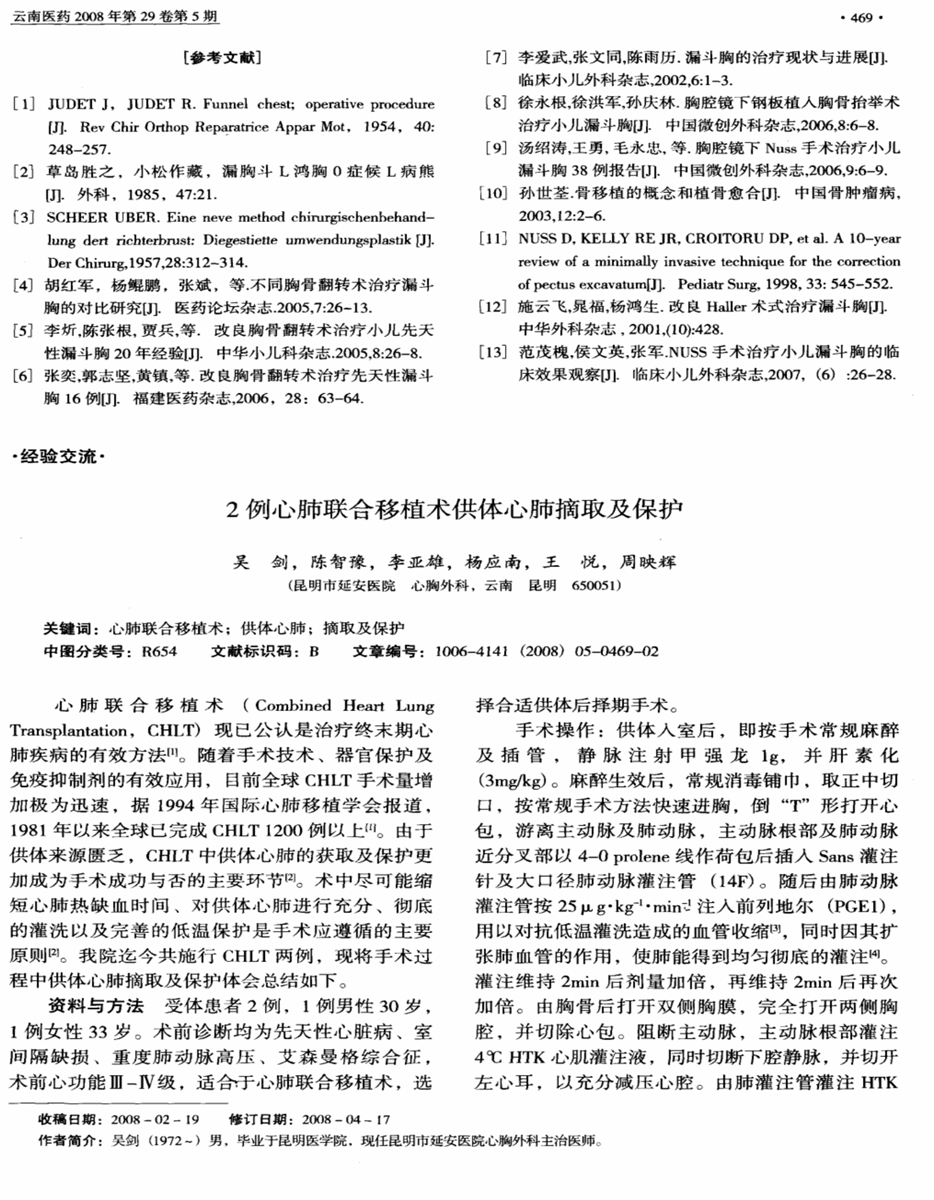
Figure 2.12 Journal of Yunnan Medicine, 2008, Vol 29, (5), pp 469
Here is the description of the surgical procedure as specified in the paper in figure 2.12: After the donor (organ provider) entered the operating room, conventional anesthesia and endotracheal intubation procedures were administered; intravenous administration of 1g methylprednisolone and heparin (3mg/Kg) was given to the organ provider. After the anesthesia began taking effect, routine draping procedure was followed using sterile towels. Incision was made in the center and into the chest swiftly using routine surgery procedures.
Analysis:
Clinical determination of brain death must include all three indispensable indicators: deep coma, no brain stem reflexes and no spontaneous breathing. No spontaneous breathing refers to the need to rely on a ventilator to maintain breathing. An apnea test must also be used to verify brain death. Apnea tests require the temporary removal of ventilator support for 8-10 minutes, during which time a clinically brain dead patient will notdisplay any respiratory efforts. According to the report above, the following conclusions can be drawn:
1) The donor was a living person, because only living people would need anesthesia and intubation.
2) The donor was conscious, as according to the description of the surgical procedure, “after the anesthesia began taking effect, routine draping procedure was followed using sterile towels.”This record indicates that the person hadphysiological signs (nerve sensory functions and reflexes) to check, to determine whether theanesthesia was effective.
3) The donor had spontaneous breathing, because anesthesia and routine tracheal intubation only took place after the donor entered the operating room. That is to say, before entering the room, he or she could breathe on his or her own without intubation.
4) The organ providerwas not brain-dead or in a deep coma, if so, he or she would have required endotracheal intubation and intravenous fluids before entering the room to maintain breathing and heartbeat.
We can draw some further conclusions from the analysis above.
1)This paper is an authentic description of how the doctors conducted a murder. It is their crime that it records.
2)The fact that they can write down the murder process and publish it on the Internet shows that killing has become their routine work, and that they have become morally depraved. It also reflects the severity of live organ harvesting by the CCP.
3) What is more frightening is that the killing is not just an isolated case. This kind of killing happensthroughout every province in China. These killings began in late 1999 and continue today.
Evidence VII: Falun Dafa practitioners are forced to have blood tests, which is powerful evidence for the existence of a living organ bank
It is very difficult for us to obtain more evidence from those secret concentration camps where Falun Gong practitioners are being held, because ofChina’s information censorship. However, these blood tests of Falun Gong practitioners, whether they are locked up in jails, labor camps, detention centers, or even at their own homes, indirectly confirming that the Chinese regime is building a database for reverse organ matching.
1. Nearly every Falun Gong practitioner is forcibly subjected to blood tests while detained
In addition to the extensive physical and mental abuse, Falun Gong practitioners from all over China are forcibly subjected to blood tests, while they are being detained. Practitioners subjected to blood tests are not informed the results, and no other detainees or inmates receive such treatment.
2. Falun Gong practitioners are subjected to forcible blood tests in their homes
Since April 2014,[69] officials from the public security bureau and police have broken into the homes of Falun Gong practitioners. In some cases, in Guizhou, Liaoning, Hunan, Hubei, and Beijing, the authorities forced the practitioners to undergo blood tests in their homes.
In a few cases, where the Falun Gong practitioners could not be located, the police of public security bureau forcibly took blood from their relatives. Even elderly Falun Gong practitioners, those over 80 years old were forced to have a blood test. Many cases like this took place in Guizhou and Liaoning, wheresome police officers even said they were simply carrying out orders from their superiors.[70]Over the course of about one month in Dandong, Liaoning Province, a total of 16 Falun Gong practitioners were forced by the local police to have their blood drawn.[71]
Chapter 3: Organ Transplants Intensify after the CCP’S Large-Scale Organ Harvesting from Live Falun Gong PractitionerswasExposed in 2006
Systematic, large-scale organ harvesting from living Falun Gong practitioners held in Sujiatun Concentration Camp in Liaoning Province in China’s northeast was exposed through international media on March 9, 2006. Facing the allegations, the CCP kept silent for three weeks. The Foreign Ministry spokesperson then denied the existence of the camp.
Meanwhile, “Interim Provisions to Manage Clinical Applications of Human Organ Transplant Technologies”[72]was introduced, and the CCP started screening qualified organ transplant hospitals from July 1, 2006. Starting May 1, 2007, unqualified hospitals could no longer carry out organ transplants.After the introduction of the Interim Provisions across the nation, many hospitals saw a dramatic increase in rushed organ transplant operations. Hospitals nationwide suddenly had a large number of organs available, and medical staff had to work overtime to transplant organs. The national transplant rush lasted at least over a year, until May 1, 2007.
I. Working overtime for intensive organ transplants
In 2006, Minghui.org received many reports from inside China that carried a similar message: the quantity of organ transplants in many hospitals had suddenly increased. For example, starting from March 2006, Tianjin Hospital of Armed Police Forces had kidney transplant surgeries every day, six surgeries per night.[73]Patients were discharged early, literally as soon as their condition became slightly better so that their hospital beds could be given to other kidney transplant patients. Patients were told that the donors were “criminal youths.”[74]
II. Hospitals slash prices, even offering free transplantsto increase sales of organ transplant operations
1. Jilin Heart Hospital offering sales promotion – only 50,000 RMB for the first five heart transplant operations[75].
On April 12, 2006, Jilin Heart Hospital offered a big “sales promotion,”charging only 50,000 RMB (US$7,500) for the first five heart transplants!
2.Hunan People’s Hospitaloffers 20 free liver and kidney transplants
On April 28, 2006, Hunan People’s Hospital advertised that the hospital is offering 20 free liver and kidney transplants, 10 liver transplants and 10 kidney transplants,[76]suggesting a large number of organs needed to be used immediately.
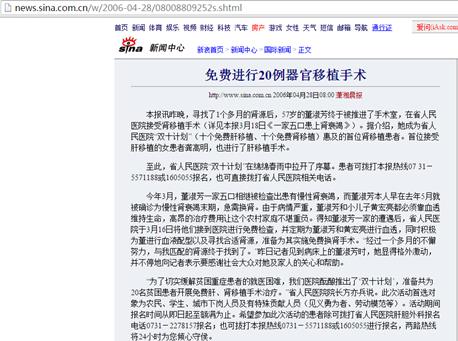
Figure 3.1 Screenshot of Hunan People’s Hospital’s advertisementoffering 20 free liver and kidney transplantson April 28, 2006.
Chapter 4: Since 2006, organ transplants have climbed steadily in China
Due to the CCP’s deliberate misinformation, the international community has been led to believe that after 2006 the number of organ transplants in China decreased. But the truth is the opposite. Organ transplantation in communist China continues to expand in scale, and the number of beds dedicated to transplant patients increases every year. The average turnover rate for these hospital beds is 103%, with some hospitals as high as 131.1%. In order to bring in more in-patients and lessen the heavy workload of the kidney transplant division in hospitals, hospitals have shortened the average length of stay for transplant patients; and transplant surgeons are busy the whole year.
The following are data cited by the regime.
I. The number of beds increases, the turnover rates are high, and the number of transplantsare huge
1. The PLA’sNo. 309 Hospital announcedits gross income from organ transplantation had increased nearly eight-fold over five years, withmore beds added in 2012
The hospital updated its online introduction to its Organ Transplant Center on November 17, 2010, and claimed that the gross income of the center was 30 million in 2006, and rose to 230 million in 2010, an increase of nearly 8-fold in 5 years.[77]
In 2010, the hospital's organ transplant center had 316 beds.In 2012, the hospital's organ transplant center had 393 beds, according to its website.
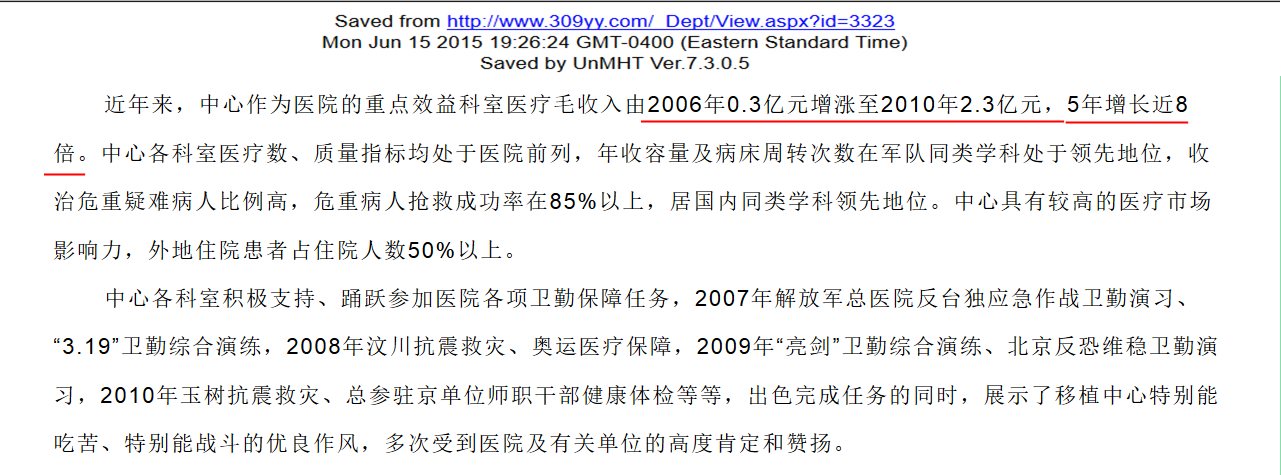
Figure 4.1 Screenshot of PLA 309 Hospital’s Website
2. For Tianjin First Central Hospital, the number of liver transplants increases each year, with more than 500 beds in its organ transplant center, the turnover rate reached 131.1 percent
In September 2006, the hospital’s organ transplant center building has more than 500 ward beds in total, up from 120 beds. Thebed occupancy rate reached as high as 131.1%.
3. At the Shanghai Renji Hospital, its liver transplant center used to have 13ward beds for transplant patients, the number was increased to 23 in 2004, [78]to 90 on June 28, 2007,[79]and to 110 beds in 2014.
A report published on the Chinese Organ Transplantation Websiteon June 28, 2007 stated that the Organ Transplant Center of Renji Hospital is equipped with a class 100 laminar flow operating room and a class 10,000 laminar flow patient ward and can simultaneously perform six liver transplant surgeries.[80]
4. Organ Transplant Center at Sichuan People's Hospital had 8 beds in 2007, and thisincreased to more than 100 beds in 2011[81][82]
5. At the Eastern Hepatobiliary Surgery Hospital, a specialist hospital for liver and gallbladder issues, its ward bed numbers increased from 742 to 1500 in 2015. [83][84]
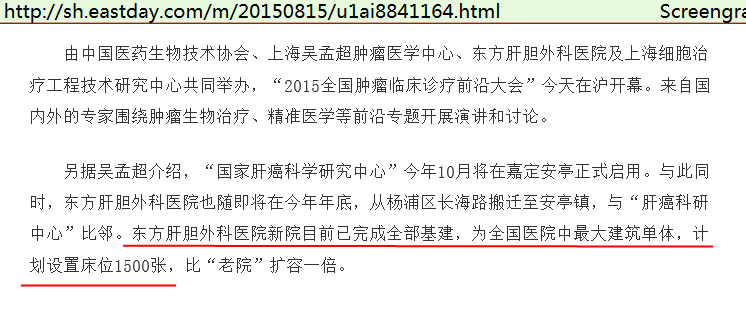
Figure 4.2Screenshot of theEastday Website on August 2015
II. The quantity of organ transplant surgery is huge, and the workload is heavy throughout the entire year
Since 1999, the organ transplant sector in China has had an exceedingly busy working schedule throughout the year. This has not been a short-term phenomenon during the course of one year, nor is it simply isolated cases found at a small number of hospitals. Instead, this is prevalent throughout the country and the pattern is consistent throughout the year. The following are some examples.
1. At Tianjin First Central Hospital, surgeons are so busy that they work overtime on weekends andholidays
According to an article from the Chinese Organ Transplantation Web in Feb. 2006, the surgeons of the Organ Transplantation Department of Tianjin First Central Hospital were so busy shuffling between hospital wards and operation rooms that they didn’t even have time to greet one another. They were often heard saying,“Too busy these several days, more than 10 operations a day.” Some surgeons were “too busy to go home.”

Figure 4. 3 Screenshot of a Chinese transplantation website in February 2006
2. Zhengzhou People’s Hospital had kidney transplantation surgeries every night
During the New Year of 2007, Zhengzhou People’s Hospital had kidney transplantation surgeries every night. On December 27 alone, the hospital completed 13 kidney transplant surgeries.[85]
According to an article on "Chinese Etiquette Training Network" publishedin April 2010, "Around Chinese New Year in 2007, surgeon Xing Li contracted conjunctivitis in his right eye from overworking for days on end, often performing surgeries from 2am or 3am the following day. Since Xing Li had to do operations like this without a rest, he had to ask his assistants to help clean his infection.” [86]
3. Average length of hospital stays for kidney transplant recipients decreased in order to relieve the heavy workload ofthe kidney transplant division
In 2013, the West China Hospital of Sichuan University shortened the average length of stay for kidney transplant patients for postoperative care to 10 days, greatly increasing the bed turnover rate.[87]
Chapter 5: The Estimated Scale of Transplantation in China
Examining the history of mankind, it is difficult to find another entity like the communist regime of China in terms of the extent of its wickedness, deception, brutality and the overwhelming scale of its power. The CCP is a totalitarian, terrorist entity that has committed crimes against humanity through utilizing state apparatuses. The challenges any investigation faces when trying to uncover the truth of the communist party’s crimes are tremendous. Deciphering the exact number of organs harvested by the state-run apparatus is even more difficult. But through multiple sources of evidence and the “slip-ups” the conspirators within the CCP has accidentally revealed through complacency from involvement in countless killings, we have been able to generate an overall picture of the massive scale of the CCP’s crimes against humanity. The numbers are enormous and shocking!
WOIPFG has investigated 22 provinces, five autonomous regions and four municipalities directly under the control of mainland China’s central government.
As of December 2014, WOIPFG’s investigation indicates that a total of 865 hospitals and 9,500 doctors have been involved in organ harvesting. Of these hospitals, 712 perform liver and kidney transplants.[20]These hospitals are found across the 22 provinces, 5 autonomous regions and 4 municipalities directly under the central government, and also the 217 prefect-level municipalities. The implicated hospitals are part of the military system, the armed police system, and a significant number are traditional Chinese medicine (TCM) hospitals, forensic hospitals, children’s hospitals, county-level hospitals, and specialist hospitals.
By clicking on the link below, you can see the geographical distribution of the 865 implicated hospitals on a Google Map and additional information. The link is: https://goo.gl/eXnnPE
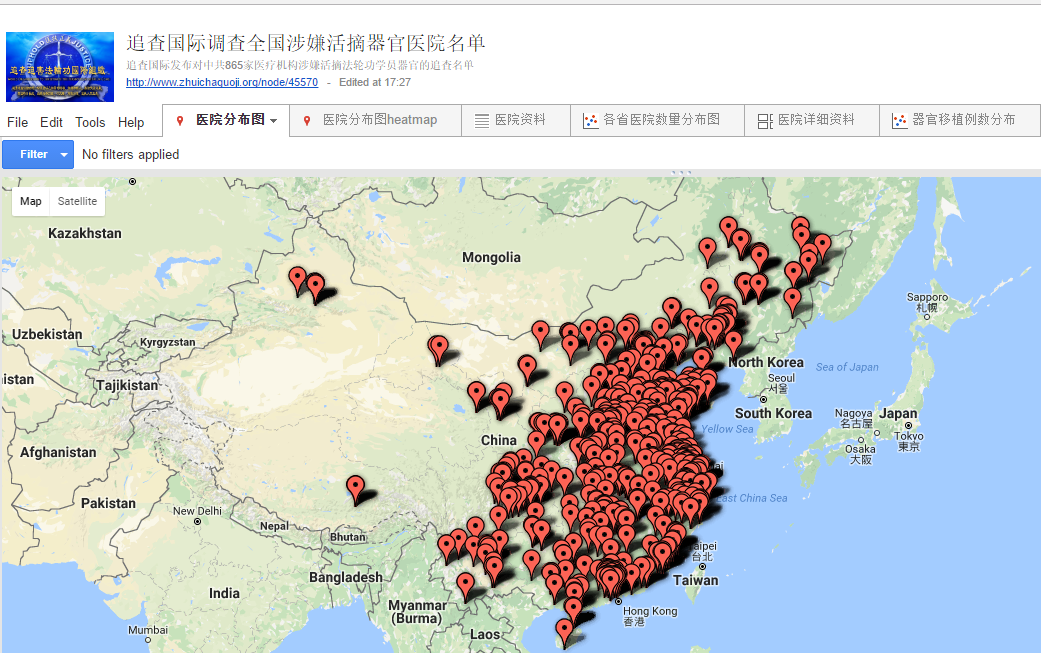
Figure 5.1 The Geographical Distribution of Chinese Hospitals Suspected of Organ Harvesting
According to July 2015 statistics from China’s Hospital Administration of the National Health and Family Planning Commission,[89]Mainland China has 20,918 hospitals, of which 1,150 are tertiary hospitals and 4,321 are secondary hospitals. Tertiary hospitals are typically large-scale comprehensive hospitals or specialized hospitals found in large cities with more than 500 beds. Of the tertiary hospitals, 705 are level A hospitals.[90]All tertiary level A hospitals conduct organ transplant surgeries.
The following areexamples that indicate the scale of organ transplants in Chinese hospitals
I. Estimation of transplant numbers from hospital data
1. The true number of liver and kidney transplants at Tianjin First Central Hospital exceeded 5,000 cases per year since 2006, and hit 8,000 at the highest point
Tianjin Municipal Committee and the city government invested 170 million RMB (~US$25.5 million) inthe construction of the Oriental Organ Transplantation Center at Tianjin First Central Hospital. The building's area is 46,000 square meters, and was first put into use in August 2006.[91]The Center has500 beds and 16 floors, making it the largest transplant center in Asia. The Surgery Center is equipped to perform nine liver transplants and eight kidney transplants simultaneously.[92]

Figure5.2 The Web Screenshot of Baidu Encyclopedia
1)Bed count, bed occupancy rate and the average length of stay for liver transplantation patients at Tianjin First Hospital’s Oriental Organ Transplantation Center
Bed count: over 500 [93]
Bed occupancy rate (BOR): 131.1 percent. [94]In 2013, the average BOR of Class A tertiary hospitalswas 103 percent.[95]
Average length of stay for a liver transplant patient in China is 25-30 days, and the average length of stay for kidney transplant is 30 days.
Annual Transplantation Quantity at Tianjin First Hospital’s Oriental Organ Transplantation Center:
5,475 cases(500×365×90%/30), using 90 percent as average BOR, and 30 days as average length of stay
6,265 cases(500×365×103%/30), using 103 percent as the average BOR, and 30 days as average length of stay
7,975 cases(500×365×131.1%/30), using 131.1 percent as the BOR, and 30 days as the average length of stay
8,544cases (500×365×131.1%/28), using 131.1 percent as the BOR and 28 days as the average length of stay
2) The hospital’s team of liver and kidney transplant surgeons. [96]
Through official online publications and medical papers, we found that 110 surgeons at Tianjin First Hospital had conducted liver and kidney transplants, including 21 chief surgeons, 25 deputy chief surgeons, 13 attending surgeons and 51 others.[97]Since 1999, liver and kidney transplants have become routine clinical surgeries at the center.[98]In January2015,Tonight Media Group reported, "Under the guidance of Shen Zhongyang, new surgeons can now conduct liver transplants independently and have nearly conducted 1,000 liver transplants."[99]
3) Surgery capability
The Organ Transplantation Surgery Center is able to perform nine liver transplants and eight kidney transplants simultaneously,[100]or 17 surgeries simultaneously.
4)Surgeons have almost no days to rest
Based on the above analysis, we believe that as early as 2006, the number of liver and kidney transplants at this hospital reached more than 5,000 a year, and at its highest point, the number almost reached 8,000 cases.
(Definition:Bed occupancy rate(BOR) indicates the ratio of beds occupied by patients to total bed count[101])
2. The actual transplant quantity at the PLA No. 309 Hospital has exceeded 4,000every year since 2012
The Transplant Center at the PLA No. 309 Hospital was established in April 2002. In October 2005, it was renamed the PLA Organ Transplant Center by the Health Division of the PLA General Logistics Department. In 2011, it was renamed the PLA Organ Transplant Research Institute by the same division. The PLA No. 309 Hospital is also the Data Center for the Management Committee of the Chinese Scientific Registry of Kidney Transplantation
(CSRKT).[102]
Bed count: 393 beds in 2012[103]
Bed occupancy rate: 100 percent[104]
The length of stay: 30 days
Surgeon team:
As many as 42 surgeons,[105]including 13 chief and deputy chief surgeons work at the Transplant Center at the PLA No. 309 Hospital.
Surgery capability:
The hospital once completed 12 kidney transplants in one night.[106]
Annual transplantation quantity:
4,924 cases (393 ×365×103%/30)
3. Gongyi Hospital of Traditional Chinese Medicine in Henan province launched a Kidney Transplant Center in 2001
Gongyi is merely a small county-level city. This hospital within Gongyi City’s jurisdiction uses Traditional Chinese Medicine (TCM) as the primary means for diagnosis and treatment, but it actually set up a Kidney Transplant Center in 2001.The hospital can handle as many as 12 kidney transplant patients simultaneously and is equipped to conduct as many as eight kidney transplants per day. By 2006, the hospital’s director of the Urology Department, Li Hongdao, had conducted more than 500 kidney transplants.[107]
II. Media reports validate the massive scale of transplants performed
1. China Economic Weekly: Peking University People’s Hospital once performed 4,000 liver and kidney transplants in one year
In September 2013, Zhu Jiye, head of Peking University Organ Transplantation Research Institute and the director of the Hepatobiliary Surgery Department at Peking University People’s Hospital, said in an interview with China Economic Weekly, “Prior to launching the pilot project in 2010, organs from executed prisoners accounted for almost all donor organ sources in China. Our hospital used to perform 4,000 liver and kidney transplants in one year, and the sources of these organs were all death-row prisoners.”[108]

Figure 5.3 Screenshot of the“Xinhua Network” article in September 2013
2. China Times: The No. 175 Hospital in Nanjing Military Region “performs at least 3000 kidney transplants cases per year
According to a China Times’ report dated May 1, 2006, Xiamen Chang Gung Hospital, whose costly construction was funded by two prominent Taiwanese companies would be put to use at the end of 2006. Organ transplantation would be the hospital’s main business.
A Taiwanese businessman in Xiamen cited the example of a tertiary hospital located in Zhangzhou, Fujian province, which is close to Xiamen: The No. 175 Hospital of Nanjing Military Region, or Xiamen University Affiliated Southeast Hospital. The hospital performs at least 3,000 kidney transplants each year.[109]One out of four kidney transplant patients at the hospital were from Taiwan. Considering a kidney transplant costs1 million to 2 million New Taiwan Dollars (US$31,000-$62,000), Chang Gung Hospital, which focuses primarily on kidney transplants, would have a very lucrative outlook…[110]
3. KwongWahYitPoh:Wuhan Tongji Hospital performs thousands of kidney transplants per year
An article first published onKwongWahYitPoh,and later reproduced by China’sSina Global News,stated that as an important city in central China, Wuhan is also China’s largest organ transplant center. Wuhan Tongji Hospital is one of China’s earliest and most authoritative hospitals that performs live donor kidney transplants. Every year, thehospital performs thousands of kidney transplant surgeries. The hospital’s website claims to have the largest group of living donor kidney transplant recipients.[111]
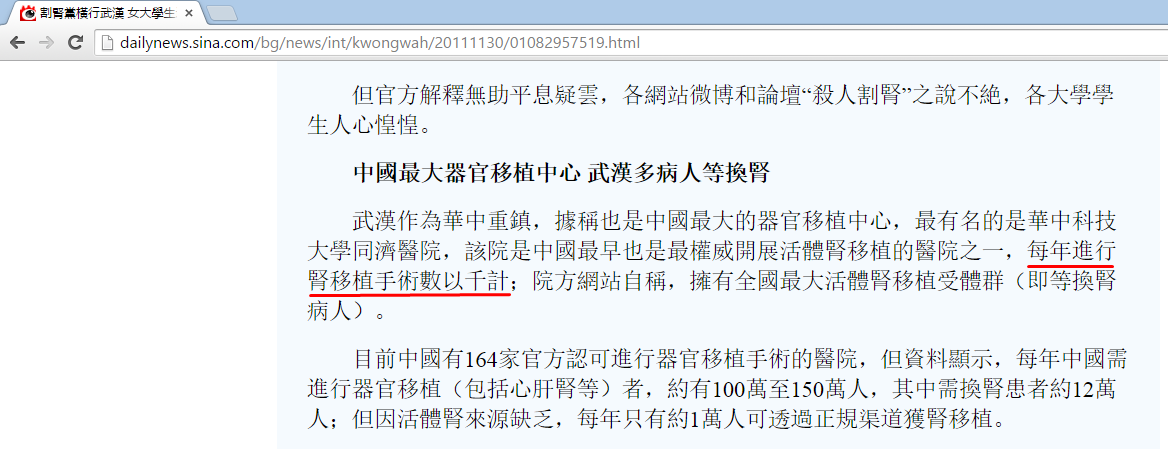
Figure 5.4 Screenshot of "Sina Global News" article in November 2011
During WOIPFG’s investigation, a surgeon from this hospital said, “There is guaranteed to be sufficient live prisoners like Falun Gong practitioners.” He also told the undercover telephone investigator, “Before the people (the donors) die, the organs are taken out.”[112]
A surgeon’s relative, who works at this hospital, said many donors were available, and before the crimes of organ harvesting were exposed in 2006, the surgeons would work overtime every day to perform organ transplants.[113]
On January 16, 2016, the official website for this hospital still claimed that its kidney transplants numbered nearly 3,000 a year.[114]But later, the number of kidney transplants per year plummeted to 200 cases, suggesting that the data was deliberately altered.
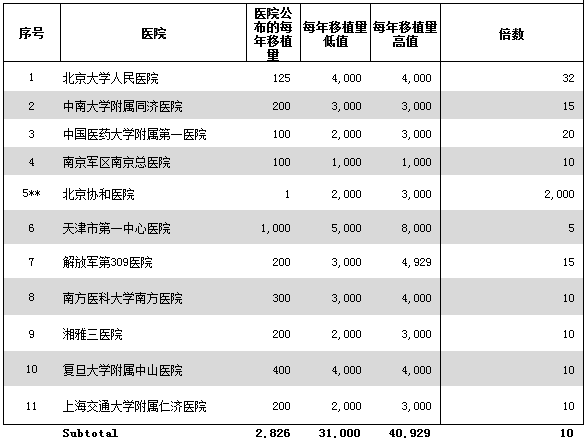
Figure 5.5 Comparison of actual transplant numbers and published transplant numbers for 11 hospitals
Perhaps the numbers above seem too large to be accurate, but if we review what several authoritative transplant specialists within the CCP system have said, the actual numbers are likely much, much larger.
1. Wu Mengchao: The communist party’s quantity of liver transplants is No. 1 in the world
On May 11, 2011, Sina TV interviewed Wu Mengchao and his student Wang Hongyang. The host, Yin Jun, asked, “Where is China in terms of liver transplants?" Wu Mengchao replied, “At present, China performs the most liver transplants in the world, and both the quality and results of the transplants are good and have caught up with the international standard.”[115]
In the United States, about 6,000 liver transplants are performed per year.[116]
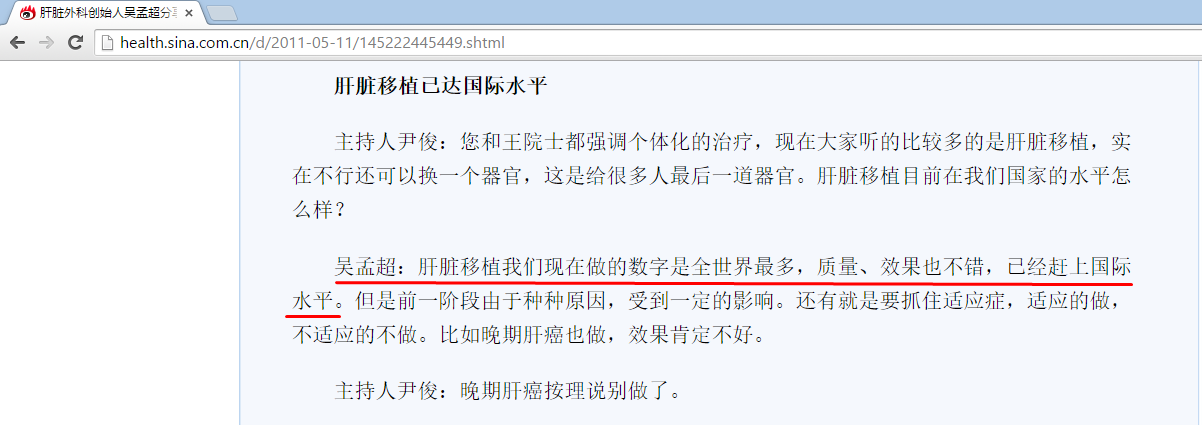
Figure 5.6 Screenshot of Sina Health webpage from May 2011
2. He Xiaoshun: “The number of liver transplants nationwide in 2000 was 10 times that of 1999, and by 2005 the number had tripled since 2000”
Phoenix Magazine Networkpublished an article titled “The Inside Story of Human Organ Trading in China” on November 5, 2013. The article quoted He Xiaoshun, who is a health specialist for the central government, a committee member of the China Organ Donation Committee,[117]and Vice President of the Organ Transplantation Academy of the First Affiliated Hospital of Sun Yat-sen University.[118]He Xiaoshun was quoted saying,“The year 2000 is the watershed of China’s organ transplant industry … The number of liver transplants nationwide in 2000 is 10 times that of 1999, and by 2005, the number has tripled since 2000.”[119]This means the number of transplants carried out in 2005 in China was 30 times that of the year 2000.

Figure 5.7 Phoenix Magazine Network’s Inside Story of Human Organ Trading in China, November 5, 2013
3. Huang Jiefu alone performed more than 500 transplants in 2012
Huang Jiefu, chairman of the China Organ Donation Committee, deputy director at the ministerial level of the Central Health Protection Committee, and the former vice minister of the Ministry of Health, is responsible for overseeing China’s organ transplant sector. He is also the former principal at Sun Yatsen University, and director of the school’s Organ Transplant Center.
As a liver transplant physician, Huang Jiefu performed more than 500 transplants in 2012, and only one transplant used a donated organ.

Figure 5.8 Screenshot of a news article where Huang Jiefu stated he had performed more than 500 transplants in one year.
A Chinese doctor German surgeon told Dr. Torsten Trey in 2006 that a Tianjin hospital conducted 2,000 liver transplants per year.[120]
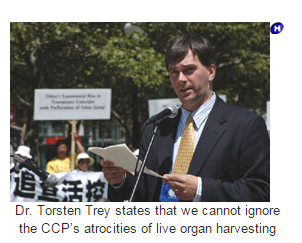
Figure 5.9 Photograph of Dr. Torsten, sourced from the Epoch Times
On July 24, 2006, Dr. Torsten Trey traveled to Boston from Germany to attend the first World Organ Transplant Academic Conference. During that conference, a surgeon from Tianjin told him that the hospital he worked for was one of three in Tianjin that could perform organ transplant surgeries, and that it conducted about 2,000 cases of liver transplants in one year. Dr. Trey was puzzled, and thought, "This number is more than the total number of operations in Germany, we have to ask where their liver donors come from."
V. The testimony of Yang Guang
A witness named Mr. Yang said, “A friend who works at the Public Security Bureau told me on the phone that in the last 10 years or so organ transplants performed at general hospitals led to the unnatural deaths of more than 500,000 Falun Gong practitioners.This figure was only what he knew from general hospitals’ statistics, such as People’s hospitals and municipality hospitals. The number of organ transplants from Armed Police Hospitals, Military hospitals and Public Bureau hospitals were not included.Because statistics from these three kinds of hospitals are more confidential, even people who work for the Ministry of Public Security are not in the know.”[121]
2. Two affiliated hospitals of a medical university in a big city conduct 2,000-3,000 organ transplants per year
According to an exclusive report published by Epoch Times on March 16, 2014, Chinese affairs expert Yang Guang spoke about the live organ harvesting at two affiliated hospitals of a medical university in China.[122]One of Mr. Yang’s former classmates is the deputy head at a hospital affiliated with a medical university. To protect the safety of these sources, we will not reveal the name of this hospital or that of the deputy head. He is a medical expert who takes care of hospital logistics. This man told Mr. Yang in person the dark reality of how organs are transplanted inside this hospital:
“The two hospitals affiliated to our medical university conduct 2,000-3,000 organ transplants every year. Since there is a live organ donor bank, blood type matching can be completed within a month, sometimes even within 48 hours. As soon as our hospital notifies the 610 Office, a prison vehicle would immediately send a matching candidate with the matching code number to our hospital. After another round of testing to confirm the blood type, this candidate would be sent to different divisions for transplant needs. Often, liver, kidney and corneal transplants are performed simultaneously. After the operations, the body would be sent to the cremation furnace, without collecting the ashes. We only have this donor’s code number, and we only know that he or she was a Falun Gong practitioner. People from the 610 Office are always on site to monitor the entire transplant procedure.”
“The Communist Party committee at higher levels set rules for us to keep all the information confidential. We are not allowed to look into the situation or the number of organ transplants in other hospitals, nor are we allowed to tell others about the organ transplant situation in our hospital. At the end of each year, we report to our higher-level Party Committee the number of transplants conducted within that year (2000-3000 cases),and the code numbers of the organ donors. Immediately after we send the report, monitored by the 610 Office personnel, we are ordered to delete all the data from our computers. ”
VI. The latest investigative phone recording of Politburo Standing Committee MemberZhang Gaoliconfirms the CCP’s Crimes of OrganHarvesting
On June 24, 2015, a WOIPFG investigator called Chinese Vice Premier Zhang Gaoli, saying that she was a secretary from Jiang Zemin’s Office, to verify that Jiang Zemin gave the order to harvest organs from millions of living Falun Gong practitioners.[123]
1. Confirmation that Jiang Zemin ordered organs be harvested from millions of living Falun Gong practitioners
As one of the incumbent Politburo Standing Committee members and Vice Premier, Zhang Gaoli did not deny nor show surprise when asked by the investigator about, “Jiang Zemin’s order to remove organs from several million Falun Gong practitioners.” In addition, when asked by the investigator “to prevent the matter from being pursued at the Politburo meeting,” Zhang promised, “I will” and asked Jiang to “not worry.” This further affirms that Jiang Zemin personally ordered the removal of organs from living Falun Gong practitioners. To date, the number of practitioners who have been killed for their organs is as many as several million. Furthermore, cadres at the most senior levels of the communist party are all fully aware of this.
2. Zhang Gaoli promised that he would “handle the rest of Falun Gong practitioners well”
This statement from Zhang Gaoli confirms that the living organ bank composed of a large number of detained Falun Gong practitioners still exists today, and that Falun Gong practitioners are in danger of having their organs removed at any time.
VII. Examination of China’s transplant volumes
For reasons well known to the public now, a definitive conclusion or entirely accurate figures of the number of organs harvested by the CCP are impossible to obtain. Yet ample evidence exists to suggest the number is frighteningly large. The crimes of organ harvesting from Falun Gong practitioners are carried out utilizing China’s state apparatuses.
Millions of Falun Gong practitioners who petitioned the government for the freedom to practice Falun Gong openly and were arrested are the primary source of organs in the living organ pool. Substantial evidence confirms that people within these state apparatuses are killing on demand and that Falun Gong prisoners of conscience are the primary source of organs. Since 2006, when these crimes were exposed in international media, the CCP has adjusted its data about the organ transplant volume to give the impression that organ transplants in China were on the decline, when in fact hospitals were adding beds to transplant wards to facilitate an increasing the number of surgeries. The volume of Falun Gong practitioners slaughtered for their organs by the CCP is most certainly an appalling figure.
This investigative report presents evidence in order to raise awareness of the CCP’s crimes against humanity. The conclusions drawn from the investigate report are the results of in-depth investigations over the last decade. These efforts aim to end these anti-humanity atrocities as soon as possible.
(For more details, refer to Chapter 6 of “WOIPFG’s Investigation on the CCP’s Crimes of Utilizing State Apparatuses for Harvesting Organs from Falun Gong Practitioners on a Massive Scale”)
1. Ninety-six organ-harvesting centers conduct an average of 2000 to 3000 transplants every year[124]
These 96 organ harvesting centers are all tertiary A-level hospitals equipped with the most advanced medical equipment and staffed with the best physicians in China. These hospitals are usually directly governed by various arms of the military, prominent hospitals located in major cities, or are affiliated with key universities or institutions. Some of the hospitals’ transplant data has been published in the communist party’s official media and in overseas media that is controlled by the communist party. These figures suggest the annual transplant volumes of these hospitals are generally in the thousands, and the numbers reach as high as 5,000 or 8,000 annually in some cases. The average transplant figures for these hospitals have been 2000-3000 cases per year, 10-20 times those of the publicly released figures.
96 hospitals carrying out 2,000 transplants per year per hospital wouldmean192,000 cases per year,or1.92 million transplants in 10 years
2. Fifty regional liver and kidney transplantation centers suspected of conducting 400-1,000 transplants per year[125]
These hospitals belong to the secondary hospitals accredited by the Ministry of Health to conduct transplant operations. They are mostly provincial hospitals or affiliated hospitals of universities located inprefecture-level or provincial-level municipalities. These hospitals also have advanced transplant expertise with large transplant volumes.
3. 408military, police or Class A tertiary hospitals not accredited by the Ministry of Health to conduct transplant operations have conducted exceedingly large numbers of transplant operations[126]
There are 408 transplantation centers in large-scale military and local hospitals, mainly Class A tertiary hospitals, not accredited to conduct transplant operations, including56 military and armed police hospitals, and 352 local Class A tertiary hospitals.
Experts estimate that before the organ harvesting from living donors was exposed in 2006, the number of organ transplantations conducted by countless small and medium transplantation institutions, which account for 80 percent of all medical institutions that perform transplants in China, was no less than that from the large institutions, which account for 20 percent of the total. With some small hospitals having exceedingly large transplant volumes.
Even after the Chinese Ministry of Health implemented an accreditation system, many hospitals that failed to receive accreditation continued with such operations. Compared to the large hospitals, these small and medium institutions are more flexible in their operations. Several dozen military and armed police hospitals are not restricted in any fashion, because they possess abundant sources of donors, and the total number of transplantations from these facilities should not be underestimated.
4. 153 small and medium transplant centers not accredited to conduct transplants may have conducted 3000-7000 transplants per year[127]
The 153 transplant centers within this category include mostly secondary hospitals, Class B tertiary hospitals, a small number of small-scale privately owned hospitals and district hospitals. These hospitals mostly perform kidney transplants, which require relatively less medical expertise.
Prior to the 2007 release of the list of approved and designated organ transplant centers by China’s Ministry of Health, there had been regional accreditation programs for organ transplants across the country. The qualifying standard within the transplant sector was usually that a hospital needed to conduct a minimum of 50 transplants per year. For example, Guangdong’s Provincial Health Department issued a minimal qualification standard for a transplant hospital in 2003,[128]where a kidney transplant hospital was required to perform at least 50 cases per year. From September to December of 2003, 47 hospitals of different sizes in Guangdong received the liver and kidney transplantation qualification, including 30 hospitals that performed kidney transplants. A cautious estimate shows that if each hospital performs 20-50 transplants per year, 153 hospitals amount to 3,060 to 7,650 cases.
In summary, the number of Falun Gong practitioners slaughtered for their organs maybe in the hundreds of thousands, or several million–the number is appalling.
Of course, obtaining actual information from a tyrannical regime is exceedingly difficult. Looking back in history, it took a long time for the international community to come to terms with the existence of the Holocaust. The extent of the crimes committed was not made known to the world until the Allies liberated Auschwitz Concentration Camp. Postwar investigations showed that more than 6 million Jews were slaughtered. The world paid a heavy price for World War II.
Today, the CCP's actions are extremely similar to those committed by the Nazis, only that the extent of the abomination by the CCP is much greater. Mankind cannot continue to overlook these crimes.
Chapter 6: The Claim that Organs are from Death Row Prisoners is a Lie
I. The number of death row prisoners far less than the organ transplant volumes
According to Amnesty International’s records, from 1995 to 1999, the annual average of executed death row prisoners in China was around 1,680 per year. Between 2000 and 2005, the average number was 1,616 per year. These numbers vary from year to year, but overall, the average numbers before and after the persecution of FalunGong started was about the same.[129]While Amnesty International’s numbers may be a low estimate, even if the estimate was higher it would fail to explain the exponential growth in transplant volumes in China since the year 2000.
China’s officially released numbers for kidney transplants far exceeds the number of death row prisoners. Huang Jiefu’s claim that the annual kidney transplant volume is 5,500-10,000 already far exceeds the number of death row prisoners. WOIPFG’s investigation indicates that from 2000 to 2005, China performed at least 12,200 kidney transplants per year.
The discrepancy is even greater if we are talking about the actual kidney transplant volumes. For example, Peking University People’s Hospital performed 4,000 kidney transplants in one year. The number of death row prisoners for the entire country would be far from enough to meet the demand of just this one hospital.

Figure 6.1 Screenshot of Xinhua Web in September 2013
II. Matching probability indicates that the organ pool size is much greater than the number of death row prisoners
Usually the match ratio for a donor that is unrelated to the transplant patient is 6.5 percent. Based on Huang Jiefu’s claim that the number of kidney transplants in 2000 and 2004 were5,500 and 10,000 respectively, at least 42,000 to 77,000 potential donors would be required per year as the base population for the match ratio.
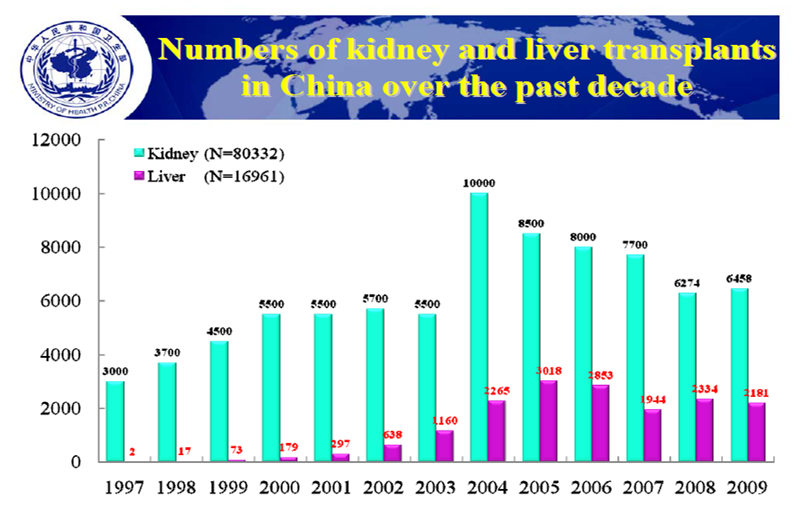
Figure 6.2 Total quantity of organ transplants, released by Huang Jiefu in Madrid in March 2010
III. Only a small number of death row prisoners qualify to become organ donors due to health factors
1) In 2009, Hangzhou city of Zhejiang Province conducted a hepatitis B checkup for 482 detainees, and found that 29 percent tested positive.[130]

Figure 6.3TheHepatitis B Checkup Results of 482 Detainees in Hangzhou City
2) In 2006, Heze City of Shangdong Province also conducted a physical check of detainees, and found that 1.29 percent tested positive for AIDS and syphilis, and 28.91 percent tested positive for hepatitis B and hepatitis C.

Figure 6.4 Results of physical checkups fordetainees in Heze City of Shangdong Province
IV. The donors in excellent health, as specified in Chinese doctors’ medical papers, were not death row prisoners
Of the 300 medical theses from 200 hospitals collected by WOIPFG investigators,[131]2,084 cases of various transplant operations were recorded where a description of the “donor” was specified. The “donors” were described as having “no history of long-term medication,” “no hepatitis B, hepatitis C, malignant tumors or chronic illnesses,” “no history of alcohol abuse, diabetes or other illnesses” and “no fatty liver.”The health of the “donors,” as described by hospitals in many different provinces, is consistently good.
V. The excellent health of organ “donors” as described in Chinese doctors’ medical papers exceeds the average health metrics of normal Chinese adults
“A number of surveys which used sampling data from city populations show that 12.5 percent~35.4 percent of Chinese adults have fatty liver, making it the No.1 liver disease among Chinese adults, replacing viral hepatitis.” Professor Zeng Minde, honorary group leader of the Fatty Liver and Alcoholic Liver Disease Group of the Chinese Medical Society, said. He also said that China has seen a dramatic increase in people with obesity and type 2 diabetes, suggesting that the percentage of the Chinese population with fatty liver will continue to rise.[132]
Table 6.1 Examples of “Donors” in Excellent Health from 2084 transplant cases at 36 hospitals[133]
(For more details, refer to Chapter 4 of “WOIPFG’s Investigation on the CCP’s Crimes of Utilizing State Apparatuses for Harvesting Organs from Falun Gong Practitioners on a Massive Scale”
http://www.upholdjustice.org/node/362)
Chapter 7:The Claim that All Organs Were from Donation in 2015 is a Lie
The CCP announced that beginning January 1, 2015, it would stop using executed prisoners as donors for organ transplants, and that donated organs from the general public would be the sole source for organ transplants.
From January 2015 to November 2015, WOIPFG investigators spoke with staff in 169 Chinese hospitals designated to perform organ transplants and a number of institutes for voluntary organ donation. The investigators found:
1. Organ transplants are still being performed in large quantities with short wait times and abundant donors, a pattern that cannot be explained by a random supply of voluntary donors.
2. China’s official organ donation institutes claim that donors are scarce, and successful matches are few and far between.
3. Some surgeons frankly acknowledged that the CCP’s campaign of harvesting organs from living Falun Gong practitioners is still going on. Some also confirmed that Jiang Zemin ordered the killing of Falun Gong practitioners for their organs, and that all hospitals are carrying out the order.
I. The organ donation system in China is actually in a paralyzed state, and has failed to function
1. Huang Jiefu said that China’s Organ Donation and Transplantation Committee exists in name only
In his interviews with The New York Times and Beijing Youth Daily on November 18, 2015, Huang Jiefu revealed that China’s voluntary organ donation system is in a paralyzed state, and has failed to function:
"When being asked about the biggest problem currently, he admitted to the lack of coordination between the Red Cross and the National Planning Commission, the two key departments in setting up the organ donation system. The two departments jointly established the national Organ Donation and Transplantation Committee on March 1, 2014, but the Committee practically exists in name only, 'so far no meeting has been hold yet'. As the chairman, he felt powerless and was concerned.”[134]
2. China’s organ donation rate is only 0.6ppm (0.6 per 1 million people)[135]
Organ transplantation in China started in the 1970s, but until 2003 post mortem organ donation from members of the general public was practically nonexistent. In March 2010, a pilot project for an organ donation system started in Shanghai, Tianjin, Liaoning Province, Shandong Province, Zhejiang Province, Guangdong Province, Jiangxi Province, Xiamen of Fujian Province, Nanjing of Jiangsu Province, and Wuhan of Hubei Province. Guangdong Province’s Human Organ Donation Pilot Project officially went into operation on April 20, 2010.
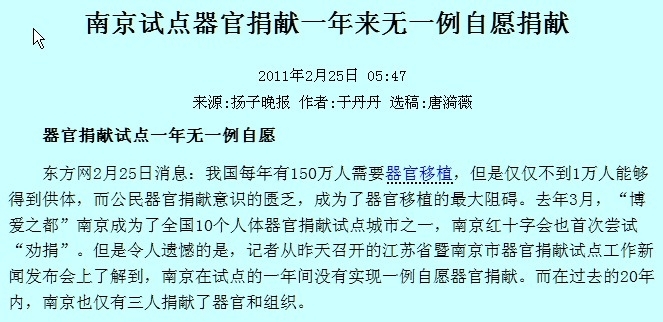
Figure 7.1 Snapshot of Yangzi Evening Newspaper
Yangzi Evening Newspaper reported on a press conference about the Organ Donation Pilot Project held by Nanjing City Jiangsu Province on February 25, 2011. The article revealed that since becoming one of10 Chinese cities included in the organ donation system’s pilot project in March the previous year, Nanjing has yet to see any organ donors. Over the past 20 years, just three persons have donated their organs in Nanjing.
According to Huang Jiefu, China has about 300,000 patients annually who are in urgent need of organ transplants, yet there are only about 10,000 transplant operations per year. At present, Chinese citizens’ post mortem organ donation rate is just 0.6ppm (0.6 per one million people), making China among the countries with the lowest organ donation rates in the world.[136]
Professor Chen Zhonghua of Tongji University School of Medicine, which is affiliated with Huazhong University of Science and Technology, stated that from 2003 to August 2009 only 130 cases of successful organ donation from deceased mainland Chinese citizens were recorded. According to data released during the 2014 Chinese Organ Transplant Conference, there were only 1,448 cases of organ donation from deceased mainland Chinese citizens in the three-year period from 2010 to 2013.[137]
WOIPFG investigators called China’s Red Cross organ donation offices at the end of 2015. Though few picked up the phone, those who did claimed that the number of successful donations is very low.
1. The staff from the Red Cross Society of Beijing said that organ donation has not yet begun. (December 6, 2015, Phone number: 861063558766), (Recording download:MP3Transcription:Appendix 12)
Beijing has the largest transplant volumes in China. The category of hospitals accredited by the Ministry of Health to conduct transplants independently includes 20 hospitals. The actual transplant volume is appalling. Director of Urology at the Peking University People's Hospital ZhuJiye toldChina Economic Weekly that the hospital "once performed 4,000 kidney transplants within a year."[138]
2. Tianjin Red Cross workers said that since the organ donation bank system was set up in 2003more than 170 donations have been made. (December 11, 2015, Phone number: 862227311180) (Recording Download:MP3, Transcription:Appendix 13)
According to a Tianjin Daily’s report on March 1, 2015, "The reporter learned from the Red Cross recently that since Tianjin launched the human organ donation system in March 2010, Tianjin has a total of 123 cases of successful organ donation, the cumulative number of donated large organs is 278."[139]
Such a low number of donations cannot explain the huge organ transplant volumes in Tianjin. Tianjin has four transplant hospitals accredited by the Ministry of Health. Out of these four hospitals, the Organ Transplant Center at Tianjin First Center Hospital has more than 500 transplant beds, and from 2006 to 2014, the hospital’s actual transplant volume per year was in the range of 5,000 to 8,000.[140]
3. Shanghai only had five successful cases or organ donation
Staff from the Red Cross organ donation office in Huangpu District, Shanghai(Phone number: 86-63365880), said on December 17, 2015,they only started this work during the first half of the previous year. They said a document was issued from a senior level regarding the process, and organ donations are very difficult. To date, there have only been five cases of organ donation in Shanghai.(Recording Download:MP3,Transcription:Appendix 14)
Shanghai has 11 organ transplantation hospitals accredited by the Ministry of Health, all of which are national transplant centers. These hospitals carry out large numbers of organ transplants each year. So the five cases of organ donation are not the main source of organs for transplant hospitals in Shanghai.
4.One female staff member at the organ donation office of the Red Cross chapter in Qinhuangdao, Hebei Province said, "As of now, in our office, we haven’t had any organ donations."
On May 14, 2015, a female staff member at the organ donation office of the Red Cross chapter in Qinhuangdao, Hebei Province said, “There are people who have registered for organ donations at some point in their life, so they intended to donate their organs, but even such cases are scarce. All of our cases are such that a person registers for donation and the donation happens when this person dies. As of now, in our office we haven’t had any actual organ donations.”(Recording Download:MP3,Transcription:Appendix 14)
5. “It is almost impossible for Chinese people to donate their organs, you can’t find any donors, almost can’t find any donors who would be willing to donate unless the person is a relative!”
This was the response by Liu Zhonghua in March 2015. Liu is the chief physician of the Urological Department at Henan People’s Hospital (Phone number: 8613503716066)(Recording Download:MP3, Transcription:Appendix 16)
6. “Even if the deceased’s close relatives consent to the organ donation, sometimes all it takes is one word from a distant relative, and the family changes their mind”
In July 2015, on-duty staff at the organ donation office of the Red Cross chapter in Jiaozuo said, some people have registered for organ donation, but the number is very, very small; there are people who have registered, but you must wait for them to die of natural causes before organ donation could take place; the number of people who donate their organs after they die from accidents is very few and far between. As for those who donate organs after death, they can’t make the decision whether to donate or not after they’re dead. So their family has to call us to give consent to the donation. Even if the deceased’s close relatives consent to donate the deceased’s organ(s), sometimes all it takes is one word from a distant relative, and the family changes their mind. (Evidence Serial Number: 56, Phone Number: 863913933224)
(Recording download:MP3, Transcription:Appendix 18)
III. Huang Jiefu claimed that the number of organ transplants in 2015 hit a new record
In his interviews with The New York Times and Beijing Youth Daily, Huang Jiefu said, "As of the 17th of this month, organ donations from citizens have reached 2,297 cases this year, and it is expected to exceed 2,500 cases for the whole year. If each donor can donate three organs after death, the organ donation volume will reach approximately 7,500 this year. If we take into account living related donation, the number of transplants will exceed 10,000 cases this year, which will be the highest in our history, and the quality of transplants has also been greatly improved."[141]
From all the evidence collected, we conclude: the claim that only donated organs were used in 2015 is a lie. But on the contrary, China’s organ transplantation industry is still going strong. As Huang said, the number of organ transplantation in 2015 hit a new record. So now questions remain unanswered, including who were the donors? And what kind of horrific deeds are being done in the dark?
1. “We have plenty of donors. We can still select young and good ones.”
(Evidence Serial Number: 63, Phone Number: 8613623711903) On June 26, 2015, Dr. Chen Yongfeng from the Organ Transplant Department at Zhengzhou People’s Hospital told a WOIPFG investigator, “Our hospital is the best in Henan Province for performing liver transplants. We did several transplants today; two were liver transplants. The donors are locals. The quality of these donors is trustworthy. If you need a transplant and you give us enough time,we can select a good and relatively young liver. We have plenty of donors. We can still select young and good ones.It is hard to say if that will be the case down the road.”(Recording Download:MP3,Transcription:Appendix 1)
2. “The shortest wait time for a donor is approximately 2-3 days, in general. The longest is over 10 days.”
(Evidence Serial Number: 61, Phone Number: 8637163933151) On June 25, 2015, a doctor on-duty at the Hepatobiliary Surgery Department of Zhengzhou People’s Hospital told an investigator, “The shortest wait time for a donor is approximately 2-3 days, in general. The longest is over 10 days. The cost is about 500,000 yuan (US$78,000). We have a lot of donors.” When asked why their wait time is shorter than other hospitals and who the donorswere, the doctor said, “For this matter, um, I cannot provide any answers. I can’t. Don’t ask. Don’t ask these questions. The organs are directly sent to our operating rooms every day, one or two operations every day, guaranteed.” (Recording Download:MP3, Transcription:Appendix 2)
3. “Some (organs) could be sent here overnight. We would perform (the surgeries) overnight. That is very common here.”
(Evidence Serial Number: 65, Phone Number: 8637166862192) On March 19, 2015, Dr. Li Gongquan, liver transplant surgeon at the First Affiliated Hospital of Zhengzhou University, said, “It could be done within a week. If you want, we can do organ matching with him…We did one like this today, and we have just finished it. Tomorrow there may be another case…Some (organs) could be sent here overnight. We would perform (the surgeries) overnight. That is very common here.”
(Recording Download:MP3,Transcription:Appendix 5)
V. Crimes of harvesting organs from living Falun Gong practitioners continue
The CCP claims that mainland China has completely stopped using organs from death row prisoners. Yet under the circumstance that the number of donated organs is far from sufficient in replacing death row prisoners’ organs, hospitals across China are still performing an exceedingly large number of transplant operations. There is still ample supply of organs. How can we explain this abnormal phenomenon?
1. “Of course, we know who the donors were, as to whether these donors were Falun Gong practitioners or not, that’s not our concern. All we care about is whether the organs meet our requirements.”
(Evidence Serial Number:66, Phone Number: 8613681972360)On February 8, 2015, Tan Yunshan, the chief physician in the Liver Pathological Department at the Affiliated Zhongshan Hospital of Fudan University said, “Allthe donorsfor liver transplant operations nowcome from the ‘source.’ Of course, we know who the donors were, as to whether these donors were Falun Gong practitioners or not, that’s not our concern. Regardless of whether the prisoner gave his/her signature of consent for organ donation, we use the organ(s) anyway. All we care about is whether the organs meet our requirements.”
Investigator: "Do you know that Bai Shuzhong, the former Minister of PLA General Logistics Department of Health, confessed that Jiang Zemin gave the order for harvesting organs from living Falun Gong practitioners for transplants? So is every hospital doing surgeries under that policy?" Tan Yunshan said, "Yes, that’s right." (Recording download:MP3, Transcription:Appendix 20)
2. “The existence of an organ bank of detained Falun Gong practitioners, and using organs from Falun Gong practitioners” “Correct, that’s right.”
(Evidence Serial Number:45, Phone Number:862082375263) On June 30, 2015, Dr. Han at the Hepatobiliary Surgery Department of the First Affiliated Hospital of Zhongshan University spoke to a WOIPFG investigator during a phone investigation. Upon hearing that Huang Jiefu performs more than 500 liver transplants every year, Dr. Han said, “Presently, we can even perform more than 1,500 transplants [per year].” When the investigator mentioned the existence of an organ bank comprised of detained Falun Gong practitioners and the use of organs from Falun Gong practitioners, Dr. Han confirmed twice by saying, “Correct. That’s right.”(RecordingDownload:MP3,Transcription:Appendix 23)
3. Investigator: “Since Jiang Zemin gave the order to use imprisoned Falun Gong practitioners for organ harvesting, you dare to perform (organ harvesting), is that right?” Dr. Gong: “Of course.”
On October 12, 2015, Dr. Gong of the second ward of the Cardiothoracic Surgery Department of the Affiliated Tongji Hospital of Huazhong University of Science and Technology answered, “Of course” to a direct question about using organs from Falun Gong practitioners:
WOIPFG”s telephone investigation with Dr. Gong on October 12, 2015,affirms that:
1. Doctors know they are using Falun Gong practitioners’ organs
2. Organ harvesting from these practitioners is done in accordance with Jiang Zemin's order
(Recording Download:MP3,Transcription:Appendix 24)
4. Falun Gong (Practitioners)... We also have those, there has been one case this year
On May 6, 2014, Shen Zhenya, Director of Cardiovascular Surgery and Research of the First Affiliated Hospital of Soochow University, said: We now have (donors) every month. When you come, I guess the wait time is about two weeks, a donor should be found. Falun Gong (practitioner)... we also have those. There has been one case this year. (Recording Download: MP3,Transcription:Appendix)
5. “You and I both know who the donors are… ”
In March 2014, Zeng Wen, deputy director of the Cardiovascular Surgery of Beijing Anzhen Hospital, said, “You and I both know who the donors are. It is impossible to provide you with donor information.” When asked whether Falun Gong practitioners are the source of the donors, Zeng did not deny, but only replied, “Let’s drop this conversation." (Recording Download: MP3)
6.“Able to provide proof that donors are Falun Gong practitioners… ”
(01186-10-13371621279) On April 10, 2007, Chen Qiang, a kidney broker who worked for the transplant division of the PLA 307 Hospital in Beijing, emphasized that they run a supply chain involving officials, the police and the prison, trading in Falun Gong practitioners’ organs. In addition, they can provide proof that the donors are Falun Gong practitioners. (Recording Download:MP3,Transcription:Appendix 22)
VI. The Current Situation of mainland Chinesedoctors’ savage live organ harvesting
In 2015, WOIPFG received telephone recordings from two Falun Gong practitioners. The recordings were telephone conversations that showed the shocking lack of conscience of doctors in mainland China who slaughter practitioners for their organs. The doctors not only claimed that the volume of organs harvested is “innumerable” and “countless,” one doctor also openly threatened to kill the Falun Gong practitioner that called him.
1. “Yes, it’s from a Falun Gong (practitioner), so what?”
On December 21, 2015, when answering a Falun Gong practitioner’s phone call at 9:55am (phone number: 86-503165709), the doctor on duty (male, Li Lunming) at the Department of Cardiac Transplantation of the Central Hospital of Jiangmen in Guangdong Province claimed: “Yes (killed Falun Gong practitioners for their organs), so what? They were from Falun Gong (practitioners), so what?” “We have done so many, maybe you haven’t thoroughly investigated it, too many.” (Recording Download:MP3Transcription:Appendix 25)
2. “You dare to come here, I will kill you.”
On December 21, 2015, during a phone call that lasted 19:08 seconds, (phone number: 867503165709) when a Falun Gong practitioner asked the doctor on duty at the Department of Cardiac Transplantation, Central Hospital of Jiangmen, Guangdong Province, “How many organs have you dug out from living Falun Gong practitioners?” He replied, “Countless.” When asked again, “Do you dare to confirm it is ‘countless’?” He repeated again, “Countless.” The doctor then directly threatened the Falun Gong practitioner who called him, “You dare to come here, I will kill you. After I kill you, then let’s see if you will go to heaven or hell.”(Recording Download:MP3, Transcription: Appendix 26)
According to WOIPFG’s investigation, Jiangmen Central Hospital Affiliated to Sun Yat-sen University began kidney transplants in 1999, liver transplants in July 2002, and conducted its first heart transplant in December 2005. The timeline of this hospital’s involvement in transplant surgeries coincides with the time the CCP began persecuting Falun Gong.[142]
The evidence uncovered during our investigation discredits the CCP’s initial claim that the “organs come from death row prisoners” and the current claim that the “organs come from donation.”The crimes of the CCP’s organ harvesting was exposed in 2006, and under the close scrutiny of the international community, the CCP has denied these crimes while continuing to relentlessly slaughter Falun Gong practitioners.
Chapter 8: Tens of Millions of Falun Gong Practitioners Detained for Petitioning are the Suspected Main Sources for the Organ Donor Pool
The year 2000 marked a watershed in China’s organ transplant industry. Hospitals across China, large and small, rushed to provide the facilities and the surgical teams that would culminate in the industries’ explosive growth. The whole world knows that in China the waiting time for transplants is extremely short and there is ample supply of organs. Every year, several thousand foreigners partake in “transplant tourism” to China to receive their transplant operations. This has raised a question in the international surgical community, where do so many organs come from?
Under the direction of former CCP head Jiang Zemin, a comprehensive persecution against Falun Gong practitioners began in 1999. In response, tens of millions of Falun Gong practitioners traveled to Beijing to publicly appeal for an end to the persecution. Several million practitioners refused to give their names to the authorities in order to protect their families from persecution and were detained. These people simply disappeared without leaving any record.It was not until March 2006,when witnesses and informants, including a veteran military doctor from Shenyang Military Region, spoke out and testified that the CCP was harvesting organs from living Falun Gong practitioners on a massive scale. As a result, WOIPFG, Canadian human rights lawyer David Matas, former Canadian MP David Kilgour, independent investigator Ethan Gutmann, congressmen, human rights lawyers, diplomats and journalists joined the ranks of those who began investigating these accusations.
Collectively, we unanimously believe that the multitude of nameless practitioners comprise both a stockpile and a continuing supply-line for the majority of the live donors that fuel China’s organ transplant industry today.
I. More than 10 million Falun Gong practitioners have been illegally arrested for peacefully petitioning
According to an internal investigation by the CCP’s Public Security Bureau, from May 1992 until July 1999, the number of Falun Gong practitioners grew from a handful of people to somewhere between 70 million and 100 million.[143]
Although Falun Gong was widely perceived even in Chinese Communist Party circles as a non-violent movement that stresses the ethical principles of truthfulness, compassion and forbearance, the number of practitioners now outnumbered the 65 million members of the Chinese Communist Party. Out of jealousy and fear, on July 20, 1999, the then leader of the CCP Jiang Zemin launched a nationwide, comprehensive persecution against Falun Gong practitioners. This persecution was carried out using the state-controlled media and police. In response, tens of millions of practitioners traveled to Beijing to petition, aiming to tell the authorities and the general public the truth about Falun Gong, to appeal for an end to the persecution and to ask that practitioners be allowed the right to practice freely. Every day, practitioners from all over China went to Beijing to peacefully petition. Their petitions were met with violent arrest and illegal detainment by the CCP. Many petitioners were forcefully sent home once arrested.
According to the Beijing Public Security Bureau’s internal information, as of April 2001, the number of Falun Gong practitioners arrested when petitioning in Beijing and had their names registered by the police, had reached 830,000. This excludes practitioners who did not give their names.[144]The CCP’s internal source indicates that the period from early 2000 to late 2001 marks a peak period of Falun Gong practitioners petitioning in Beijing. By calculating the additional consumption of steamed buns in Beijing, Beijing Public Security Bureau estimated that during peak time, on a single day, there could be more than 1 million practitioners petitioning in Beijing.[145]
To avoid implicating their families and workplaces in a persecution that had no apparent legal restraints and was becoming increasingly violent, many practitioners refused to reveal their names or other personal information to the police. As many of these “nameless” practitioners could not be registered or sent back home, they were promptly transported from short-term detention centers into the Laogai System (Labor camps, prisons, black jails, psychiatric wards, and long-term detention centers). Yet the CCP’s prisons and labor camps across China were already filled to capacity. As a result, the CCP transferred many of these nameless Falun Gong practitioners from the existing Laogai System into little-known underground prisons, labor camps and specialized concentration camps in remote areas.
According to sources in China, the CCP has 670 prisons and 300 labor camps known to the public, with a total capacity of approximately 1.8 million people. After huge numbers of Falun Gong practitioners were thrown into these facilities, they became seriously overcrowded. Therefore, utilizing military facilities and bunkers all over the country, the CCP built secret concentration camps where practitioners endured more covert and cruel persecution.[146]Countless Falun Gong practitioners have since disappeared and the CCPestablished the conditions necessary to create an organ donor pool and carry out large-scale organ harvesting.
As early as October 1, 2000, the Agence France Presse(AFP) reported that the CCP had built two concentration camps in Northeast and Northwest China. These two camps were each able to hold 50,000 detainees. Train loads of practitioners, who did not give their names and addresses to the authorities to avoid implicating others, were shipped to these secret concentration camps in Xinjiang. To this day, no one has come out of these camps alive.[147]
II. Using code numbersinsteadof namesto identify secretly detained Falun Gong practitioners as sources within the organ pool
We spoke with Chen Qiang, a kidney broker who worked for People's Liberation Army (PLA) No. 307 Hospital in Fengtai District, Beijing. He stated that he “could find the code number [of the organ donor] if he couldn’t find the real name, you know.”In addition, Chen emphasized that the authorities, the police and the prison system, operate a supply chain in trading the organs of Falun Gong practitioners. Chen also said he could provide materials to confirm that the organs were from Falun Dafa practitioners.[148]
III. Explosive growth of China’sorgan transplant industrycorrelateswith the time during which Falun Gong Practitioners were persecuted
1. The explosive growth ofthe organ transplant industry[149]
Since 1999, mainland China’s organ transplant industry has seen explosive growth.And the time period, during which there was a rapid growth oforgan extraction and transplants, correlates very strongly with the persecution of Falun Gong practitioners by the CCP.
2. Organ transplant centers/matching centers have emerged in great number
Since 1999, mainland China saw a rapid emergence of a great many organ transplant centers and organ matching facilities. Many hospitals or medical departments, which had had no transplant expertisein the past quickly converted into organ transplant centers. The dates and basic information of some of these newly built medical facilities are presented in the table below.
Table 8.1 Dates of Construction and Overview of Organ Transplant Centers and Tissue Typing Centers[150]
(For more details, refer to Chapter 1 of “WOIPFG’s Investigation on the CCP’s Crimes of Utilizing State Apparatuses for Harvesting Organs from Falun Gong Practitioners on a Massive Scale”
Table: http://www.upholdjustice.org/node/362)
Chapter 9: Live Organ Harvesting is A State Crime Ordered by Jiang Zemin and Carried Out by the CCP
Ample evidence points to a startling fact: these incidents of organ harvesting from Falun Gong practitioners are not isolated, localized and incidental murders. There are four distinct evidentiary trails that lead us to conclude that Jiang Zemin directly ordered the organ harvesting of Falun Gong practitioners and gave the army the lead role in carrying out the task. The many state apparatuses—the Armed Police, the Political and Legal Affairs Commission, the Public Security Bureau, the Procuratorate, the Courts, the Judiciary, and medical facilitiesacross the country that practice organ transplants—have been complicit in these crimes. The evidence also touches on how harvesting has been commercialized, allowing the network of military hospitals and armed police hospitals to share in financial profits. These atrocities began in the year 2000 and continue to this day!
I. Four types of evidence showing Jiang Zemin Personally Issued the Order
WOIPFG has released 60phone conversations, for which complete audio recordings are available online, all of which are standalone, direct evidence and can be downloaded, and 1,628 materials from investigations on 5 members of the standing committee of the Politburo, one vice chairman of the CCP’s Central Military Commission,one Central Military Commission member, the former defense minister, one former Minister ofHealth of the General Logistics Department of the Chinese People’s Liberation Army (PLA), an armed guard that witnessed one case of live organ harvesting, multiple high-ranking officials of the Politics and Law Committee, many staff members in China’s Red Cross Organ Donation Offices and over 30 organ transplant surgeons in mainland Chinese hospitals.
First type of evidence: Four persons admitted that Jiang Zemin directly gave the order to extract organs from Falun Gong practitioners for transplant operations.[151]
1)Investigation recording from Bai Shuzhong, Former Minister of Health for the Chinese People’s Liberation Army’s (PLA) General Logistics Department.(Download link:MP3)
Investigator: “When you were the head of the health division for the PLA General Logistics Department, regarding taking organs from detained Falun Gong people for organ transplantation, was it an order from Wang Ke, the then-director of the PLA General Logistics Department? Or did it directly come from the Central Military Commission?”
Bai: “Back then it was Chairman Jiang. There was an order, a sort of instruction, which said to carry out such things, organ transplantation. That is to say, it was not just the military that was doing kidney transplants.”
Investigator: “We also obtained some intelligence, that is to say back then, the Joint Logistics Departments of the Military Regions had detained a number of Falun Gong people as live donors, is that true?”
Bai: “This, this is back then, ah, I think, at least this is how I remembered, because back then after Chairman Jiang issued the order, we all did a lot of work against the Falun Gong practitioners. Because Jiang paid a lot of attention to this matter back then, and put a lot of emphasis on this matter.”
This is an excerpt of the transcript of the recording from WOIPFG’s investigation of Bai Shuzhong on September 30, 2014. As the highest level administrative leader of one of the organizations that carries out organ harvesting operations, Bai played a key role in transmitting Jiang’s order to slaughter Falun Gong practitioners. Histerm of office was between 1998 and 2004, which coincides with the time period, when the persecution of Falun Gong and organ harvesting were at their worst.In the recording Bai clearly states that Jiang gave a direct order to harvest organs from Falun Gong practitioners for transplant, and that there are multiple state apparatuses beside the military that are involved in organ harvesting.
This piece of evidence affirms the weight of evidence, WOIPFG has acquired from the military, armed police, regional government organizations, and the judiciary and legal systems that all of these organizations are complicit in the crimes of organ harvesting. It also expounds the reasons behind this situation and verifies the judgment WOIPFG has made based on the collected evidence.
2)Investigation recording from Bo Xilai, then-minister of commerce.(Download link:MP3)
First Secretary: “That is, when you were the governor of Liaoning Province, …that is to say, regarding the matter of live organ harvesting of Falun Gong (practitioners), was that your order or Jiang Zemin’s order?”
3)Investigation recording fromTan Yunshan, chief physician from the Liver Pathological Department at the Affiliated Zhongshan Hospital of Fudan University.
On February 8, 2015, aWOIPFG investigator called Tan Yunshan. (Evidence Serial Number: 66, phone number: 8613681972360)
Investigator: "Do you know that Bai Shuzhong, the former Minister of Health of PLA General Logistics Department, has confessed that Jiang Zemin issued the order to harvest organs from living Falun Gong practitioners for transplants? So is every hospital doing surgeries under that policy?"
Tan Yunshan: "Yes, that’s right."(Recording download: MP3, Transcription: Appendix 20)
4)Investigation recording fromDr. Gong of the second ward of the Cardiothoracic Surgery Department of the Affiliated Tongji Hospital of Huazhong University of Science and Technology
On October 12, 2015, Dr. Gong of the second ward of the Cardiothoracic Surgery Department of the Affiliated Tongji Hospital of Huazhong University of Science and Technology spoke to a WOIPFG investigator on the phone. Gong acknowledged using Falun Gong practitioners as donors for organ transplants, and that this was following Jiang Zemin's Order.
(RecordingDownload:MP3,Transcription:Appendix 24)
Investigator:“Oh, you mean organs from Falun Gong practitioners?”
Dr. Gong:“Yes, now we are no longer allowed to use organs from donors not claimed by any family members.”
Investigator:“Oh, so all along it’s them who have done [organ harvesting]? In the past, many hospitals were involved in [doing organ harvesting], in massive quantities. It was allowed at the time. It was an order from Jiang Zemin. He was the chairman back then.”
Dr. Gong:“Well, you would need written documents issued by the state to perform things of that nature [organ harvesting].”
Investigator:“Right, right, Jiang Zemin gave orders to use imprisoned Falun Gong practitioners for organ harvesting. Since Jiang Zemin issued such orders, you dared to perform [organ harvesting], right?”
Dr. Gong:“Of course.”
Second type of evidence: High-level CCP officials knew about the crime of live organ harvesting from Falun Gong practitioners[152]
WOIPFG’s investigations of five members of the Standing Committee of the Politburo, the vice chairman of the CCP’s Central Military Commission, a member of the Central Military Commission, and the former defense minister further confirm:Jiang Zemin issued the order to harvest organsfrom Falun Gong practitioners; Zhou Yongkangis directly involved in implementing the policy of organ harvesting; the PLA General Logistic Department is the core agency responsible for organ harvesting; and high level CCP officials are well aware of organ harvesting from Falun Gong practitioners.
1) ZhangGaoli, current Member of Politburo Standing Committee
On June 24, 2015, while Zhang Gaoliwas on an official visit to Kazakhstan,a WOIPFG investigator, disguised as a secretary working for Jiang, phoned Zhang Gaoli.[153]When asked about Falun Gong practitioners filing lawsuits against Jiang Zemin for harvesting organs from millions of practitioners, Zhang did not deny the allegation at all. Instead, Zhang eagerly promised,“I will definitely … prevent this matter from being pursued at the Politburo’s meeting.” (Recording Download:MP3)
2)Zhang Dejiang, Member of Politburo Standing Committee, Director of the NPC Standing Committee
On June 15, 2015, while Zhang Dejiangwas on an official visit to India, a WOIPFG investigator called Zhang Dejiang in the name of secretary Liu working for Jiang Zemin. When Zhang was asked, “Comrade Jiang Zemin wanted to know, if Zhou Yongkang had confessed to the fact that Jiang Zemin made the decision ofharvesting organs from imprisoned Falun Gong practitioners?” Zhang did not deny the allegation, and answered, “Can we talk after I am back in China? Okay?” “I am currently abroad, it is inconvenient to talk over the cell phone.”[154](Recording Download:MP3.)
3) Li Changchun, Member of Politburo Standing Committee
On April 17, 2012, during an undercover phone call with Li Changchun, a WOIPFG investigator said to Li, “While you are away, and Jia Qinglin is away, they want to convictBo Xilai using his involvement in murdering and removing organs from Falun Gong practitioners.” Li answered, “Zhou Yongkang is in charge of this specifically. He knows it.[155]”(Recording Download:MP3)
4) Liang Guanglie, Former Minister of National Defense, Member of Central Military Commission
A telephone investigation took place during LiangGuanglie’s trip to the U.S. from May 4 to May 10, 2012. Liang admitted to a WOIPFG investigator that the Central Military Commission had held meetings to discuss issues about Falun Gong practitioners detained by the military and the military hospitalsinvolved in harvesting their organs. Liang suggested that it was the General Logistics Department that should be contacted to collect related information rather than him[156]. (Recording Download:MP3)
5)GuoBoxiong, Former member of the Politburo, Vice Chairman of the Central Military Commission
During GuoBoxiong’s visit to Central America from October 23 to November 4 in 2011, a WOIPFG investigator had a phone conversation with Guo. Guo did not deny the existence of “live organ harvesting from imprisoned or detained Falun Gong practitioners for transplant operations,” but emphasized that further discussion should be conducted “through a secure telephone.”[157](Recording Download:MP3)
6) Zeng Qinghong, former member of the Politburo Standing Committee
On August 8, 2007, Zeng Qinghong attended the 60thAnniversary Celebration of Inner Mongolia Autonomous Region. A WOIPFG investigator was able to reach him by phone in his hotel room. During the phone conversation, Zeng did not deny the statement that “the military participated in live organ harvesting from detained Falun Gong practitioners,” but emphasized that the caller who pretended to be working for another high-ranking official needed to collect information “through normal channels on your side.”[158](Recording Download:MP3)
On May 29, 2008, a WOIPFG investigator, disguised as “Li Chuncheng, Secretary of the Communist Party Committee of Sichuan Province,” talked to Zhou Yongkang. Zhou did not deny the statement that Falun Gong practitioners arebeing held at facilities such as combat readiness warehouses and bomb shelters, but emphasized that this matter can only be discussed through secure phones.[159](Recording Download:MP3)
(Transcripts and MP3 downloads of Evidence can be found at the following links, except the latest evidence from Zhang Dejiang):
Chinese:http://www.zhuichaguoji.org/node/46728
English:http://www.upholdjustice.org/node/241
Third type of evidence: Central Political and Legislative Affairs Committee (PLAC) and the 610 System are directly involved in the organ harvesting crimes
High-ranking officials of the Political and Legislative Affairs Committee further confirmed the crimes specified above:
1) Zhou Benshun, Former Secretary-General of Central Political and Legislative Affairs Committee
In November 2008, Zhou Benshun, the then secretary-general of the Central PLAC, accompanied Zhou Yongkang, the director of the Central PLAC, on a visit to Australia. A WOIPFG investigator disguising himself as Yang Hui, Head of the Second Department of PLA General Staff Headquarter, collected testimony from Zhou Benshun. Zhou admitted, “Such things as live organ harvesting from Falun Gong practitioners in our country, it does exist in our country.”
Zhou Benshun was the vice secretary-general and later secretary-general of the Central PLAC from 2014 to 2013. Ultimately, he was one of the high-level officials and organizers involved in the implementation of harvesting organs from Falun Gong practitioners.[160](Recording Download:MP3)
2)Wei Jianrong, Former vice director of Central PLAC Office
On September 26, 2008, former vice director of the Central PLAC Office Wei Jianrong admitted that live organ harvesting from detained Falun Gong practitioners “started a long time ago.”[161]
(Recording Download:MP3.)
3) Tang Junjie, former Deputy Secretary of PLAC in LiaoningProvince
Liaoning Province was suspected to be the very first province involved in large-scale live organ harvesting from Falun Gong practitioners. On April 13, 2012, when the former Deputy Secretary of PLAC in Liaoning Province Tang Junjie was asked, “What kind of directions or commands did Bo Xilai give regarding removing organs from Falun Gong practitioners?” Tang answered, “I was asked to be in charge of this task. Party central is actually paying close attention to this.”[162](Recording Download:MP3)
4) Secretary Yu working for Luo Gan, Former Member of the Politburo
When the CCP started the persecution of Falun Gong, Luo Gan was the director of Central PLAC. On October 28, 2006, Luo Gan’s secretary Mr. Yu said, “It’s not easy for me to explain it to you clearly in a short conversation.” He then asked the disguised investigator to call him from a secure phone.[163](Recording Download:MP3)
5) A PLAC official surnamed Li
From September 16-26, 2008, phone conversation between a PLAC official in Beijing surnamed Li and a WOIPFG investigator:
Investigator: “We would like to find out who among the Central PLAC staff know about this state
secret?”
Investigator: “Regarding harvesting organs from living and detained Falun Gong practitioners,
who among the Central PLAC staff know about this secret?”
Li: “Officials above the department level know this secret.”[164]
(Recording Download:MP3)
6) Director of the 610 Office in Ji County, Tianjin
Director of the 610 Office in Ji County, Tianjin, admitted to a WOIPFG investigator that the human corpses sold by Bo Xilai’s wife GuKailai “were not just limited to corpses of Falun Gong practitioners.”[165](Recording Download:MP3)
7)Sun Guangtian, deputy mayor of Dalian, former director of the Public Security Bureauin Dalian
On September 18, 2012, a WOIPFG investigator disguised himself as the secretary of Xia Deren, who is the deputy secretary of CCP Committee of Liaoning Province, in order to collect testimony from Sun Guangtian, the director of the Public Security Bureau of Dalian from 2000 to 2003. They talked about Bo Xilai and his wife’s involvement in selling Falun Gong practitioners’ corpses.[166](Recording Download:MP3)
Fourth type of evidence: Systematic involvement of the military, police, the judiciary and legal systems and hospitals across China in live organ harvesting[167]
The evidence includes but is not limited to:
· Testimony from an armed guard who is an eyewitness to organ harvesting
· Chen Qiang, a kidney broker who worked for the transplant division of the PLA 307 Hospital in Beijing, admitted that the authorities,
the police and the prison system collude in trading organs snatched from Falun Gong practitioners. Chen said he could provide
documents which prove the organs came from Falun Gong practitioners
· Staff from the Intermediate People’s Court of Jinzhou openly admitted that organs harvested from Falun Gong practitioners are
available
· Audio recordings of transplant doctors of more than 30 hospitals which confirm that organ donors were in fact detained Falun Gong
practitioners
· Chen Rongshan, Director of the Urology Department of PLA 205 Hospital, said that the courts are also involved in organ harvesting,
and that he promises to not disclose using organs from Falun Gong practitioners in transplant operations
· Evidence collected from 9,500 transplant doctors in 865 hospitals suspected of committing organ harvesting
1. Testimony from an armed guard who is an eyewitness of live organ harvesting
An armed police officerfrom Jinzhou city in Liaoning, who used to be an armed guard at a live organ-harvesting site, testified that he witnessed the entire process of organ harvesting from a Falun Gong practitioner. The guard told the investigator about this extreme abomination he had witnessed.(Recording Download:MP3)
In 2002, the witness had been working for the public security (police) system of Liaoning Province andparticipated in the illegal arrests and torture of Falun Gong practitioners.
On April 9, 2002, in a surgery room on the 15th floor of the General Hospital of Shenyang Military Region, he saw a female Falun Gong practitioner in her 30s who had wounds and scars covering her entire body, the result of a week of torture, rape, and force-feeding. The Public Security Bureau of Liaoning province sent two military doctors, one from the General Hospital of Shenyang Military Command, PLA, and the other a graduate of the Second Military Medical University.They did not administer any anesthesia to the victim and extracted her heart, kidneys and other organs while she remained fully conscious, cold-bloodedly killing her in the process. During theentire process, the eyewitness was present and stood to one side as an armed guard.
Eyewitness:“The scalpel was held by the chest, when it cut into the victim, the blood gushed out,
the blood gushed out.”
Investigator:“Was the victim a man or a woman?”
Eyewitness:“A woman.A woman, a little over 30 years old. No anesthesia was used. They held
the scalpel by her chest. Their hands did not tremble at all. If it were me, I would
have trembled for sure. I might have served in the armed police force, I carried a gun
and I participated in military exercises with real ammo. But when I saw those
military doctors, I had to give it to them,their hands did not tremble at all. They just
pulled up their masks and [the gurney] was pulled close. We each held a gun and
stood to the side, guarding. The woman screamed…and shouted ‘Falun Dafa is
great.’”
Eyewitness:“There were more evil things. Anyway, I feel so sorry to her. Whenever I think of her
at that moment, I feel very sorry, because I couldn’t save her.”
Eyewitness: “… they even extracted her brain, I don’t know for what purpose.”
Investigator: “How many times did you witness organ harvesting?”
Eyewitness:“As an eyewitness, only once.”
Investigator:“I reckon once was enough to frighten you.”
Eyewitness:“After the first time, they never asked me again.”
What he reported to us took place in 2002, and he reported it to us in 2009. He suffered tremendous psychological stress and mental trauma after this incident. He cannot remain calm as he felt very guilty, so his work unit asked him to transfer to another job position, not to be a policeman any more. He could never put down this matter, so he decided to risk his life to speak out and expose the crime.If you listen carefully to this recording, this policeman mentioned that even the brain was extracted, and all organs were removed when the practitioner was alive. At the end, he said “There were other things that were even more sinister.” For some unknown reason, he did not further elaborate on it.
We released a part of the witness's recording, according to his wishes. One week after thephone interview, we called his office again, but his colleague said he had stopping coming to work without giving any reason.
We hope the witness is alive and well, and that he will live to see the day the truth finally comes out.I hope that someday he cantruly step forward and testify to the world what he’s witnessed.
2) The PLA No. 307 Hospital in Fengtai, Beijing
Chen Qiang is a kidney broker who worked for the transplant division of the PLA No. 307 Hospital in Beijing. He admitted that officials, police, and the prison operate like an assembly line in tradingorgansharvested from Falun Gong practitioners. (Recording Download:MP3)
Chen Qiang: Of course. There were tons of Falun Gong (practitioners) on file around 2003.
Investigator: Right, you may know, a couple of years ago, because Falun Gong practitioners, who
petitioned didn't disclose their names, they were secretly detained.
Chen Qiang: The ones without names would be assigned code numbers. Anyone like this, only
code numbers, I...
Investigator: For this, how could you be so sure that he (the organ source) was a Falun Gong
practitioner?
Chen Qiang: How to positively identify a Falun Gong practitioner, well, when the time comes ---
when the time comes, then on our side, our higher-ups will have people show you
some documents, you know. He will show you the information and data. You can
rest assured.
Investigator: Oh, one more question...
Chen Qiang: You know what? I have told you so, let me make this clear, on my side,
all...hum...our side is connected with the official, different parts have different roles,
the thing is just like one-stop service, understand?
Chen Qiang: Right, right, right
He (Chen Qiang) clearly stressed that they use the one-stop service of the officials, police and the prison system to harvest and traffic Falun Gong practitioners’ organs. When our investigator asked, “How could you be sure that this is a Falun Gong practitioner?” He said that his higher-ups would issue documents. Very clear, very direct, straightforward. We should say that they are really unscrupulous in doing these things.
3) Intermediate People’s Court of Jinzhou
A court officer from the first division of criminal law at the Intermediate People's Court of Jinzhou stated clearly,“If the conditions (referring to the prices) are good, we can provide organs of Falun Gong practitioners.”(Recording Download:MP3)
4) Department of Urology at the PLA No. 205 Hospital in Jinzhou
Director of the Department of Urology Chen Rongshan admitted thatdonor organs come from detained Falun Gong practitioners, who went through the court…” (Recording Download:MP3.) Chen alsoguaranteed to keep the secret of organ harvesting from Falun Gong practitioners.(Recording Download:MP3.)
5) ZhongshanHospital Affiliated with Fudan University in Shanghai
Investigator: “Are there any organs from Falun Gong practitioners?”
Surgeon:“What we have here all belong to this type.”
(Recording Download:MP3.)
6)Guangzhou General Hospital of Guangzhou Military Region(Recording Download:MP3.)
Investigator:“We found that kidneys from young donors are good. Another thing is that the
kidneys from Falun Gong detainees are indeed better. Do you have this kind?”
Zhu:“We do not have many Falun Gong (practitioners’)kidneys.”
Investigator:“You still have some of this (kidneys from Falun Gong practitioner) kind?”
Zhu:“It is not difficult to find Type B kidney (Falun Gong practitioner’s kidneys). If you want to come, we will do it pretty soon, definitely before May 1.”
Investigator:“Do you have one batch prior to May 1?”
Zhu:“We will have several batches.”
Investigator:“How about after May 1?”
Zhu:“If you wait after May 1, it will be more likely to be around 20 May.”
Investigator:“If you could obtain Falun Gong (practitioners’)kidney sources in this period of time, could you let me know?”
Zhu:“No problem, you come over and we can talk then...”
In 2008, the Chinese embassy in Canada released a TV program produced byHong Kong PheonixSatellite TVin an attempt to deny the charges of live organ harvesting from Falun Gong practitioners.In the program, Doctor Lu Guoping ofGuangxi National Hospital’s UrologyDepartment admitted that he was the person who answered a phone call from a WOIPFG investigator on May 22, 2006. The state-controlled media unintentionally confirmed the validity of WOIPFG’s phone investigation. (Recording Download:MP3)
When we made the investigation on Lu Guoping, the phone investigation lasted more than half an hour. He gave us a very clear narration. They did (organ harvesting) and he introduced us to go to Guangzhou to look for his classmate, Doctor Miao, at General Hospital of Guangzhou Military Command of PLA, as he was in possession of Falun Gong practitioners’ organs. The CCP-controlled Hong Kong-based Phoenix Satellite TV (PHTV) reported that this doctor didn’t make such statements. After this took place, NTDTV’s “Zooming In” show made an episode, in which both the PHTV’s video and WOIPFG’s recorded phone investigation were usedtogether, saying that this piece of evidence provided by the CCP shouldn’t be overlooked.
NTDTV Video:
Doctor Lu Guoping of Guangxi Nationalities Hospital was one of the doctors, who were investigated, and PHTV interviewed Doctor Lu Guoping. During the interview, he admitted to answering the call from a WOIPFG investigator, and he said that he was asked about the questions in the phone recording. However, he denied that he gave such answers, “She asked if we used Falun Gong (practitioners’) organs, I told her that I hadn’t been involved in this kind of surgeries, so I didn’t know where their organs came from and I couldn’t answer her question.”
Investigator:“Do you think they can find a donor body from Falun Gong (practitioners)for me?”
Lu:“If you go there it shouldn’t be a problem at all.”
Investigator:“They can find it?”
Lu:“I can tell you, it’s an easy job for them to get organs.”
Investigator:“Easy job?”
Lu:“Since they do seven or eight liver transplants a week, they can do over ten kidney transplants a week. Every month they do dozens of transplants. So they don’t worry about getting organs.”
Investigator: So has your classmate told you that the organs they used are all from Falun Gong practitioners, right?
Lu: Some are from Falun Gong (practitioners), some are donated by family members.
Investigator:Oh, so it is to say, if I want to find one of such (organs) for my child, one from a Falun Gong practitioner, you think he can find it for me?
Lu: He can absolutely find it.
Investigator: He can.
Lu (to Phoenix TV):She said in this report that when she asked me, “Were the Falun Gong practitioner donors you used taken from prisons or detention centers?” She said in the report that my answer was, “From prisons”. However, this was not my answer at that time. My answer was,“Our hospital does not have such qualifications, and I myself also do not have this qualification, so it is impossible to get any organs.”
Investigator: (The organs) you used before, where did you find those? From detention centers or from prisons?
Lu: From prisons.
Investigator: Oh, from prisons, all the ones from prisons should be healthy Falun Gong practitioners, right?
Lu: Right, right, right, we need to first select the good candidates, before we can [perform the organ transplant].Because we need to guarantee the quality forsuch things.
Lu (to Phoenix TV): And the second question she asked was, “So, did you need to go to the prison to select yourself?” She said that my answer was, “Yes, that’s for sure.” This question was not asked at that time. It never transpired.
Investigator: So, did you need to go to the prison to select yourself?
Lu: Yes, yes, yes, that’s for sure.
Investigator: Then what if you make a selection, but he refuses to let you draw his blood?
Lu: I am sure he will allow me.
Investigator: How could he consent to it?
Lu: There will be bailiffs there. What do you have to worry about? There is no need for you to worry about this kind of things. They will do it.
Investigator: I’m not (worried), I know. Will he know that this is done for organ transplantation? Will he know?
Lu: He will not.
Investigator: If he doesn’t know, then don’t let him know. Otherwise he won’t allow you to take his blood samples, right?
Lu: Right, right, right…
Investigator: How will you convince him? If he asks why you are drawing his blood, how will you answer him?
Lu: They will deal with it. Anyway, this is not something you should worry about.
WOIPFG has published more than 40 articles and reports after the exposure of organ harvesting in 2006. This is the only time, when the CCP responded. Since the CCP responded, and after its rebuttal video was made public worldwide, it has never responded again. This is the only one, but this one and only response certainly confirmed our findings from another point of view. The conclusion was made based on the investigation on the same person.
Then we have a table showing some of the hospitals admitting to the use of Falun Gong practitioners’ organs. During our investigation at that time, there were 20 hospitals, which directly admitted that they used Falun Gong practitioners’ organs. Of course, the investigation was made in 2006, just after the exposure. Later, some of our investigative findings haven’t been added to this table.
Top surgeons from all over the country—from organ transplant centers in Beijing and Tianjin to those in Shanghai, Wuhan, Guangdong, and Guangxi—clearly admit that Falun Gong practitioners were used as organ donors and guarantee that, in most cases, they can arrange the transplant within one or two weeks.
Table 9.1 20 Hospitals Admitted Using Falun Gong Practitioners’ Organs in Phone Recordings[168]
(For more details, refer to Chapter 2 of “WOIPFG’s Investigation on the CCP’s Crimes of Utilizing State Apparatuses for Harvesting Organs from Falun Gong Practitioners on a Massive Scale”
Table: http://www.upholdjustice.org/node/363)
II. Strong incentives promoting the development of new transplant technologies
1. Jiang Zemin personally signed an order to have the CCPCentral Military Commission grant Wu Mengchaothe honor of "Leading Medical Expert"and awarded Wu afirst-class medal
According to CCP-controlled media, Jiang Zemin met with Wu Mengchao four times for having achieved breakthroughs in key liver transplant challenges, notably, the issue of liver transplant rejection. Wu holds the titles ofdirector of the Eastern Hepatobiliary Hospital of Second Military Medical University, Chief Consultant of the Army Organ Transplant Conference, and is known asthe "father of hepatobiliary surgery in China." Jiang personally signed an order to have the Central Military Commission grant Wu the honor of "Leading Medical Expert," and awarded Wu a first-class medal.[169]
For having solved problems regarding liver transplant rejection and other key issues during the peak period of live organ harvesting of Falun Gong practitioners, Wu Mengchaowas given the 2005 Annual National Supreme Science and Technology Award.[170]On January 17, 2006, Sun Dafa, Political Commissar of the General Logistics Department, awarded 1 million yuan (US$153,000)to Wu on behalf of the Department.[171]
By 2010, Wu Mengchao had completed more than 4,000 liver transplantations. On Oct. 10, 2011, the Central Propaganda Department, the Ministry of Health, the General Political Department, the General Logistics Department, and theShanghai Municipal Committee jointly held a "General Assembly to Present the Meritorious Deeds of Comrade Wu Mengchao" in the Great Hall. Xu Caihou (former vice chairman of CCP Central Military Commission), Li Jinai(currentdirector of the General Political Department), Liao Xilong(currentdirector of the General Logistics Department) attended the event.[172]These three men are key figuresin the military’s involvement in organ harvesting.
2. Officialsat different administrative levels support or get involved in the transplant industry
1) Zhang Gaoli, then vice secretary of Tianjin City Party Committee, visiteda transplantation center and encouraged the center to "continuetapping into the advantage of organ transplantation."
From 2007 to 2012, Zhang Gaoliwasthe vice secretary of the Tianjin City Party Committee. The Organ Transplantation Center of Tianjin First Central Hospital is suspected of committingorgan harvesting on a massive scale. This hospital allegedly conductsone third of all liver transplantsinthe entire country. On July 17, 2010, Zhang visited the center and encouraged its staff to "continuetapping into the advantage of organ transplantation."[173]
2) Bo Xilai, then Secretary of Liaoning Provincial Party Committee, is suspected of using Falun Gong practitioners to makeplastinated bodies and conduct human experiments.
In our investigation, the Public Security Bureau, the Procuratorate and the legal systems, which were run by Luo Gan, then-Director of the CCP's Central Political and LegislativeAffairs Committee (PLAC), and later by Zhou Yongkang, Luo’s successor, are key agencies in the persecution of Falun Gong practitioners and in supplying "fresh human bodies."Both Bo Xilai and his wife GuKailai are primarysuspectsin these crimes.[174]
3.The military solves the issues of transplant rejection and organ preservation
1) Establish anearly warning system for rejection and develop non-invasive diagnosis
Shi Bingyi, director of the Institute of Organ Transplantation of the PLA No. 309 Hospital, established a system giving early warning torejection through non-invasive diagnosis, which has become an important diagnostic method in the case of acute rejection. This development is patented by the state. Shialso established the low-dose immunosuppressive program in conjunction with the traditional medicine programto combat rejection.[175]
In Feb. 201, during an interview withXinhua Net,Shi said the most important issue in organ transplants is organ preservation andits extended survival. "There are two solutions, one is stem cell transplants; another solution is to improve the regulatory immune cell network such as through regulatory T cells.The latter has a good effect for extended organ preservation and immune tolerance. This is one of the transplant medicine advances we have achieved that places us at the forefront of transplant medicine worldwide. "
2) China has 396 organ transplant-related patents
As we know, transplant surgery requires an organ preservation solution and patientsrely onanti-rejection agents during the postoperative stage. With the surge in transplant volume in China, many have wondered why the overseas market hasn’t seen a corresponding increase in demand for organ preservation solutions and anti-rejection agents. We found that many Chinese domestic transplant-related institutionsbegan related research and developmentmany years ago, and mosttransplant hospitals in China employdomestically developed products instead ofrelying on imports.
With regard to immunosuppressive drugs, Li Leishi, member of the Chinese Academy of Engineering, and director of the Institute of Nephrology Research of Nanjing Military General Hospital, found that Triptolide(monomer), the herbal extract of Tripterygium wilfordii, is an effective immunosuppressant, and has good efficacy in the treatment of acute rejection of kidney transplants.[176]Li Yantang, director of Department of Urology of the PLA General Hospital, and his student Qian Yeyongare also engaged in the research of tripterygium glycosides, a kidney suppressant made using tripterygiumwildfordii. Qian’s research is part of the research carried out under the National Natural Science Foundation of China.[177]Qian was the first one to succeedin using thisimmunosuppressant in clinical organ transplantation.[178]
Our investigation shows that of the several hundred transplant-related patents half are anti-rejection drugs and preservation solutions. Since 1999, China has patented 396 organ transplant-related products, 253 of which are anti-rejection drugs, accounting for 68.9 percent. WOIPFG has obtained online copies giving overviews to all of these patents. The following is one of such transplant immunosuppressant patentsby the Institute of Pharmacology and Toxicology, which belongs to the Academy of Military Medical Sciences of the Chinese PLA:
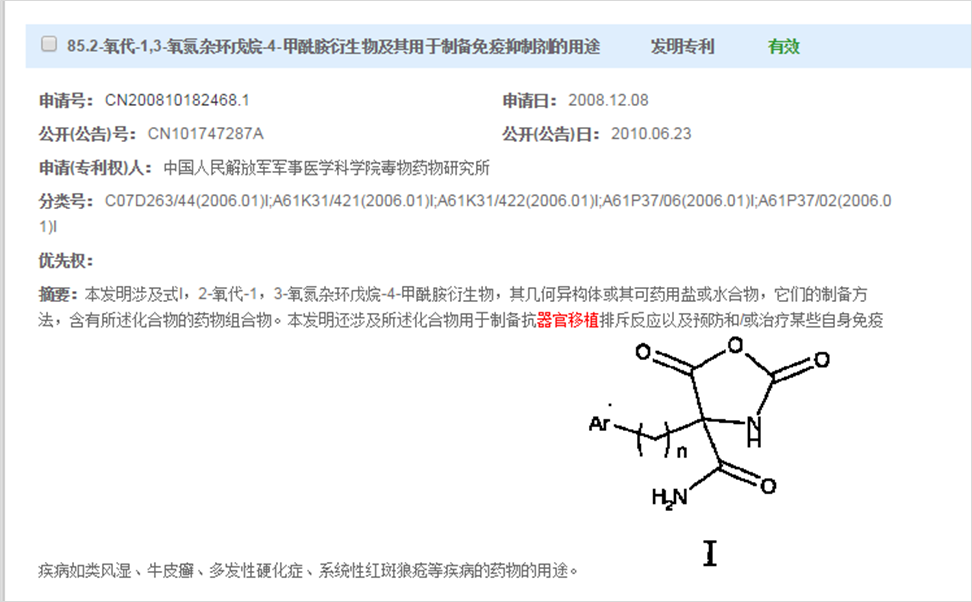
Figure 9.1 A patent for an immunosuppressant for organ transplants by the Academy of Military Medical Sciences.
3) An archived webpage of Shanghai Changzheng Hospital showed “98 percent of Chinese hospitals use the organ preservation solution developed by our hospital”
Shanghai Changzheng Hospital of the Second Military Medical University was one of the first hospitalsto conduct kidney transplant surgeries. With the support of Shanghai Science and Technology Commission, Zhu Youhua, a member of the Military Organ Transplantation Institute, and his team led the way in finishing the research on the kidney and multi-organ preservation solution, and put it into clinical application for 20 years, so that China’s research in this field is at the forefront in the world.[179]As displayed on Changzheng Hospital’sarchivedwebpage, "98 percent ofChinese hospitals usethe organ preservation solution we’ve developed.”[180]
This hospital has conducted a startling number of emergency liver transplants.The minimum waiting time for surgery was just four hours after the patient had been admitted. Zhu Youhuahad personally completed 3,680 cases of kidney transplantsby the end of 2010.[181]
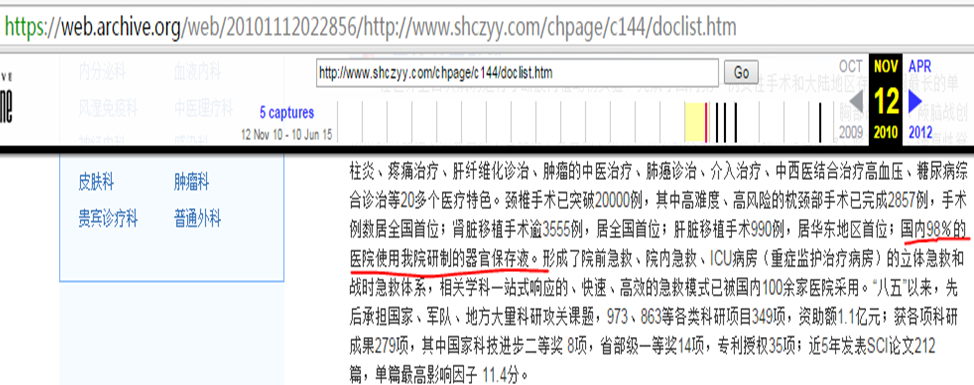
Figure 9.2 Archived web page of Shanghai Changzheng Hospital of the Second Military Medical University
Military institutes, regional medical universities, hospitals and pharmaceutical institutesare also involved in thisresearch and development. For example, the Organ Transplantation Institute of China Medical University has also taken part in the research and development of an organ preservation solution, and developed a kidney preservation solution. The institute claims it is at the forefront domestically in its research into organ preservation.[182]
We believe that such research, development and production of key transplant drugs are not initiated by the individual transplant centers themselves, but are insteaddictated by the CCP as part of its support for carrying out nationwide organ harvesting.
4) Profiteering through bloody organ harvesting
The General Logistics Department allocates donors to military hospitals and some local hospitals through multiple channels. Its operation model is to be paid directly in cash (foreign currency) when providing donors to the hospital, with the hospital self-financing the pay out to the General Logistics Department. Military hospitals play a predominant role in carrying out transplant operations. Organs sold to local medical institutes are just for extra profit, with the wider aim to utilize local hospitals as advertising for overseas transplant patients. If military hospitals were the only ones performing transplant operations, the truth about organ harvesting would be easily uncovered.[183]
Since profits from transplants would not be accounted for in the military budget, and the layers of the organ harvesting system are maintained by the military, organ harvesting from living Falun Gong practitioners and organ trafficking have become a way of making money with low costs, and military officials are benefitting directly from the General Logistics Department’s budget.
For example, medical gross income of the organ transplant center of 309 Hospital, the "PLA Organ Transplant Center,” named by General Logistics Department Ministry of Health, increased from 30 million yuan (US$4.5 million) in 2006 to 230 million yuan (US$34.6 million) in 2010, a 5-year growth of nearly 800 percent.[184]
In another example, Daping Hospital of the No.3 Military Medical University started performing organ transplants in the late 1990s, and the annual income of the hospital increased from 36 million yuan (US$5.4 million) to over 900 million yuan (US$135.5 million). This wasan increase of 25 times the hospital’s income in the 1990s.[185]
Chapter 10: Other Means through which Falun Gong Practitioners Have Been Subjected to Genocide
Throughout the course of the persecution of Falun Gong, aside from state-sanctioned organ harvesting, the CCP has conducted extensive psychological tests on the dying process, drug tests, other human subject tests and even autopsy lectures using Falun Gong practitioners. The CCP has even gone as far as making the bodies of Falun Gong practitioners, including the remains of practitioners who were tortured to death, into scientific specimens using the method of “plastination.” These plastified bodies and body parts were then displayed in major cities around the world in profit-driven body exhibitions.
The figures referenced in this chapter provide evidence from a different perspective demonstrating that the total number of victims slaughtered in fact must be even greater!
I. Wang Lijun and his human subject tests
WOIPFG discovered that the CCP is suspected of conducting human subject tests using a great many Falun Gong practitioners. One of the key figures involved is Wang Lijun, former deputy mayor of Chongqing and former chief of the Public Security Bureau of Chongqing municipality.
On February 6, 2012, Wang Lijun abruptly visited the U.S. Consulate in Chongqing requesting political asylum, but Wang’s request was denied. News about this incident made Wang Lijun well known worldwide.
1. Jinzhou City Public Security Bureau On Site Psychological Research Center[186]:
The Center conducted“Research on Organ Transplantation from Donors Who Have Been Subjected to Drug Injections” using thousands of living candidates; a doctor whose ranking is equivalent to a general officer from the PLA No. 205 Hospital who cooperated in this research admitted using organs from Falun Gong practitioners
In May 2003, Wang Lijun was reassigned to Jinzhou City, Liaoning, and took on the positions of chief of the Public Security Bureau, and Party Committee Secretary. At the time, Bo Xilai held the titles of vice secretary of the Liaoning Provincial Party Committee, and Governor of the province. Wang worked under both the Ministry of Public Security and Provincial Party Committee. Shortly after Wang took office, he established the “On Site Psychological Research Center,” a facility operating under the Jinzhou Public Security Bureau. Wanghad no medical background, an education level of only middle school, and was formerly transferred from positions in the military, yet he became the director, professor, researcher and a forensic expert at this research center. China’s CCTV news report from 2004 states that this is “the only onsite psychological research center under the Chinese police system” and it is administered by the most senior police administrators of the CCP.[187]
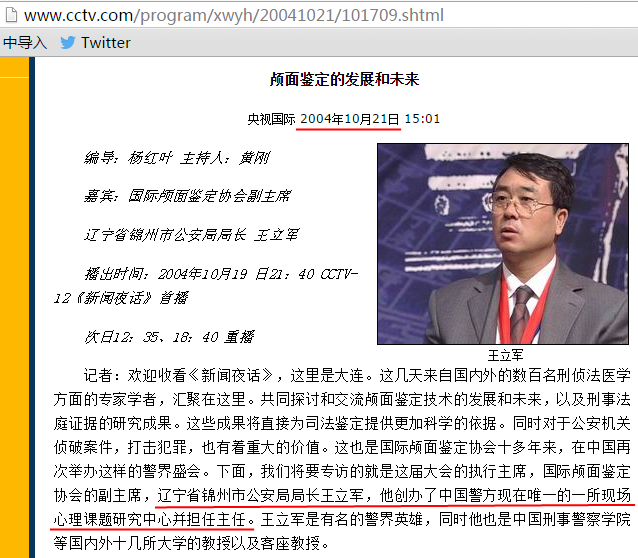
Figure 10.1 Snapshot of the article published on CCTV's International Channel
According to WOIPFG’s investigation, the On Site Psychological Research Center (OSPRC) performed “research” on human subjects awaiting execution, with the aim of studying the dying process. Such “research”included “a person’s psychological changes when facing death,” “changes in vital signs”[188]and the toxic residuals in different organs after lethal injection. These victims might have been killed by lethal injection and/or the direct excision of human organs.
On September 17, 2006, Wang Lijun and his OSPRC’s “Research on Organ Transplantation from Donors Who Have Been Subjected to Drug Injection”[189]were awarded the “Guanghua Innovation Special Contribution Award”by the China Guanghua Science and Technology Foundation,[190]along with a research grant of 2 million yuan (US$300,000).[191]Both the secretary of theGuanghua Foundation, Ren Jinyangand Wang Lijun spoke at the award ceremony. Their speeches revealed that the research center had used several thousand living candidates to conduct executions and organ transplants. The subject of their research included a new fluid formula for organ preservation used on organs taken from bodies executed through lethal injection.
At the award ceremony for the Guanghua Innovation Special Contribution Award, Ren Jinyang saidin his speech, "Professor Wang Lijun and the Research Center conducted basic research and clinic trials to study how to resolve the challenging issue, which is that the organ transplant recipients are generally not very receptive to organs injected with drugs. They have created a brand new preservation solution, which is used to provide a perfusion treatment for livers and kidneys previously subjected to drugs. After animal tests, in vitro experiments and clinical trials they have achieved an important milestone where the recipient's body is able to accept the liver and kidney after such a treatment.”[192]
When talking about his research “achievements,” Wang Lijun emphasized, “Our research site and our scientific and technological achievements are the crystallization of several thousand intensive onsite cases; they are the results of the painstaking efforts by so many of us…Jin Yang, the secretary-general of China Guanghua Science and Technology Foundation, and his staff were right there at our site, the very scene of our anatomization and the very spot of transplanting organs into the recipients.As a police officer with years in the service, when I see that the life of an executed prisoner is extended in the bodies of several people in merely minutes, I still feel blown away.”[193]
According to Amnesty International, from 2000 to 2005, the average annual number of executions of death row prisoners in mainland China was 1616.[194]By December 31, 2004, China had 333 prefecture-level cities. Where would sucha small city like Jinzhou find several thousand human test subjects for onsite drug injections?
Jinzhou On Site Psychological Research Center states in its overview that Beijing University, China Medical University, and the PLA No. 205 Hospital all participated inits “Organ Transplantation from Donors Who Have Been Subjected to Drug Injection” research.[195]
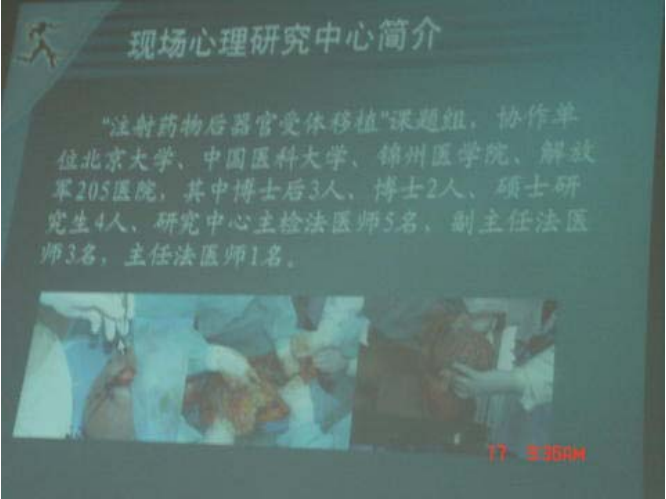
Figure 10.2 Overview of Jinzhou On Site Psychological Research Center indicates that Beijing University, China Medical University, and PLA 205 Hospital participated in Organ Transplantation from Donors Who Have Been Subjected toDrug Injection
In May 2012, using the name the “Special Investigation Team on Wang Lijun” WOIPFG conducted a telephone interview with Chen Rongshan, chief of the Urology Department of the PLA No. 205 Hospital. Chen Rongshanconfirmed that donor organs come from detained Falun Gong practitioners.[196]
(Recording Download:MP3)
Chen: “Hello?”
Investigator: “Hello, is this former Chief Physician Chen Rongshan of the Urology Department of the PLA No. 205 Hospital?”
Chen: “Yes, yes, yes, who are you?”
Investigator: “I’m from the Wang Lijun inter-departmental investigation team.
Chen: “Ah, ah, ah,”
Investigator: “When Wang Lijun was at the Jinzhou Public Security Bureau, he was in charge of the On-Site Psychological Research Center. The center had some joint projects with the PLA No. 205 Hospital. Can you tell me more about the projects?”
Chen: “Oh.”
Investigator: “He had a project called ‘Research on Organ Transplantation from Donors who have been subjected to Drug Injection.’The PLA No. 205 Hospital was their partner. Please tell me more about this project.”
Chen: “Ah.”
Investigator: “What I am asking is whether you have cooperated?”
Chen: “China Medical University also partnered with them.”
Investigator: “Wang Lijun told us that some organ donors were jailed Falun Gong practitioners. Is that true?”
Chen: “Those were arranged through the court.”
Investigator: “Through the court, right?”
Chen: “Yes, yes.”
Since assuming the title of chief of Chongqing Public Security Bureau, Wang Lijun conducted other human subject tests besides establishing the Southwest University and Chongqing Public Security Bureau Onsite Psychological Research Center. Notably, Wang held a patent for a “Collision Machine to cause primary brain-stem injuries,” which he developed to cause brain death. The patent inventors are listed as Wang Lijun, Yin Zhiyong, Zhao Hui and Wang Zhengguo. The patent was filed in December 2011 and was granted in the following year.
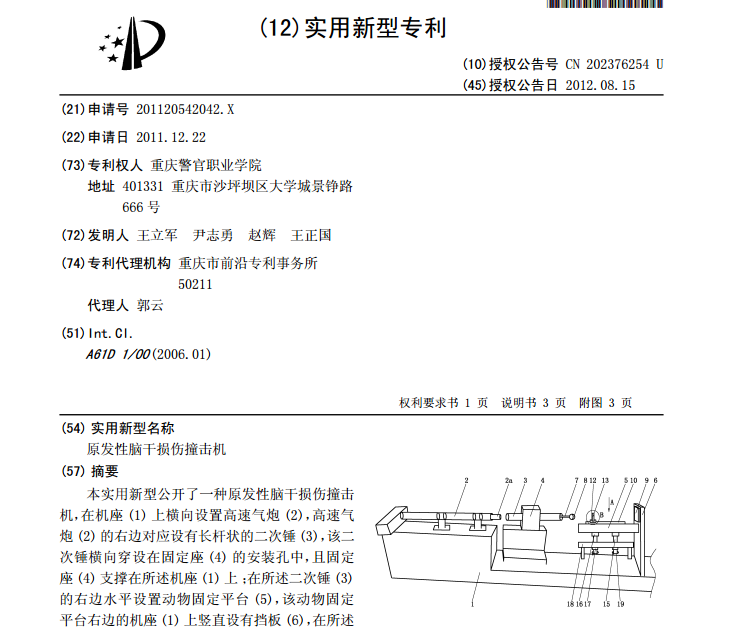
Figure 10.3 Part of the instruction manual on Wang Lijun’s patented invention: “collision machine to cause primary brain-stem injuries”
Publicly available information on this patented invention states that this is “a utility model which could, to a considerable extent, accurately prepare medium-sized animals by causing them primary brain stem injuries.”[197]
Co-inventors Yin Zhiyong, Zhao Hui and Wang Zhengguo of Daping Hospital of the Third Military Medical Universityjointly published an article in theJournal of Traumatic Surgery,in the second issue of 2008,titled “Quasi-static and Temporal Brain Injuries Caused by Collisions, Simulation Analysis and Its Clinical Significance.”[198]The article confirms that this particular patented invention wasdesignedtoresearchbrain death inhumans, and stated, “as of October 2007, 12 ‘fresh heads’of just-dead corpses had been used for collision experiments. All the (head) donors were male, aged between 26 and 38, with an average age of 31.”
The invention of this machine involved a process of using the prototype machine to crack human skulls and cause brain stem injuries. It was a process of slaughtering humans, because in truth using the“heads of just-dead corpses” for the collision experiments would not serve the purpose of studying the extent of brain stem injury in humans. Just like the “organ donors” noted throughout this paper, the collision experiments must have also used living candidates.
3. Other human subject testing projects
According to the website of China Guanghua Science and Technology Foundation (CGSTF): “As the leader of Jinzhou On-Site Psychology Research Center (OSPRC) research team, Wang Lijun authored several academic papers, including “On Injury-Free Dissection,” “A Study on Organ Transplant from Donors Who Have Been Subjected to Drug Injection”and “A Study on the Time Dependence of Intestinal and Gastric Excrement of Females from Northern China.”[199]
As a police chief, for what purpose was he conducting research on the “Intestinal and Gastric Excrement of Females from Northern China?” And who were the subjects of his research?
4. Human subject research
WOIPFG believes that hospitals all across China are using Falun Gong practitioners as donors for organ transplant operations. Only some of these hospitals corroborated with Wang Lijun in conducting this human subject research. Where did these researchers manage to find their research subjects?
WOIPFG’s investigation provided an answer to this question. On May 22, 2006, a WOIPFG investigator conducted telephone investigations with relevant government agencies under Wang Lijun’s jurisdiction.A court officer from the Intermediate People’s Court of Jinzhou City [the criminal court] told the investigator that they are still able to provide kidneys extracted from Falun Gong practitioners.[200]
In 2009, WOIPFG published testimony from an armed guard who had witnessed live organ harvestingfrom a Falun Gong practitioner. The witness had worked under Wang Lijunas a policeman at that time. He said that Wang had issued a strict order to the police that with regard to Falun Gong practitioners, "we must arrest them all and kill them all.”[201]
II. The secret behind the world’slargest exporter of plastinatedhuman body specimens
WOIPFG’s investigation indicates:
1. China has become the largest exporter of plastinated human body specimens[202]
There are several dozen human body plastination factories in China. Among these, the Von Hagens factory and Sui Hongjin’s Dalian Hoffenlocated in Dalian City are the largest. The other factories amount to only 10 percent of the business.[203]
Oriental Outlook Weeklyreported on November 24, 2003, that Von HagensPlastination Co., Ltd has over the course of four years, sold many human specimens made from Chinese corpses to the rest of the world, reaping hundreds of millions of dollars in profit.[204]
From 2004 to the end of 2012, multiple human body exhibitions run by Sui Hongjin appeared in more than 60 cities in over 20 countries.
China’s several dozenplastination factories were only established after the persecution of Falun Gong launched in 1999. Von HagensPlastination Co., Ltd and Dalian Hoffen were the earliest factories.
1) Bo Xilai, then Mayor of Dalian City, approved and commended the establishment of Von Hagens’splastination company
2) Sui Hongjin established a separate factory and received support from CCP officials at various levels
3) The CCP Publicity Department and the Ministry of Health took steps to mitigate “social controversy” surrounding Sui Hongjin’s exhibition
3. The mystery surrounding the source of the bodies: the Chinese Police
1) The human body plastination process requires “fresh cadavers” in their entirety that have not undergone any processes of preservation.
From all the lab reports, papers and notices that have been released to the public, it is clear that they all emphasized the use of “fresh” bodiesfor the “plastination” process. Because plastination requires fresh cadavers in their entirety that have not undergone anypreservation.For instance, on December 29, 2001, Hagens received an encrypted email from Sui Hongjin, who served as the manager of Hagen’splastination factory in Dalian, China. The email read, “This morning, two fresh, top quality corpses arrived at the factory. Their livers had been removed only a few hours ago.”[205]
2) According to Gunter von Hagens, you can’t get any donated bodies in China
On Oct. 21, 2003, Hagens received an email from a subordinate, "So far, we haven’t received any donated bodies in China.”[206]On Aug. 17, 2012, Gunter Von Hagens’ son told Deutsche Welle that until then they had received only one Chinese cadaver.[207]
3) Most “fresh cadavers” were obtained through the Public Security Bureau, the Procuratorate and the legal systems
In 2004, the German news magazineDer Spiegalobtained evidence[208]through onsite inspection, confirming that in the “fetus and infant database” maintained by the Von HagensPlastination factory in Dalian, there was a detailed record of a nine-month-old fetus. The “origin” of the fetus was clearly written as “Public Security Bureau.” But how could a nine-month-old fetus come from the Public Security Bureau?
A May 2008 settlement with the attorney general of New York obliged Premier Exhibitions, Sui Hongjin’s exhibition partner, to publish a disclaimer on its website and at the exhibition hall.[209]The disclaimer reads, “This exhibit displays human remains of Chinese citizens or residents which were originally received by the Chinese Bureau of Police,” and “Premier cannot independently verify that the human remains you are viewing are not those of persons who were incarcerated in Chinese prisons.”

Figure 10.4 Premier Exhibitions, Inc. Publishes Disclaimer on its Website
4) Sui Hongjin stated that none of the corpses were from donors or executed prisoners, and that some corpses were from the Dalian Public Security Bureau
TheSouthern Metropolis Dailyconducted face-to-face, telephone and email interviewson August 17, 20, and 21, 2012 respectively with Sui Hongjin. During the interviews, he said, "In fact, none of the cadavers were from executed prisoners. Since the first day of Dalian Hoffen, we have never used any such corpses!” Sui Hongjin said, “So far none of the bodies we use for plastination are from donation.”[210]
In 2012, WOIPFG investigator conducted a recorded investigation with Sui Hongjin, who said that some “corpses” were from the Dalian Public Security Bureau.(Download recording:MP3)
Investigator: “What is the main source of the corpses your company used?”
Sui: “A few dozen were from the Public Security Bureau. That’s it, from the Public Security.”
Among Sui’s plastinated specimens, one is a standing female specimen with abdominal cavity exposed, showing a three-month old fetus. According to Chinese law, pregnant women cannot be given the death penalty. Even if this woman died in a car accident, her family would never allow their loved ones’ bodies to be made into human specimens. But according to Sui Hongjin, all specimens could only have come from the police bureau. So what really happened?
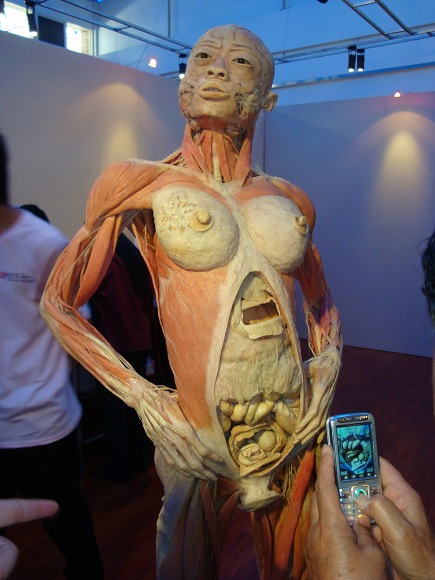
Figure 10.5 Full Body Female with Fetus
4. Investigation shows that some cadavers were of Falun Gong practitioners
WOIPFG’s telephone interviews uncovered that some human specimens came from Falun Gong practitioners.
1) Investigation conducted on the deputy mayor of Dalian, Sun Guangtian:
On September 18, 2012, a WOIPFG investigator, disguised as the secretary of Xia Deren, the deputy secretariat of Liaoning’s Provincial Party Committee, conducted an interview with Sun Guangtian, the incumbent deputy mayor of Dalian, who served as chief of Dalian Public Security Bureau from 2000-2003. The interview focused on collecting evidence about the involvement of BoXilai and his wife GuKailai in selling the corpses of Falun Gong practitioners: (Download recording: MP3)
Investigator: “This is the secretary of deputy secretariat Xia Deren of the provincial Party committee of Liaoning. Secretariat Xia asked me to pass on a message to you.”
Sun Guangtian:“Go on.”
Investigator: “Many things have happened, and no matter what, you cannot disclose that BoXilai’s wife GuKailai is involved in selling the corpses of Falun Gong practitioners…”
Sun Guangtian: “Mmm. What else do you want to say?”
Investigator: “Secretariat Xia would like you to pass on the message to relevant insiders who worked at Dalian Public Security Bureau at the time that they need to be careful not to leak this information.”
Sun Guangtian: “Please tell Secretariat Xia that he can trust me to carry this out.”
2) Investigation conducted on a director of the “610 office” in Ji County, Tianjin:
In September 2013, Director Zhao of the “610 office” in Ji County, Tianjin admitted that Bo Xilai’s wife, GuKailai, was involved in stealing and selling the organs and cadavers of Falun Gong practitioners.(Download Recording:MP3)
Investigator: “Do you know that you guys are a criminal group?”
Zhao: “I am [610 Office]. Who are you?”
Investigator: “Once the persecution ends, have you ever thought about what will happen to you? See what happened to Gu Kalai [the wife of Bo Xilai]?”
Zhao: “GuKalai was selling organs of Falun Gongpractitioners.”
Investigator: “Yes, she had two human cadaver plastination factories in Dalian. She sold plastinated full-body cadavers for one million U.S. dollars each; the cadavers without internal organs were sold for $800,000 USD. What a devil.”
Zhao: “What she sold were not all from Falun Gong practitioners.”
Chapter 11 Chinese Human Organs have been Trafficked to Foreign Countries, Dignity for All Human Beings and Morals are Trampled upon in This Regard
In August 2007, Israeli police arrested 4 human organ smugglers, who admitted that the organs they sold were from the CCP’s political prisoners, executed prisoners and Falun Gong practitioners. This piece of news was published on the largest Israeli newspaper.
Facing the CCP’s evil crimes against humanity, what can we do?
- We can tell our families, friends, relatives, colleagues and others about the facts of the CCP’s organ harvesting from living Falun Gong practitioners.Let the whole world know the truth, let all humanity come together to stop the CCP’s evil crimes against humanity.
- Help track and collect the names of those involved in the persecution of Falun Gong and the related evidence, and report them to WOIPFG. Let’s work together to prepare for the grand trial in history.
WOIPFG’s principles are: whoever has committed the crime is responsible for it, individuals are responsible for group organized crimes, instigating a crime is the same as directly committing a crime. Based on these principals, all the crimes conducted in the name of organizations, units and systems will eventually be the responsibility of the individuals. All the responsible persons, who have participated in the persecution of Falun Gong, will be investigated completely and brought to justice.
The persecution of Falun Gongpractitioners is a genocide and a crime against humanity. Most notably, harvesting organs from Falun Gong practitioners is a state-sanctioned crime initiated by Jiang Zemin and implemented by the CCP. All that have taken part in organ harvesting, regardless of whether the participating entity is a nation, an organization or an individual, must be held responsible and be condemned and punished by law. It is the responsibility and privilege of every nation, organization and individual to take part in fully exposing and putting a stop to the CCP’s crimes against humanity.
In his opening statement at the well-known International Military Tribunal in Nuremberg for the prosecution of Nazi war criminals after WWII, the United States Solicitor General, Robert H. Jackson said, “The wrongs which we seek to condemn and punish have been so calculated, so malignant, and so devastating, that civilization cannot tolerate their being ignored, because it cannot survive their being repeated.”
It is devastating that crimes similar in nature to those committed by the Nazis have indeed been committed again! In the face of such evil, the survival of civilization is at risk!
As members of the international community, we abide by the promise of “Never Again”. WOIPFG will as always investigate the criminal conduct of all institutions, organizations and individuals involved in the persecution of Falun Gong, no matter how long it takes, no matter how far and deep we have to search to full closure to exercise fundamental principles of humanity, and to restore and uphold justice in society. This our promise to the international society, and we will never give up.
-----------------------------------------
[i] xj.xinhuanet.com/bt/2005-10/03/content_5275137.htm
[ii] Phoenix Weekly, "the Dark Secrets of China's Human Organ Trafficing", November 5, 2013
WOIPFG Archive Link: http://www.zhuichaguoji.org/cn/images/nationalcriminalreports/274.png
[iii] xj.xinhuanet.com/bt/2005-10/03/content_5275137.htm
[iv] Phoenix Weekly, "The Dark Secrets of China's Human Organ Trafficing", November 5, 2013
WOIPFG Archive Link: http://www.zhuichaguoji.org/cn/images/nationalcriminalreports/274.png
[1] (2010, Mar. 26). The maze of organ donation: visible organs, invisible donors. Southern Weekend.Retrieved from: http://news.163.com/10/0326/10/62MP5K0G00011SM9.html
WOIPFG archived link: http://www.zhuichaguoji.org/cn/images/nationalcriminalreports/10.jpg
[2]China Liver Transplant Registry Network Statistics.Retrieved from http://cltr.org/.
WOIPFG archived link: http://www.zhuichaguoji.org/sites/default/files/report/2015/59389_11.png
[3] The number of liver transplantation registration. Chinese Liver Transplantation Registration Website. WOIPFG archived link: http://www.zhuichaguoji.org/sites/default/files/report/2015/59389_12.png
[4]Website: http://www.baike.com/ Organ Transplant Tourism
[5]“China Organ Transplant Network”. October 10, 2008. Oriental Organ Transplant Center Chronicle of Major Events. Source: Tianjin Daily website
http://www.transplantation.org.cn/ZTianJinDiYiZhongXinYiYuanKuaiXun/2008-10/3093.htm
[6] “Oriental Organ Transplant Center”. January 5, 2006. “2005 Year-end Summary Assembly of the Center”.
http://www.ootc.net/HomePage/FileDocDetail.aspx?fileno=494
[7]“Chinese Journal of General Surgery” 2003, Vol.18, Issue 02 P.71-73. “Liver Transplantation Experience Review”. Authors: ZHENG Shusen, LIANG Yanbo, XU Xiao, WANG Weilin, SHEN Yan, HUANG Dongsheng (310003,Hangzhou, Zhejiang University No.1 Affiliate Hospital Hepatobiliary and pancreatic surgery and Organ Transplantation Center ).
http://new.med.wanfangdata.com.cn/Paper/Detail?id=PeriodicalPaper_zhptwk...
[9]The Matching Process.U.S. Department of Health and Human Services. Retrieved from OrganDonor.Gov.
WOIPFG archived link: http://www.zhuichaguoji.org/cn/images/nationalcriminalreports/57.png
[10]Profile of Oriental Organ Transplant Center.
WOIPFG archived link: http://www.zhuichaguoji.org/cn/images/nationalcriminalreports/200.png
[11] (2006). Report on Liver Transplantation in 2006. China Liver Transplant Registry.
WOIPFG archived link: http://www.upholdjustice.org/upload/images/nationalcriminalreports/192.pdf
[12] Fu Zhiren, Ma Jun. (2006, Jun.). Prognosis Factors and Treatment for Serious Hepatitis Emergency Transplantation.Journal of Clinical Surgery June 2006, Volume 14, Number 6.
WOIPFG archived link:http://www.upholdjustice.org/upload/images/nationalcriminalreports/195.pdf
[13] (2006, Jan. 6). Zhejiang Wanli College Digital Library.Huaxia Net.
[14] (2015, Nov. 27). WOIPFG: The Chinese Communist regime continues its campaign of forced organ harvesting from living Falun Gong practitioners.
WOIPFG link: http://www.upholdjustice.org/node/330
[15]The meritorious deeds of Tan Jianmin. paper.people.com.cn
Retrieved from: http://health.people.com.cn/n/2014/0604/c385611-25104541.html
WOIPFG Archived Link: http://www.upholdjustice.org/upload/images/nationalcriminalreports/172.png
[16] (2013, Nov. 5). Human organ trade in China, the story behind the dark curtain. iFeng Weekly. Retrieved from: http://www.51fenghuang.com/news/shehui/2514.html
WOIPFG archived link: http://www.upholdjustice.org/upload/images/nationalcriminalreports/274.png
[17] Pan Deng, Ye Qing (reporters). (2005, Oct. 3). China’s first successful liver transplant was completed in Xinjiang. Urumqi Online.
Retrieved from: www.xj.xinhuanet.com/bt/2005-10/03/content_5275137.htm
[18]A brief history of urological surgeries at the Military Kidney Clinical Center. (Investigation Clue: Military Kidney Clinical Center Urinary Surgery Department Carried out 24 Kidney Transplant Operations in One Day)
Retrieved from: http://www.minghui.org/mh/article_images/2007-9-12-image001.jpg
[19] (2010, Oct. 1). Investigation of foreigners coming to China for organ transplants. iFeng Weekly. Retrieved from: http://www.51fenghuang.com/news/fengmiangushi/wgrfhqgyz.html
WOIPFG archived link: http://www.upholdjustice.org/upload/images/nationalcriminalreports/252.png
[20] (2006, Mar. 14). Renewing life through organ transplantation. Guangzhou Daily.
Retrieved from: https://web.archive.org/web/20071010072726/http://gzdaily.dayoo.com/gb/c...
WOIPFG archived link: http://www.upholdjustice.org/upload/images/nationalcriminalreports/238.png
[21](2005, Jun. 3). Performed 1 case of liver, 6 cases of kidney and 8 cases of corneal transplants at one day. Xiangya Hospital of Central South University.
Retrieved from: http://www1.renminbao.com/rmb/article_images/2006-5-30-changsha06.jpg
[22](2005, Sep. 3). We conducted 7 cases of heart-liver-kidney surgery at one day. Xiangya Hospital of Central South University.
Retrieved from: http://www1.renminbao.com/rmb/article_images/2006-5-30-changsha05.jpg
[23](2006, May. 14).Newsletter of Xiangya Hospital: our hospital set new record in organ transplants: liver transplant, kidney transplant, corneal transplant, 17 operations completed in one day.
Retrieved from: http://www.xiangya.com.cn/medpro/xyyx/zhyx/2006-05-14/ medpro _20060514165311.html
WOIPFG archived link:http://www.upholdjustice.org/upload/images/nationalcriminalreports/250.jpg
[24] (2008, Dec. 1). The General Hospital of Jinan Military Region.Qilu Evening News.
Retrieved from: http://paper.dzwww.com/qlwb/data/20081201/html/65/content_1.html
WOIPFG archived link: http://www.zhuichaguoji.org/cn/images/nationalcriminalreports/663.png
[25]Huang Shuping, Wu Zhi. (2014, Mar. 10). No sleep and rest for 17 hours and completed 5 liver transplantation operations. Chinese Organ Transplantation Web.
Retrieved from: Source: http://www.dnkb.com.cn,
http://www.transplantation.org.cn/zganxiwen/2014-03/7050.htm
WOIPFG archived link:http://www.upholdjustice.org/upload/images/nationalcriminalreports/227.pdf
[26] Huang Shuping, Wu Zhi. (2014, Mar. 10). No sleep and rest for 17 hours and completed 5 liver transplantation operations. Chinese Organ Transplantation Web.
Retrieved from: http://www.dnkb.com.cn
http://www.transplantation.org.cn/zganxiwen/2014-03/7050.htm
WOIPFG archived link:http://www.upholdjustice.org/upload/images/nationalcriminalreports/227.pdf
[27] "Baidu Encyclopedia" "warm ischemia time."
WOIPFG archived link: http://www.zhuichaguoji.org/cn/images/medicalarticles/5.png
[28]Warm ischemia. Baidu Encyclopedia.
Retrieved from http://baike.baidu.com/view/4504011.htm
WOIPFG archived link: http://www.zhuichaguoji.org/cn/images/medicalarticles/5.png
[29] “National Cancer Institute”. Cold ischemia time.
[30] Chinese 315 Faith Website. Ministry of Health About the management rules of transplantation of liver, kidney, heart and lung.
[31] Overview of the Support Center of China International Transplantation
WOIPFG archived link:
http://www.zhuichaguoji.org/cn/images/nationalcriminalreports/541.png
[32]Yang Guofeng, Chen Daozhong, Chen Wanliang, Huang Xueshan, Wu Xijie, Liao Chongxian. (2008). A Discussion on Heart Preservation for Orthotopic Heart Transplant with 111 Case Studies. Journal of Fujian Medical University, 2008, Vol.42, Issue 6, pp 539-541
[33]Li Yaofeng, Zhouding Hua, Wan Bao Dong, Zhao Wei, Xiaqi Jun, Wei Bing. (2007). Surgery type affects patients’ liver function after liver transplantation. Chinese General Practice, Vol. 10 Issue 23 page 1947-1950
WOIPFG archived link:
http://www.upholdjustice.org/upload/images/nationalcriminalreports/64.pdf
[34]Fuzhi Ren, Wang Xin, Ding Guoshan, Fu Wang, Zhang Jianjun, Lixian Xing, Ka Ni, Guo Wen Yuan, Shi Xiao Min, Cao Xiaowei, Shi Yong Zhao. (2004). Analysis of 231 case studies (240 times) of liver transplant. Shanghai Medical Journal, Vol. 27 Issue 11 Pages 805-807.
WOIPFG archived link:
http://www.upholdjustice.org/upload/images/nationalcriminalreports/65.pdf
[35]QinjianJie, Xia Yongxiang, Wu Lapsang, Zhang Feng, Wang Xuehao. (2009). Measures to deal with biliary complications after liver transplantation. Contemporary Chinese Medicine. 2009, Vol. 16 (04). pp 12-14
WOIPFG Archived Link: http://www.upholdjustice.org/upload/images/nationalcriminalreports/6301.pdf
http://www.upholdjustice.org/upload/images/nationalcriminalreports/6302.pdf
http://www.upholdjustice.org/upload/images/nationalcriminalreports/6303.pdf
[36]Yang Guofeng, Chen Daozhong, Chen Wanliang, Huang Xueshan, Wu Xijie, Liao Chongxian. (2008). A Discussion on Heart Preservation for Orthotopic Heart Transplant with 111 Case Studies. Journal of Fujian Medical University, 2008, Vol.42, Issue 6, pp 539-541
[37]Xu Qingxiang, Wu Yafu, Chou Yudong, Wu Xingyu, Li Qiang, Ding Yitao. (2008). On the causes and treatments for abdominal abscesses following liver transplant. Chinese Journal of Organ Transplantation, 2008, Vol. 29, Issue 12, pp 715-717.
[38]Yang Dinghua, Peng Minhao, Lu Bangyu, Chen Xigang, Liu Jingchen, Chen Bin, Xiao Kaiyin, Li Lequn, Qin Xiao, Peng Tao, Qin Zhong. (2004). Nineteen successful cases of piggyback liver transplants. Guangxi Medical Journal, 2004, Vol. 26, Issue 9, pp 1252-1254.
[39]Wang Ruiguan, Li Hucheng, Zou Yiping, Huanghui. (2010). On the causes and treatments of hyperbilirubinemia following liver transplant. Infection Inflammation Repair, 2010, Vol. 11, Issue 3, pp 157-160.
[40]Chen Huanwei, Zhen Zuojun, Liao Shan, CaiYunfeng. (2009). The role of choledochojejunostomy in liver transplant. Chinese Journal of Hepatobiliary Surgery, 2009, vol. 15, Issue 2, pp 96-99.
[41]Huo Feng, Wang Shaoping, Li Peng, Pu Miaoshui, Chen Jianxiong, Zhan Shilin, Zheng Yujian, Xia Wuzheng. (2012). Cardiac arrest citizen donates organ to liver transplant patient. Chinese Journal of Digestive Surgery, 2012, Vol. 11, Issue 1, pp 69-72.
[42]Zhou Guangwen, Peng Chenghong, Tao Zongyuan, Wang Lin, Yan Jiqi, Shen Chuan, Chen Yongjun, Li Qinyu, Yang Weiping, Li Hongwei. (2007). Diagnosis and surgical treatments for short- and long-term biliary complications following liver transplant. International Journal of Surgery, 2007, Vol. 34, Issue 02, pp 87-89.
[43] Yu Lei, Li Jianping, Hu Minghua, JinHuihan, Zhu Laifa, Dai Tu. (2004). Five case studies of orthotopic liver transplant.ActaAcademiaeMedicinae Nantong, 2004, Vol. 24, Issue 1, pp 82, 82-84.
WOIPFG archived link: http://www.zhuichaguoji.org/cn/images/medicalarticles/5401.pdf
http://www.zhuichaguoji.org/cn/images/medicalarticles/5402.pdf
[44]Ye Yuanyuan, Chen Lili. (2005, Mar.). On the role of nursing in heart preservation for orthotopic heart transplant. Chinese Nursing Research, 2005, Vol. 19, Issue 3 (Total No. 139)
WOIPFG archived link: http://www.zhuichaguoji.org/cn/images/medicalarticles/53.pdf
[45]Qin Jianjie, Xia Yongxiang, Wu Zhengshan, Zhang Feng, Wang Xuehao. (2009). Treatments for biliary complications following liver transplant. China Modern Medicine, 2009, Vol. 16, Issue 4, pp 12-14.
WOIPFG archived link: http://www.zhuichaguoji.org/cn/images/medicalarticles/5601.pdf
http://www.zhuichaguoji.org/cn/images/medicalarticles/5602.pdf
http://www.zhuichaguoji.org/cn/images/medicalarticles/5603.pdf
[46]Peng Shuyou, Peng Chenghong, Wu Yulian, Xu Peihua, Zhou Fan, Shen Hongwei, Xu Bin, Jiang Xianchuan, Liu Yingbin, Fan Mingmin, Xu Shiwei. (2002). Ten successful cases of liver transplant performed consecutively. Journal of Surgery Concepts and Practice, 2002, Vol. 7, Issue 2, pp 134-138.
WOIPFG archived link: http://www.zhuichaguoji.org/cn/images/medicalarticles/5701.pdf
http://www.zhuichaguoji.org/cn/images/medicalarticles/5702.pdf
http://www.zhuichaguoji.org/cn/images/medicalarticles/5703.pdf
http://www.zhuichaguoji.org/cn/images/medicalarticles/5704.pdf http://www.zhuichaguoji.org/cn/images/medicalarticles/5705.pdf
[47]Sheng Yuping, Yuan Lingling, GaoFumin. (2004). Analysis of cardiopulmonary bypass in 4 cases of orthotopic heart transplants.ActaAcademiaeMedicinae Nantong, 2004, Vol. 24, Issue 3, pp 336, 338.
WOIPFG archived link: http://www.zhuichaguoji.org/cn/images/medicalarticles/5801.pdf
http://www.zhuichaguoji.org/cn/images/medicalarticles/5802.pdf
[48]Li Qiang, Wu Xingyu, Shi Xiaolei, Wu Yafu, Ding Yitao. (2005). Refinement and application of joint cadaveric liver and kidney extraction method. Modern Medical Journal, 2005, Vol. 33, Issue 6, pp 386-388.
WOIPFG archived link: http://www.zhuichaguoji.org/cn/images/medicalarticles/59.pdf
[49]Li Yaofeng, Zhou Dinghua, Wan Baodong, Zhao Wei, Xia Qijun, Wei Bing. (2007). The impact surgery approach has on liver functions during perioperative time of liver transplant. Chinese General Practice, 2007, Vol. 10, Issue 23, pp 1947-1950.
WOIPFG archived link: http://www.zhuichaguoji.org/cn/images/medicalarticles/60.pdf
[50] Fu Zhiren, Wang Zhengxin, Ding Guoshan, Fu Hong, Zhang Jianjun, Li Xianxing, Ni Zhijia, GuoWenyuan, Shi Xiaomin, Cao Xiaowei, Shi Yongzhao. (2004). Review and analysis of approaches used in 231 cases (240 times) of liver transplants. Shanghai Medical Journal, 2004, Vol. 27, Issue 11, pp 805-807.
WOIPFG archived link: http://www.zhuichaguoji.org/cn/images/medicalarticles/61.pdf
[51]Xin Jun, Wang Houqiang, Zhou Jianping, Lu Jun, Wang Nianzu. (2006, Mar. 1). Preliminary summary of 4 case studies of orthotopic heart transplants. Data compilation from the Second Annual Conference of Chinese Association of Cardiovascular Surgeons.
WOIPFG archived link: http://www.zhuichaguoji.org/cn/images/medicalarticles/62.pdf
[52]Lin Yanjuan, Jiang Xiaoying. (2010). On monitoring and nursing hemodynamics immediately following orthotopic heart transplant. Chinese Journal of Modern Nursing, 2010, Vol. 16, Issue 13, pp 1519-1520.
WOIPFG archived link: http://www.zhuichaguoji.org/cn/images/medicalarticles/6301.pdf
http://www.zhuichaguoji.org/cn/images/medicalarticles/6302.pdf
[53] Wang Wujun, Zhang Zhen, Zou Xiaoming. (2001, May). Anti-rejection treatments after heart transplant. Guangdong Medical Journal, 2001, Vol. 22, Issue 5.
WOIPFG archived link:http://www.zhuichaguoji.org/cn/images/medicalarticles/55.pdf
[54] Xu Longgen, Song Qizhe, Wang Xinhong, Xu Jianying, ChenLiying. (2003). Clinical analysis on 294 cases of orthotopic kidney transplants. Zhejiang Medical Journal, 2003, Vol. 25, Issue 1, pp 54-55.
[55] Liu Yuhang, Zhou Gengxu, Zhang Wenhui, Liu Jianshi, Shen Zhongyang. (2008). Seven cases of the treatment of terminal cardiomyopathy through orthotopic heart transplant. Tianjin Medical Journal, 2008, Vol. 36, Issue 3, pp 176-178.
[56] Song Kang, Fan Jia, Zhou Jian, Wu Zhiquan, QiuShuangjian, Huang Xiaowu, Sun Jian, He Yifeng, Xiao Yongsheng, Shi Yinghong, Sun Qiman, Tang Zhaoyou. (2008). Refinement and clinical research of joint liver and kidney rapid extraction (117 case studies attached). Fudan University Journal of Medical Sciences, 2008, Vol. 35, Issue 1, pp 17-20.
[57] Lin Yixiong, Zhou Jie, Lin Jianhua, Wang Yu, Zhang Guowei, Cui Zhonglin, Li Xianghong, Tan Yongfa. (2010). Clinical studies on liver procurement and reparation for liver transplant. Journal of First Military Medical University, 2010, Vol. 30, Issue 5, pp 1012-1014.
[58] Song Shaowei, Liu Yongfeng. (2008). Techniques on extraction and reparation in joint pancreas-kidney transplant. Chinese Journal of General Surgery, 2008, Vol. 17, Issue 3, pp 267-269.
[59] Xu Junming, Peng Zhihai, Xia Qiang, Dai Xueming, Zhu Zhecheng, Xu Ning, Wang Zhaowen. (2004). Discussion on improved approach for joint liver-kidney rapid extraction. Chinese Journal of General Surgery, 2004, Vol. 19, Issue 8, pp 456-458.
[60] Wang Xuan, Lu Lei, Hua Changjiang, Jiang Tao, Li Zengcai, Zhang Bin, Liu Xianzhong, Xu Zhengchang. (2009). 68 case studies of treatment for malignant hepatoma through orthotopic liver transplant. Chinese Clinical Oncology, 2009, Vol. 14, Issue 2, pp 147-149.
[61] Li Shiyong, Bai Xue, Chen Gang, Liang Zhenjia, Yuan Shujun, Yu Bo, Chen Guang, ZuoFuyi, Wei Xiaojun, Xu Yishi, Cui Wei. (2008). Clinical observations on 30 cases of orthotopic liver transplants. Medical Journal of National Defending Forces in North China, 2008, Vol. 20, Issue 2, pp 14-15.
[62] Yuan Weisheng, Wang Zhiyuan, Liu Peng, Zhang Hua, DiaoTongjin, Zheng Xiuhai, Gong Lin. (2006). Treatment during perioperative stage of allograft liver transplant. Practical Journal of Medicine and Pharmacy, 2006, Vol. 23, Issue 4, pp 400-402.
[63] Zhang Qingguang, Chen Jingyu, Gao Xuejun, Zhang Lianguo, Wang Xiaozhi, Wang Yujiu, Yang Xinfang, Wang Jianbo, Qi Mei, Wang Hongli. (2006). One case study of single lung transplant and ventricular septal defect repair. Chinese Journal of Organ Transplantation, 2006, Vol. 27, Issue 2, pp 81-83.
[64]Yu Guangsheng, Liu Jun, Xu Shifeng, Yang Fenghui, Zhou Xu, Gong Wei, Xu Yantian, Lu Jun. (2009).Clinical analysis on six case studies of joint liver-kidney transplant. Chinese Journal of General Surgery, 2009, Vol. 24, Issue 10, pp 851-852.
[65] Luo Guiyuan, Yu Xiaoman, Li Meiqing, Ma Yuxuan. (2009, Sept.).Surgery teamwork on extracting heart and lung in joint cardio-pulmonary transplant. Journal of Nurses Training, 2009, Vol. 24, Issue 18, pp 1672-1673.
[66] Chen Hailong, Qi Dejun, Yuan Huaibin. (2006). 36 case studies of orthotopic kidney transplant. Journal of Medical Forum, 2006, Vol. 27, Issue 10, pp 96-97.
[67] Gao Chongmao, Liu Hechun, Hu Qiuling, Ouyang Ting, Chen Weijian, AoZhixin, Chen Zhishui. (2002). One case study of classic orthotopic liver transplant without venovenous bypass.ActaAcademiaeMedicinae Jiangxi, 2002, Vol. 42, Issue 2, pp 92-93, 96.
[68] Yang Kang, Wu Xiongfei, Liao Chongxian, Yang Junmin, Wang Mingrong, Zeng Huichang, Zhang Wei, Xiong Gang, Wang Haidong, Wu Wei. (2001). One case study of joint heart-kidney transplant. Journal of Third Military Medical University, 2001, Vol. 23, Issue 11, pp 1327-1329.
[69]The Epoch Times Sept. 19th report, titled The police in Dandong claimed that Falun Gong practitioners forced to take blood test is mandated task – Terrible secret hidden behind.
[70] Minghui.org July 5th, 2014 report, titled Policemen in more areas visit Falun Gong practitioners at home, forcing them to take blood test.
http://en.minghui.org/html/articles/2014/7/19/2101.html
[71]The Epoch Times Sept. 19th report, titled The police in Dandong claimed that Falun Gong practitioners forced to take blood test is mandated task – Terrible secret hidden behind.
[72]Ministry of Health. http://www.moh.gov.cn/mohbgt/pw10604/200804/18344.shtml
WOIPFG archived link: http://www.upholdjustice.org/upload/images/nationalcriminalreports/274.png
[73] Investigation Indicates Suspicious Number of Kidney Transplants at Tangshan Steel Cooperation Hospital and Tianjin Armed Police Hospital. Minghui.org
Retrieved from (Chinese version):http://www.minghui.org/mh/articles/2006/4/29/126322.html
(English version):http://www.clearwisdom.net/emh/articles/2006/5/4/72799.html
[74](2006, Apr. 29). Investigation indicates suspicious number of kidney transplants at Tangshan Steel Cooperation Hospital and Tianjin Armed Police Hospital
Retrieved from: (Chinese)http://www.minghui.org/mh/articles/2006/4/29/126322.html
(English)http://www.clearwisdom.net/emh/articles/2006/5/4/72799.html
[75](2006, May. 9). Extremely tragic atrocity is still going on.
Retrieved from:http://www.minghui.org/mh/articles/2006/5/9/127277p.html
[76](2006, Apr. 28). Twenty cases of organ transplant operations for free.
Retrieved from:http://news.sina.com.cn/w/2006-04-28/08008809252s.shtml
WOIPFG archived link:http://www.upholdjustice.org/upload/images/nationalcriminalreports/277.png
[77] (2010, Nov. 17). Introduction of the Organ Transplantation Center at PLA 309 Hospital.
Retrieved from: http://www.309yy.com/_Dept/View.aspx?id=3323
WOIPFG archived link: http://www.zhuichaguoji.org/cn/images/nationalcriminalreports/35.png
[78]Huang Qi. (2006, Jun. 23). Xia Qiang--Marshal in the Discipline of Liver Transplantation.
Retrieved from: http://scitech.people.com.cn/GB/1057/4520977.html
WOIPFG archived link: http://www.zhuichaguoji.org/cn/images/nationalcriminalreports/262.png
[79] (2007, Jun. 28). Liver transplantation team of the Organ Transplantation Center of Shanghai Renji Hospital.Retrieved from:
http://www.transplantation.org.cn/ZJiaoTongDaXueYiXueYuanFuShuRenJanDui/...
WOIPFG archived link: http://www.zhuichaguoji.org/cn/images/nationalcriminalreports/623.png
[80](2007, Jun. 28). Liver transplantation team of the Organ Transplantation Center of Shanghai Renji Hospital.Retrieved from:http://www.transplantation.org.cn/ZJiaoTongDaXueYiXueYuanFuShuRenJanDui/...
WOIPFG archived link:http://www.zhuichaguoji.org/cn/images/nationalcriminalreports/623.png
[81] Introduction of the Organ Transplantation Center, Sichuang People's Hospital.
Retrieved from:http://www.samsph.com/zhongdian-content.asp?id=8399
WOIPFG archived link:http://www.zhuichaguoji.org/cn/images/nationalcriminalreports/836.pdf
[82] Introduction of Organ Transplantation Center, Sichuang People's Hospital.
Retrieved from:http://www.samsph.com/qgyzzx_intro/409/1/
WOIPFG archived link: http://www.zhuichaguoji.org/cn/images/nationalcriminalreports/836.pdf
[83]Introduction of Shanghai Eastern Hepatobiliary Surgery Hospital.
Retrieved from: http://www.ehbh.cn/intro.php
WOIPFG Archived Link: http://www.zhuichaguoji.org/sites/default/files/report/2016/64700_061901.png
[84]Shi Jie. (2015, Aug. 15). Eastern Hepatobiliary Surgery Hospital will move to Jiading, Anting, and the number of beds will double.Xinmin Evening News.
Retrieved from: http://sh.eastday.com/m/20150815/u1ai8841164.html
WOIPFG archived link:
http://www.zhuichaguoji.org/sites/default/files/report/2015/59389_495.png
/sites/default/files/201709/report/2015/325-495.png
[85](2010, Apr. 8). Etiquette development for medicine professions – exemplary services at the reputable Zhengzhou People's Hospital.
Retrieved from (Huaxia Etiquette Development website.):
http://www.liyi360.com/2010/4/8/cbdjl.htm
WOIPFG Archived Link: http://www.zhuichaguoji.org/cn/images/nationalcriminalreports/237.pdf
[86]Ibid.
[87]Gu Bo, Tan Qiling. (2013, Jun. 28). The Third Comprehensive Ward improved workflow, shorten average in-hospital stay for kidney transplant patients.
Retrieved from:http://www.cd120.com/htmlnewsdongtaixinwen/62072.jhtml
WOIPFG archived link:http://www.zhuichaguoji.org/cn/images/nationalcriminalreports/505.png
[88]WOIPFG releases the list of 7,402 medical personnel suspected of harvesting organs from living Falun Gong practitioners in 765 hospitals nationwide outside of Chinese Military Scope
WOIPFG link:http://www.zhuichaguoji.org/node/45858
WOIPFG releases the list of 2,098 medical personnel suspected of harvesting organs from living Falun Gong practitioners in 100 hospitals within the CCP’s military and Armed Police
WOIPFG link:http://www.zhuichaguoji.org/node/45100
[89]Homepage of Chinese Hospital Directory
[90] Urgent need to regulate organ transplant.
Retrieved from (China International Physician Profession Association website):
http://www.sosomy.com/articlecontent.asp?ID=313
[91]Tianjin First Central Hospital.
Retrieved from (Baidu Encyclopedia):http://baike.baidu.com/view/1367586.htm
WOIPFG archived link: http://www.zhuichaguoji.org/sites/default/files/report/2016/64700_06105.png
[92]Xu Yang. (2006, Sep. 2). Oriental Organ Transplant Center was put to Use yesterday.Tianjin Daily.
Retrieved from: http://news.sohu.com/20060902/n245125745.shtml
WOIPFG archived link: http://www.zhuichaguoji.org/cn/images/nationalcriminalreports/503.png
[93]Memorabilia of the Tianjin First Central Hospital.
Retrieved from: http://www.tj-fch.com/sitecn/dsj/1591.html
WOIPFG archived link:http://www.zhuichaguoji.org/cn/images/nationalcriminalreports/522.png
[94]Qu Lulin. (2014, Jun. 25). Tianjin First Central Hospital.
Retrieved from: http://www.sjtu.edu.cn/zdh/zzjg/fsyy.htm
WOIPFG archived link:http://www.zhuichaguoji.org/cn/images/nationalcriminalreports/497.png
[95](2014, Dec. 27). Liu Guoen: the reform of public hospitals had great potential. China's non-public medical institutions Association.
WOIPFG Archived Link:http://www.zhuichaguoji.org/cn/images/nationalcriminalreports/496.png
[96] (2015, Jan. 06). Using transplant to enlarge the hope of life - Interview of Shen Zhongyang, the experts of Tianjin liver transplant and his team.Tonight Media Group
WOIPFG archive link:http://www.zhuichaguoji.org/cn/images/nationalcriminalreports/433.png
[97](2014, Dec. 23). WOIPFG releases the list of medical personnel suspected of harvesting organs from living Falun Gong practitioners in non-military hospitals in Tianjin
WOIPFG link: http://www.zhuichaguoji.org/node/45800#_Toc405339345
[98]Introduction of Tianjin Organ Transplant Research Center.
WOIPFG archived link:http://www.zhuichaguoji.org/sites/default/files/report/2016/64700_06116.png
[99](2015, Jan. 06). Using transplant to enlarge the hope of life - Interview of Shen Zhongyang, the experts of Tianjin liver transplant and his team.Tonight Media Group
WOIPFG archive link:http://www.zhuichaguoji.org/cn/images/nationalcriminalreports/433.png
[100]Xu Yang. (2006, Sep. 2). Oriental Organ Transplant Center was put to use yesterday.Tianjin Daily.Retrieved from:http://news.sohu.com/20060902/n245125745.shtml
WOIPFG archived link:http://www.zhuichaguoji.org/cn/images/nationalcriminalreports/503.png
[101]Bed Occupancy Rate. Baidu Encyclopedia.Retrieved from:http://baike.baidu.com/view/8130584.htm
WOIPFG Archived Link: http://www.zhuichaguoji.org/sites/default/files/report/2016/64700_06103.png
[102] Introduction of the Data Center of Chinese Scientific Registry of Kidney Transplantation.
Retrieved from:http://www.309yy.com/_Dept/View.aspx?id=3323
WOIPFG archived link: http://www.zhuichaguoji.org/cn/images/nationalcriminalreports/510.png
[103]A look at the famous Transplant Center: Organ Transplant Center of PLA No. 309 Hospital.Xinhua Net.
WOIPFG archived link:http://www.zhuichaguoji.org/sites/default/files/report/2016/64700_05105.png
[104](2014, Dec. 27). Liu Guoen: the reform of public hospitals had great potential.China's non-public medical institutions Association
WOIPFG archived link:http://www.zhuichaguoji.org/cn/images/nationalcriminalreports/496.png
[105]WOIPFG Releases the List of 2,098 Medical Personnel in 100 Chinese Military and Armed Police Force Hospitals Suspected of Harvesting Organs from Living Falun Gong Practitioners.
Retrieved from: (Chinese)http://www.zhuichaguoji.org/node/45100
(English)http://www.upholdjustice.org/node/282
[106]Introduction of the 309 Clinical Department. Good Doctors Online: the largest medical website in China.Retrieved from:http://309ent.haodf.com/zhuanjiaguandian/309ent_5317.htm
WOIPFG archived link:http://www.zhuichaguoji.org/cn/images/nationalcriminalreports/222.png
[107]On specialist Li Hongdao.Western Henan Kidney Diseases and Transplant Center.
WOIPFG archived link:http://www.zhuichaguoji.org/sites/default/files/report/2015/59389_218.png
[108](2013, Sep. 3). Expert: decrease in organ supply means more patients waiting to be treated.China Economic Weekly.
Retrieved from:http://news.xinhuanet.com/legal/2013-09/03/c_125305093.htm
WOIPFG archived link:http://www.zhuichaguoji.org/cn/images/nationalcriminalreports/301.png
[109](2006, May 3). Formosa Plastic Group spent 1.18 billion on a hospital in Xiamen where organ transplant would be the important program. The Epoch Times.
Retrieved from:http://www.epochtimes.com/gb/6/5/3/n1306378.htm
[110]Overview of the Affiliated Dongnan Hospital of Xiamen University
WOIPFG archived link:http://www.zhuichaguoji.org/cn/images/nationalcriminalreports/859.png
[111](2011, Nov. 30). Cut kidney Party rampant in Wuhan, female college student killed and dumped, parents petition but battered. Sina Global News.
Retrieved from:http://dailynews.sina.com/bg/news/int/kwongwah/20111130/01082957519.html
WOIPFG archived link:http://www.zhuichaguoji.org/cn/images/nationalcriminalreports/537.png
[112](2006, Nov.11).Further investigation on Organ Transplants at Jiujiang No. 1 People's Hospital.Retrieved from:(Chinese)http://www.minghui.org/mh/articles/2006/11/11/142216.html
(English)http://www.clearwisdom.net/emh/articles/2006/11/17/79997.html
[113](2008, May. 3). Chinese hospitals fabricate and destroy organ transplant records, and other investigation leads.
Retrieved from: (Chinese)http://www.minghui.org/mh/articles/2008/5/3/177431.html
(English)http://www.clearwisdom.net/emh/articles/2008/5/25/97620.html
[114]Introduction of Organ Transplantation, Tongji Hospital, Tongji Medical College Huazhong University of Science and Technology.
Retrieved from: http://www.tjh.com.cn/Section/IndexIntro.aspx?title=%E5%99%A8%E5%AE%98%E7%A7%BB%E6%A4%8D
WOIPFG archived link:http://www.zhuichaguoji.org/sites/default/files/report/2016/64700_06405.png
[115](2011, May 11). Founder of liver surgery Wu Mengchao shared the mystery of liver disease prevention and longevity.
Retrieved from:http://health.sina.com.cn/d/2011-05-11/145222445449.shtml
WOIPFG archived link:http://www.zhuichaguoji.org/cn/images/nationalcriminalreports/441.png
[116]Song Ruliang, Cheng Lan, Chen Qunfei, Li Ling, Yuan Qiang, Wang Li, Deng Shaolin, Li Youping. (2009, Sep.). Strategy and Thoughts: Brain Death and Organ Transplant Legislation in China.Chinese Journal of Evidence-Based Medicine.Vol 4. Pp 400-407
Retrieved from:http://www.cjebm.org.cn/oa/pdfdow.aspx?Type=pdf&FileName=71bfb8e4-6680-4...
WOIPFG archived link:http://www.zhuichaguoji.org/cn/images/nationalcriminalreports/464.pdf
[117]Profile of HeXiaoshun of the Organ Transplant Department, First Affiliated Hospital of Sun Yat-Sen University. www.yynet.cn.
WOIPFG archived link:http://www.zhuichaguoji.org/cn/images/nationalcriminalreports/470.png
[118]Profile of HeXiaoshun of the Organ Transplant Department, First Affiliated Hospital of Sun Yat-Sen University.
WOIPFG archived link:http://www.zhuichaguoji.org/cn/images/nationalcriminalreports/471.png
[119]The Labyrinth of organ donation.
Retrieved from:http://magazine.sina.com/bg/nfweekend/20100326/2010-03-25/ba85255.html
WOIPFG archived link:http://www.zhuichaguoji.org/cn/images/nationalcriminalreports/468.png
[120](2006, Jul. 25). Expert: Ignore organ harvesting tarnished reputation of transplantation field. The Epoch Times.
Retrieved from:http://www.epochtimes.com/gb/6/7/25/n1397743.htm
[121](2015, Aug. 06). Inside data from CCP’s Public Security: local hospitals alone harvested organs from 500,000 Falun Gong practitioners. The Epoch Weekly.Vol. 440.
Retrieved from: http://www.epochweekly.com/gb/442/15376.htm
[122](2014, Mar. 16). Exclusive: Shocking secret in affiliated hospital of medical university exposed, truth of Zhou Yongkang’s case will jeopardize the CCP’s rule, Zhou’s case linked to organ harvesting of Falun Gong practitioners launched by Jiang Zemin. Epoch Times.
Retrieved from:
[123](2015, Aug 24). WOIPFG: Zhang Gaolic confirms that the number of Falun Dafa practitioners murdered by live organ harvesting has reached millions.
Retrieved from: (Chinese)http://www.zhuichaguoji.org/node/48177
(English)http://www.upholdjustice.org/node/297
[124]WOIPFG: The Investigation Report of State-Sanctioned Crimes Committed by the Chinese Community Party--Organ Harvesting on Falun Gong Practitioners.
WOIPFG link:http://www.zhuichaguoji.org/node/64348#_Toc38
[125]WOIPFG: The Investigation Report of State-Sanctioned Crimes Committed by the Chinese Community Party--Organ Harvesting on Falun Gong Practitioners.
WOIPFG link:http://www.zhuichaguoji.org/node/64348#_Toc128
[126]WOIPFG: The Investigation Report of State-Sanctioned Crimes Committed by the Chinese Community Party--Organ Harvesting on Falun Gong Practitioners.
WOIPFG link:http://www.zhuichaguoji.org/node/64348#_Toc137
[127]WOIPFG: The Investigation Report of State-Sanctioned Crimes Committed by the Chinese Community Party--Organ Harvesting on Falun Gong Practitioners.
WOIPFG link:http://www.zhuichaguoji.org/node/64348#_Toc137
[128](2003, Mar. 28). Guangdong Provincial Health and Family Planning Commission: Notice of Accreditation Requirements for Heart Transplant and other Medical Treatments [2003] No. 67.
Retrieved from:http://www.gdwst.gov.cn/a/gdws/
WOIPFG archived link:http://www.zhuichaguoji.org/cn/images/nationalcriminalreports/390.pdf
[129]David Matas, David Kilgour. (2006, Jul. 6). Report into Allegations of Organ Harvesting of Falun Gong Practitioners in China. Organ Transplant Research Network.
Retrieved from:http://organharvestinvestigation.net/report0607/report060706-eng.pdf
[130]Yu Huijuan. (2010). The Analysis of HBV infection Survey of detainees in Hangzhou.Journal of Radioimmunology.2010, Vol 23, No.2.
WOIPFG archived link:http://www.zhuichaguoji.org/cn/images/medicalarticles/113.pdf
[131]WOIPFG Evidence of Live Organ Harvesting of Falun Gong Practitioners Collected from Chinese Medical Papers
WOIPFG link:http://www.upholdjustice.org/node/263
[132](2015, Mar. 27). Guide to prevent fatty liver.
Retrieved from:http://www.jkb.com.cn/news/industryNews/2015/0327/364975.html
WOIPFG archived link:http://www.zhuichaguoji.org/cn/images/nationalcriminalreports/85.png
[133]Table 6.1 Examples of of “Donors” in Excellent Health from 2084 transplant cases at 36 hospitals. Chapter 1 The source of organs that led to the explosive growth in organ transplants in China.
WOIPFG link:http://www.zhuichaguoji.org/node/64343#_Toc13
[134] Sun Jing. (2015, Nov. 23). Huang Jiefu: Whether death-row-inmates can donate organs is a pseudo-proposition. Northern Youth Website.
Retrieved from:http://news.sohu.com/20151123/n427588399.shtml
WOIPFG archived link:http://www.upholdjustice.org/upload/images/nationalcriminalreports/300.png
[135]Baidu Encyclopedia Organ donation
Retrieved from:http://baike.baidu.com/view/173761.htm
WOIPFG archived link:http://www.upholdjustice.org/upload/images/nationalcriminalreports/77.pdf
[136](2015, Mar. 31). Red Cross Society: Nationalregistrationorgandonorvolunteers break 35000 in China News. Tencent News.
Retrieved from:http://news.qq.com/a/20150331/055403.htm
WOIPFG archived link:http://www.zhuichaguoji.org/cn/images/nationalcriminalreports/78.png
[137]Wikipedia Chinese organ transplants
Retrieved from:http://zh.wikipedia.org/wiki/%E4%B8%AD%E5%9B%BD%E5%99%A8%E5%AE%98%E7%A7%BB%E6%A4%8D
(English)https://en.wikipedia.org/wiki/Organ_transplantation_in_China
[138](2013, Sept. 3). Xinhua Expert: The reduction of organs source from executed prisoners will increase the number of patients waiting for treatment. China Economic Weekly.
Retrieved from:http://news.xinhuanet.com/legal/2013-09/03/c_125305093.htm
WOIPFG archived link:http://www.upholdjustice.org/upload/images/nationalcriminalreports/301.png
[139](2015, Mar. 1). People's Daily: The second anniversary of Tianjin organ donation regulations implement, organ donations are 123 cases. Tianjin Daily.
Retrieved from:http://www.022net.com/2015/3-1/434333112498371.html
WOIPFG archived link:http://www.upholdjustice.org/upload/images/nationalcriminalreports/305.png
[140]WOIPFG Investigation Report on the National Crime, CCP Organ Harvesting of large number of living Falun Gong practitioners
WOIPFG link:http://www.zhuichaguoji.org/node/48095
[141]Sun Jing. (2015, Nov. 23). Huang Jiefu: Whether death-row-inmates can donate organs is a pseudo-proposition. Northern Youth Website.
Retrieved from:http://news.sohu.com/20151123/n427588399.shtml
WOIPFG archived link:
http://www.upholdjustice.org/upload/images/nationalcriminalreports/300.png
[142](2014, Dec. 23). No.52: Jiangmen Central Hospital, Releases the List of Medical Personnel in Guangdong Non-military Hospitals Suspected of Harvesting Organs from Living Falun Gong Practitioners
WOIPFG link:http://www.zhuichaguoji.org/node/45790#_Toc405343244
[143](2004, Sept. 26). The Journey of Falun Dafa: A Bright but Arduous Path. Minghui (English)
Retrieved from:http://www.clearwisdom.net/emh/articles/2004/9/26/52823.html
[144](2004, Sept. 26). The Journey of Falun Dafa: A Bright but Arduous Path. Minghui (English)
Retrieved from:http://www.clearwisdom.net/emh/articles/2004/9/26/52823.html
[145](2006, May. 19). Eternal Praise from All Beings (Part 1)
Eternal Praise from All Beings (Part 2)
Retrieved from:http://www.clearwisdom.net/emh/articles/2006/5/19/73489.html
http://www.clearwisdom.net/emh/articles/2006/5/20/73526.html
[146](2006, May. 9). Brutal Tragedy is Still Ongoing.
Retrieved from:http://www.minghui.org/mh/articles/2006/5/9/127277.html
[147](2006, Mar. 12). Holland Media Exposes Atrocities of Sujiatun Concentration Camp in Shenyang.
Retrieved from:http://www.minghui.org/mh/articles/2006/3/12/122669.html
[148](2013, Sept. 11). Collection of Evidence of Live Organ Harvesting from Falun Gong Practitioners by the Chinese Communist Party.WOIPFG.
WOIPFG link: http://www.upholdjustice.org/node/241
[149](2016, Jan. 7), (Updated 2016, Feb. 4). Chapter 1: The source of organs that led to the explosive growth in organ transplants in China [WOIPFG’s Investigation Report on the CCP’s State-sanctioned Crime of Harvesting Organs from Falun Gong Practitioners on a Massive Scale]
WOIPFG archived link:http://www.zhuichaguoji.org/node/64343#_ednref6
[150]Ibid.
[151](2014, Sept. 30). WOIPFG obtained new evidence: Jiang Zemin ordered the harvesting of organs from Falun Gong practitioners for transplantation
WOIPFG link: http://www.upholdjustice.org/node/260
[152] “WOIPFG’s collection of evidence of organ harvesting from Falun Gong practitioners regarding to former central committee member Zeng Qinghong, former secretary of defense Liang Guanglie, and former Central Military Commission vice chairman GuoBoxiong” Published online October 21, 2014 http://www.zhuichaguoji.org/node/45053
[153]"WOIPFG" Zhang Gaoli Didn’t Deny That Organ Harvesting From Living Falun Gong Practitioners Reached Millions. http://www.zhuichaguoji.org/node/48177
[154] (2015, Jun. 16). WOIPFG’s Investigation into Zhang Dejiang on the CCP’s Organ Harvesting from Living Falun Gong Practitioners
WOIPFG archived link: http://www.zhuichaguoji.org/node/48017
[155]“Collection of evidence of live organ harvesting from Falun Gong practitioners by the Chinese Communist Party” Published online September 11, 2013
http://www.upholdjustice.org/node/241
[156]“WOIPFG’s collection of evidence of organ harvesting from Falun Gong practitioners regarding to former central committee member Zeng Qinghong, former secretary of defense Liang Guanglie, and former Central Military Commission vice chairman GuoBoxiong” published online October 21, 2014. http://www.zhuichaguoji.org/node/45053
[157](2014, Oct. 21). WOIPFG’s collection of evidence of organ harvesting from Falun Gong practitioners regarding former Central Committee member Zeng Qinghong, former Secretary of Defense Liang Guanglie, and former Central Military Commission vice chairman GuoBoxiong.
WOIPFG archived link:http://www.zhuichaguoji.org/node/45053
[158]Ibid.
[159](2012, May. 1).WOIPFG releases phone records regarding involvement of Zhou Yongkang and key Chinese Communist Party officials in organ harvesting.
WOIPFG archived link:http://www.upholdjustice.org/node/216
[160](2015, Jul. 27). WOIPFG Zhou Benshun Recognized The CCP's Crimes of Organ Harvesting From Living Falun Gong Practitioners.
WOIPFG archived link:http://www.zhuichaguoji.org/node/48694
[161](2012, May. 1).WOIPFG releases phone records regarding involvement of Zhou Yongkang and key Chinese Communist Party officials in organ harvesting
WOIPFG archived link:http://www.upholdjustice.org/node/216
[162](2012, May. 1).WOIPFG releases phone records regarding involvement of Zhou Yongkang and key Chinese Communist Party officials in organ harvesting
WOIPFG link:http://www.upholdjustice.org/node/216
[163](2012, May. 1).WOIPFG releases phone records regarding involvement of Zhou Yongkang and key Chinese Communist Party officials in organ harvesting
WOIPFG archived link:http://www.upholdjustice.org/node/216
[164](2012, May. 1).WOIPFG releases phone records regarding involvement of Zhou Yongkang and key Chinese Communist Party officials in organ harvesting
WOIPFG link:http://www.upholdjustice.org/node/216
[165] (2013, Sept. 11). Collection of evidence of live organ harvesting from Falun Gong practitioners by the Chinese Communist Party
WOIPFG link:http://www.upholdjustice.org/node/241
[166] (2013, Sept. 11). Collection of evidence of live organ harvesting from Falun Gong practitioners by the Chinese Communist Party
WOIPFG link:http://www.upholdjustice.org/node/241
[167] (2013, Sept. 11). Collection of evidence of live organ harvesting from Falun Gong practitioners by the Chinese Communist Party
WOIPFG archived link:http://www.upholdjustice.org/node/241
[168](2016, Jan. 7), (Updated 2016, Feb. 4). Chapter 2: Harvesting organs from Falun Gong practitioners are state-sanctioned crimes initiated by Jiang Zemin and directed by the CCP [WOIPFG’s Investigation Report on the CCP’s State-sanctioned Crime of Harvesting Organs from Falun Gong Practitioners on a Massive Scale]
WOIPFG archived link:http://www.zhuichaguoji.org/node/64344#_Toc25
[169](2012, Oct. 27). Jiang Zemin met Wu Mengchao four times. CPC News Website.
Retrieved fromhttp://dangshi.people.com.cn/n/2012/0827/c85037-18843681-5.html
WOIPFG archived link:http://www.upholdjustice.org/upload/images/nationalcriminalreports/144.png
[170]Wu MengChao received Supreme Science and Technology Award. National Office for Science & Technology Awards.
Retrieved from: http://www.nosta.gov.cn/web/detail.aspx?menuID=135&contentID=772
WOIPFG archived link:http://www.upholdjustice.org/upload/images/nationalcriminalreports/145.png
[171] (2006, Jan. 18). Sun Dafa presented awards to Wu Mengchao. The Central People's Government of the People's Republic of China website.
Retrieved from:http://www.gov.cn/jrzg/2006-01/18/content_162131.htm
WOIPFG archived link:http://www.upholdjustice.org/upload/images/nationalcriminalreports/146.png
[172](2011, May. 11). General Assembly to Present the Meritorious Deeds of Comrade Wu Mengchao.People’s Daily.
Retrieved from:
http://paper.people.com.cn/rmrb/html/2011-05/11/nw.D110000renmrb_20110511_2-01.htm
WOIPFG archived link:http://www.upholdjustice.org/upload/images/nationalcriminalreports/147.png
[173](2010, Jul, 25). Hua Jianmin, President of the Red Cross Society of China, visits the organ transplant center at Tianjin First Central Hospital.
WOIPFG archived link:http://www.zhuichaguoji.org/sites/default/files/report/2016/64700_0201.png
[174](2012, Nov. 13), (Updated 2013, Jul. 23). WOIPFG: An investigative report on the source of human cadavers used in the plastination industry in China.
WOIPFG archived link:http://www.upholdjustice.org/node/236
[175](2012, Feb. 6). Exclusive interview with Shi Bingyi, director of Organ Transplant Center of 309th Hospital: we should continue to innovate with regard to organ transplant. Xinhua Net.
Retrieved from:http://news.xinhuanet.com/mil/2012-02/06/c_122659053.htm
WOIPFG archived link:http://www.upholdjustice.org/upload/images/nationalcriminalreports/159.png
[176]Li Leishi – meritorious deeds, Vice President of Nanjing General Hospital. Chinese Medical Association Network.
Retrieved from:http://2009.cmda.net/News/huodongzhuanti/zhongguoyishijiangpingxuan/diliujieyishijiangzhibo/huojiangyishi/2009-11-10/529.html
WOIPFG archived link:http://www.upholdjustice.org/upload/images/nationalcriminalreports/160.png
[177]Li Yantang. List of Specialists, the PLA General Hospital.
Retrieved from:
http://www.301hospital.com.cn/web/showexpertintro/71/230.html?height=400&width=620
WOIPFG archived link:http://www.upholdjustice.org/upload/images/nationalcriminalreports/161.png
[178]Qian Yeyong. List of Physicians, the PLA 309 Hospital website.
Retrieved from:http://309mnk.cnkme.com/doctors/show/2537
WOIPFG archived link:http://www.upholdjustice.org/upload/images/nationalcriminalreports/162.png
[179]Profile of Zhu Youhua. Shanghai Changzheng Hospital.
Retrieved from:http://zyouh.u.yynet.cn/intro.php
WOIPFG archived link:http://www.upholdjustice.org/upload/images/nationalcriminalreports/163.png
[180]Introduction of Shanghai Changzheng Hospital.
Retrieved from: https://web.archive.org/web/20101112022856/http://www.shczyy.com/chpage/...
WOIPFG archived link:http://www.upholdjustice.org/upload/images/nationalcriminalreports/164.png
[181]Ren Quan, Dong Yueqing. (2010, Sep. 11). ZHU Youhua of Shanghai Changzheng Hospital: conqueror of kidney, the art of the practice.
Retrieved from:http://www.shenyounet.com/?action-viewnews-itemid-3838
WOIPFG archived link:
http://www.upholdjustice.org/upload/images/nationalcriminalreports/165.png
[182]Profile of Liu Yongfeng. Baidu Encyclopedia.
Retrieved from:http://baike.baidu.com/subview/2362342/8812414.htm
WOIPFG archived link:http://www.upholdjustice.org/upload/images/nationalcriminalreports/166.png
[183](2015, Jan. 15). Forced live organ harvesting in China is State-orchestrated and militarized. Minghui.org. Retrieved from (English):http://en.minghui.org/html/articles/2015/1/15/147973.html
[184](2010, Nov. 17). Introduction of theOrganTransplant Center at the PLA No. 309 Hospital.
Retrieved from:http://www.309yy.com/_Dept/View.aspx?id=3323
WOIPFG archived link:http://www.upholdjustice.org/upload/images/nationalcriminalreports/190.png
[185](2009, May. 11).DapingHospital's Changes in 30 years- annual revenue increased from 1 million yuan to 900 million yuan. Find a Doctor Network.
Retrieved from:http://news.xywy.com/news/news-zhanhui/jbd/hydt/20090511/477579.html
WOIPFG archived link:
http://www.upholdjustice.org/upload/images/nationalcriminalreports/191.pdf
[186] (2012, Feb. 16), (Updated Mar. 24 and Aug. 26). Investigative Report: China’s Public Security Bureau’s On-site Psychological Research Center Implicated in Live Organ Harvesting on Falun Gong Practitioners.
WOIPFG archived link:http://www.upholdjustice.org/node/214
[187](2004, Oct. 21). CCTV's International Channel: The Development and Future of Skull Identification
Retrieved from:http://www.cctv.com/program/xwyh/20041021/101709.shtml
WOIPFG archived link:http://www.upholdjustice.org/upload/images/nationalcriminalreports/1073.png
[188](2009, Sept. 22). The four vital signs.Medical Education Network
Retrieved from:http://www.med66.com/new/57a306a2009/2009922renyej15128.shtml
WOIPFG archived link:http://www.upholdjustice.org/upload/images/nationalcriminalreports/1074.png
[189](2006, Sept. 19). Secretary-General Ren Jinyang's Speech at the Award Ceremony for Guanghua Innovation Special Contribution Award.Guanghua Dragon Network
Retrieved from:http://www.ddfchina.org/71/109-2008-07-07-03-11- 47.html
WOIPFG archived link:
http://www.zhuichaguoji.org/sites/default/files/report/2015/59389_552.png
/sites/default/files/201709/report/2015/325-552.png
[190]Overview of China Guanghua Science and Technology Foundation.BeijingGuanghua Design and Development Foundation Website.
Retrieved from:http://www.ghstf.org/2009-03-30-05-07-20.html
WOIPFG archived link:http://www.upholdjustice.org/upload/images/nationalcriminalreports/1076.png
[191](2006, Sept. 21). China Guanghua Science and Technology Foundation presented the Guanghua Innovation Special Contribution Award to researchers in the field of public security. Beijing Guanghua Design and Development Foundation.
Retrieved from: http://www.ddfddf.org/index.php/Index/content/id/433
WOIPFG archived link:
http://www.upholdjustice.org/upload/images/nationalcriminalreports/1077.png
[192](2012, Feb. 16), (Updated Mar. 24 and Aug. 26). Investigative Report: China’s Public Security Bureau’s On-site Psychological Research Center Implicated in Live Organ Harvesting on Falun Gong Practitioners.
WOIPFG archived link:http://www.upholdjustice.org/node/214
[193](2006, Sept. 19). Director of the On-Site Psychology Research Center, Professor Wang Lijun's Speech at the Award Ceremony for Guanghua Innovation Special Contribution Award.Guanghua Dragon Network
Retrieved from:http://www.ddfchina.org/71/108-2008-07-07-03-10- 09.html
WOIPFG archived link:http://www.upholdjustice.org/upload/images/nationalcriminalreports/1079.png
[194] David Matas, David Kilgour. (2006, Jul. 6).Report into Allegations of Organ Harvesting of Falun Gong Practitioners in China.
Retrieved from:http://organharvestinvestigation.net/report0607/report060706-eng.pdf
[195]Chang Qin. (2005, Jun. 13). Police Department of Fuzhou's Public Service Site, article source: Liaoshen Evening News: On the Scene Witness: A Killer Peacefully Executed by Injection Method.
Retrieved from:http://218.66.46.104/frame_a/ReadNews.aspx?webnum=100&rec_id=11185
WOIPFG archived link:http://www.upholdjustice.org/upload/images/nationalcriminalreports/1081.png
[196](Chinese version 2012, Aug. 7), (English version 2012, Oct. 23) WOIPFG Report: Wang Lijun’s Colleague, a Transplant Surgeon Admits Harvesting Organs from Live Falun Gong Practitioners.
WOIPFG archived link:http://www.upholdjustice.org/node/234
[197] Primary brain stem injury hit machine patent number: 201120542042. Application Technology Network.
WOIPFG archived links:
http://www.upholdjustice.org/upload/images/nationalcriminalreports/10831.pdf
http://www.upholdjustice.org/upload/images/nationalcriminalreports/10832.png
[198]Zhao Hui, Yin Zhiyong, Jiang Jianxin, Wang Zhengguo, Chen Jichuan, Yang Cheng. (2008). Finite element analysis and its clinical significance on the impact of brain injury caused by temporal hit under quasi-static. Journal of Traumatic Surgery, 2008 Issue No.2, Pages 141-144.
WOIPFG Archived Links:
http://www.upholdjustice.org/upload/images/nationalcriminalreports/10841.pdf
http://www.upholdjustice.org/upload/images/nationalcriminalreports/10842.pdf
http://www.upholdjustice.org/upload/images/nationalcriminalreports/10843.pdf
http://www.upholdjustice.org/upload/images/nationalcriminalreports/10844.pdf
[199]Ge Jun. (2012, May. 16). The Horrific Conduct of Wang Lijun, Who Is Suspected of Harvesting Organs from the Living
Retrieved from:http://en.minghui.org/html/articles/2012/5/16/133374.html
[200](2012, Feb. 16), (Updated 2012, Mar. 24 and Aug. 26). Investigative report: China’s Public Security Bureau’s On-site Psychological Research Center Implicated in Live Organ Harvesting on Falun Gong practitioners.
WOIPFG archived link:http://www.upholdjustice.org/node/214
[201](2009, Dec. 12). WOIPFG Case Report: Witness to a Killing during Live Organ Harvesting of Falun Gong Practitioner.
WOIPFG archived link:http://www.upholdjustice.org/node/192
[202](2012, Nov. 13), (Updated 2013, Jul. 23). An Investigative Report on the Source of Human Cadavers Used in the Plastination Industry in China.
WOIPFG archived link:http://www.upholdjustice.org/node/236
[203]Wang Xing (Reporter), Yuan Yang (Intern). (2012, Aug. 23). Dalian Hagens Suspected of using human corpses in exhibition (Photos) P2. Southern Metropolis Daily.
Retrieved from:http://www.southcn.com/nfdaily/finance/content/2012-08/23/content_53435285_2.htm
WOIPFG archived link:
http://www.upholdjustice.org/upload/images/nationalcriminalreports/1089.png
[204]Kang Jin. (2003, Nov. 26). The profiteering corpse factory highlights the embarrassment of the legal system and the administration. China Youth Daily.
Retrieved from:http://zqb.cyol.com/content/2003-11/28/content_779608.htm
WOIPFG archived link:
http://www.upholdjustice.org/upload/images/nationalcriminalreports/1090.png
[205]Von Röbel, Sven und Wassermann, Andreas. (2004, Jan. 19). Händler des Todes. spiegel.de.
Retrieved from:http://www.spiegel.de/spiegel/print/d-29725567.html
WOIPFG Archived Link:
http://www.upholdjustice.org/upload/images/nationalcriminalreports/1119.pdf
[206]Von Röbel, Sven und Wassermann, Andreas. (2004, Jan. 19). Händler des Todes. spiegel.de.
Retrieved from:http://www.spiegel.de/spiegel/print/d-29725567.html
WOIPFG Archived Link:
http://www.upholdjustice.org/upload/images/nationalcriminalreports/1119.pdf
[207] XieFei (reporter). (2012, Aug. 17). We do not have any personal relationship with Bo Xilai. Deutsche Welle Chinese.
Retrieved from: http://www.dw.com/zh/%E6%88%91%E4%BB%AC%E5%92%8C%E8%96%84%E7%86%99%E6%9D%A5%E6%B2%A1%E6%9C%89%E4%BB%BB%E4%BD%95%E7%A7%81%E4%BA%A4/a-16173908
WOIPFG archived link:
http://www.upholdjustice.org/upload/images/nationalcriminalreports/1109.png
[208]Von Röbel, Sven und Wassermann, Andreas. (2004, Jan. 19). Händler des Todes. spiegel.de.
Retrieved from:http://www.spiegel.de/spiegel/print/d-29725567.html
WOIPFG Archived Link:
http://www.upholdjustice.org/upload/images/nationalcriminalreports/1119.pdf
[209]Premier Exhibitions website Disclaimer
Retrieved from:http://www.prxi.com/disclaimer.html
WOIPFG archived link:http://www.upholdjustice.org/upload/images/nationalcriminalreports/1123.png
[210]Wang Xing (reporter), Ruan Yang (intern). (2012, Aug. 23). Dalian Hagens suspected of using executed prisoners for plastination. finance.nfdaily.cn.
Retrieved from:http://www.southcn.com/nfdaily/finance/content/2012-08/23/content_53435285_2.htm
WOIPFG archived link:http://www.upholdjustice.org/upload/images/nationalcriminalreports/1089.png


